
EDUCATING FOR BELONGING
1
Running Head: EDUCATING FOR BELONGING
Educating for Belonging: Place-based Education for Middle School Students.
Nancy Metzger
Submitted in partial fulfillment of
the requirements for the degree of
Master of Arts from Prescott College
in Education: Place-Based Education]
May 2013
Beverly Santo, Ed.D.
Graduate Mentor
Suzanne Dhruv, M.A.
Second Reader
Lloyd Sharp, M.A.
Third Reader

UMI Number: 1538942
All rights reserved
INFORMATION TO ALL USERS
The quality of this reproduction is dependent upon the quality of the copy submitted.
In the unlikely event that the author did not send a complete manuscript
and there are missing pages, these will be noted. Also, if material had to be removed,
a note will indicate the deletion.
UMI 1538942
Published by ProQuest LLC (2013). Copyright in the Dissertation held by the Author.
Microform Edition © ProQuest LLC.
All rights reserved. This work is protected against
unauthorized copying under Title 17, United States Code
ProQuest LLC.
789 East Eisenhower Parkway
P.O. Box 1346
Ann Arbor, MI 48106 - 1346

EDUCATING FOR BELONGING
2
Copyright © 2013 by Nancy Metzger.
All rights reserved.
No part of this thesis may be used, reproduced, stored, recorded, or transmitted in any form or
manner whatsoever without written permission from the copyright holder or her agent(s), except
in the case of brief quotations embodied in the papers of students, and in the case of brief
quotations embodied in critical articles and reviews.
Requests for such permission should be addressed to:
Nancy Metzger
nancymetzgercarter@gmail.com

EDUCATING FOR BELONGING
3
Acknowledgements
I’d like to thank my thesis committee: Bev, Suzanne, and Lloyd.
I have the deepest gratitude for my husband, Blair, for supporting this endeavor physically,
intellectually, emotionally, and spiritually. Finally, for my beautiful children Baila and Bodhi,
thank you for your constant lessons in being in the present moment and continuing to inspire me
to make the world a better place.

EDUCATING FOR BELONGING
4
TABLE OF CONTENTS
Abstract………………………………………………………………………………………………7
Chapter One- Introduction................................................................................................................8-14
Background and Context…………………………………………………………….......8
Statement of Purpose and Research Questions……………………………………...…12
Research Approach……………………………………...…………………………..….12
Assumptions……………………………………………..……………………………..13
The researcher …………………………………………………………………………14
Rationale and Significance ………………………………………………………….....15
Definitions of Key Terminology Used in This Study………………………………..…15
Chapter Two- Review of the Literature...........................................………………………….16-37
Introduction………………………………………………………………………………16
Place Attachment, Sense of Place, Sense of Belonging………………………………….17
Placelessness……………………………………………………………………………...18
Ecopsychology, The Biophilia Hypothesis, and a Sense of Belonging…………………..19
Cosmology and a Sense of Belonging…………………………………………………….21
Place-based Education and a Sense of Belonging………………………………………...24
Access to Nature for Students………………………………………………………27
Place-based Education Benefits Struggling Students………………………………28
Curriculum Design Theory………………………………………………………………..30
A Culture of Construction…………………………………………………………..30
Critiques of the Constructivist Theory……………………………………………...32
A Culture of Self and Spirit…………………………………………………………33

EDUCATING FOR BELONGING
5
Understanding by Design: A Method for Curriculum Development……………...35
Concluding Thoughts on the Literature…………………………………………………..36
Chapter Four- Methods........................................................................................……….…..37-46
What is qualitative research? How is quantitative research different?..............................37
Case study as a form of qualitative research……………………………………………...38
Methods: A mixed approach to qualitative research……………………………………..40
Method #1: pre and post surveys…………………………………………………..41
Method #2: participant observations……………………………………………….42
Method #3: large class interview…………………………………………………..44
Limitations and bias in my case study……………………………………………...46
Chapter Five- Results.........................................................................………………………..47-69
Pre- and Post-Survey Results………………………………………………………..….48
Summary and analysis of survey results…………………………………….…..53
Participant observations………………………………………………………………....54
In the field at Pepperwood Preserve…………………………………………….54
In the classroom………………………………………………………………....61
Summary of observations and emerging themes………………………………..63
In-class Interview………………………………………………………………………..65
Summary and analysis of interview results……………………………………..68
Chapter Six- Discussion and Conclusion......................................................………………..70-79
A Framework for Educating for Belonging……………………………………………..72
Challenges for the PBE Educator ……………………………………………………….74
Further Research ………………………………………………………………………..77

EDUCATING FOR BELONGING
6
Final Thoughts on the Research Questions………………………………………….78-79
References......................................................................................………………….……….80-86
Appendix A ......................................................................................………………………..…..87
Appendix B………………………………………………………………………………….88-121

EDUCATING FOR BELONGING
7
Abstract
This case study examines the effect of a yearlong place-based educational project on a single
class of middle school students aged 11-14 at a public charter school in Santa Rosa, California.
Of particular interest in this case study was the development of the concept of belonging through
the perceptual lens of the middle school student and through the vehicle of place-based
education. This study utilizes qualitative methods including participant observation, interviews
and pre and post surveys. The findings of this study suggest that the outdoor environment was
very engaging for learning, students felt a sense of stewardship toward the land after the project,
and that sense of stewardship characterized a feeling of belonging. In addition, the introduction
of the study of cosmology was a factor in understanding how these young adults came to define
what it means to feel a sense of belonging to their local natural place.
Keywords: place-based education, sense of belonging, sense of place, stewardship, cosmology
or new cosmology, community action, alienation or isolation, ecopsychology, biophilia
hypothesis, placelessness, and constructivist curriculum-culture model.

EDUCATING FOR BELONGING
8
Educating for Belonging: A case study of place-based education for middle school
students.
This chapter begins with a background that will provide the context for the study.
Following is the problem statement, purpose statement, and research questions. There is a brief
discussion of the methodology and research approach and my perspective as the researcher.
Then I will discuss some key assumptions made in this study and then conclude this section with
a definition of terms.
Background and Context
There is a large gap between children and nature. Richard Louv has gathered research
highlighting this gap and has coined the term “nature-deficit disorder” (2008). It seems that an
increased amount of media and urbanization have taken the place of the experience children once
used to enjoy in nature (Pyle, 2008). One study found a decrease in outdoor childhood play in
one generation by 73% (Planet Ark, 2011). Louv (2008) writes that poorly designed
subdivisions, overscheduled lives, and an irrational fear of nature strip children from the
opportunity to deeply experience the place in which they live. Now, most 11-14 year olds spend
at least 8 hours and 40 minutes a day with media (Rideout, Foehr, & Roberts, 2010). The same
study showed that the students in this age group who spent more time with media were more
likely to report feelings of sadness or unhappiness (Rideout, et al., 2010). Increased television
and media exposure in adolescents has been linked to an increased predisposition to depression
(Primack, Swanier, Georgiopoulos, Land & Fine, 2009). About 11 percent of adolescents have a
depressive disorder by age 18 (National Institute of Mental Health (NIMH), 2013). The
proportion of 15/16 year olds reporting that they frequently feel anxious or depressed has
doubled in the last 30 years (Hagel, 2012). The new field of ecotherapy has emerged to help

EDUCATING FOR BELONGING
9
people reconnect to nature, addressing some the these psychological concerns from an ecological
point of view (See Buzzell & Chalquist, 2009). Similarly, there are eco-therapeutic
developments occurring in education.
Place-based education (PBE) has emerged as an educational pedagogy to address the gap
between children and nature and to ground learning in the local natural and human communities
as a way to educate children as compassionate and engaged citizens. Sobel (2004) was the first
to define PBE completely:
Place-based education is the process of using the local community and environment as a
starting point to teach concepts in language arts, mathematics, social studies, science and
other subjects across the curriculum. Emphasizing hands-on, real-world learning
experiences, this approach to education increases academic achievement, helps students
develop stronger ties to the community, enhances students’ appreciation for the natural
world, and creates a heightened commitment to serving as active, contributing citizens.
Community vitality and environmental quality are improved through the active
engagement of local citizens, community organizations, and environmental resources in
the life of the school. (p. 7)
Place-based education (PBE) offers not only a relevant, engaging formula for educating youth,
but it also aims to foster a deep sense of belonging in natural and human communities. Students
who are taught using a PBE paradigm have the advantage of experience with their local place
and community members.
However, I believe place-based education alone does not address the entirety of the
situation many young people are experiencing today. For instance, the biophilia hypothesis
examines the idea that because humans have evolved with nature for thousands of years, the

EDUCATING FOR BELONGING
10
current lack of connection and embodied experience with nature causes an innate desire for
reunification with nature (Wilson and Kellert, 1993). Educating for belonging attempts to
include the human-nature psychic connection discussed by Wilson and Kellert (1993) by seeking
to foster a sense of belonging when educating students in nature. A sense of belonging has often
been used in psychology settings, but not in discussions regarding educational pedagogy.
The concept of a sense of belonging has been used and studied in the field of psychology
and human well-being. Hagerty, Williams, Coyne and Early (1996) defined a sense of
belonging as a psychological experience of valued personal involvement in a system. A sense of
belonging is defined further as “the experience of personal involvement in a system or
environment so that persons feel themselves to be an integral part of that system or environment”
(Hagerty, et al., 1996, p. 172). Haggerty and Williams (1999) concluded that a lack of sense of
belonging is a strong indicator in the development of depression. I expand upon these definitions
to include nature as the “system or environment” where the individual is seeking to become an
integral piece.
Place-based education can be a vehicle for educating for belonging. Because the emphasis
of PBE is on the local natural and human communities, students are deepening their relationships
with their surroundings, and this will reduce a sense of alienation some students may experience.
“Alienation is often the consequence of the absence of experiences that confirm our value to the
people with whom we share our lives. Efforts to induct students into their communities in a
manner that allows them to perform important tasks or to share their perspectives about local
issues can provide exactly this kind of communication” (Smith, 2002, p. 593). I expand upon
Smith’s definition of alienation to include the natural world and suggest that alienation from the
natural world occurs when there is an absence of experiences that orient people within the

EDUCATING FOR BELONGING
11
natural patterns of ecology in their local place. One goal of place-based education is to provide
these orienting experiences.
Woodhouse and Knapp (2000) completed an extensive survey of the literature on place-based
education to discover what makes this educational pedagogy distinctive:
• It emerges from the particular attributes of a place. The content is specific to the
geography, ecology, sociology, politics, and other dynamics of that place. This
fundamental characteristic establishes the foundation of the concept.
• It is inherently multidisciplinary.
• It is inherently experiential. In many programs this includes a participatory action or
service learning component; in fact, some advocates insist that action must be a
component if ecological and cultural sustainability are to result.
• It is reflective of an educational philosophy that is broader than "learn to earn."
Economics of place can be an area of study as a curriculum explores local industry and
sustainability; however, all curricula and programs are designed for broader objectives.
• It connects place with self and community. Because of the ecological lens through which
place-based curricula are envisioned, these connections are pervasive. These curricula
include multigenerational and multicultural dimensions as they interface with community
resources (Woodhouse & Knapp, 2000, pp. 2-3).
Before I had heard of the term place-based education, I was employing it as an educational
philosophy in my classroom. An example is from a group of seventh graders that were studying
classification of living things. We took a field trip to Duxberry Reef, a protected area in the
Point Reyes National Seashore. I had arranged for marine biologists from the national park to
meet us there and to include us in their project. My students received training on how to set up

EDUCATING FOR BELONGING
12
transects and how to identify and record the number of sand crabs. Their findings were compiled
into a report that was presented the Marine Institute. Students then researched specific creatures
that have relationships to sand crabs and created interpretive materials that they then donated to
the Marine Institute’s educational program. Students reported that they felt a sense of
importance by participating in what they called “real” research creating a “real” product that
would be used by professional naturalists to teach other children. It was during this project that I
started to see how important a sense of belonging was to my students.
Another example was from a group of my students that wanted to “green” their school
campus. Students chose categories to address including waste, grounds, food, and energy. Each
student group then researched how to create change in each area and creatively presented his or
her idea to members of the school community including the principal, school board members,
and a member from the Marin County Board of Supervisors. I videotaped the student
presentations, and students followed up on their proposed changes throughout the year. Fueled
in part from this project, the school initiated a major overhaul of operational systems with a new
focus on sustainability. Students were impressed and heartened that their passionate voice could
drastically impact the school community.
Little did I know that these projects and their similar themes (authentic, real-world and
place-based) exemplified the emerging field of place-based education. My graduate study at
Prescott College in place-based education grounded my experiences as an educator with
scholarly study and research. After receiving a solid framework of research design instruction I
felt I was ready to undertake this case study research project with a group of my own students.
Statement of Purpose and Research Questions

EDUCATING FOR BELONGING
13
This case study examines the effect of a place-based educational project on middle
school students and seeks to create an understanding of how students come to experience a sense
of belonging to the natural world. The sample population is a group of 16 students aged 11-14
from a multiage, middle school classroom at a public charter school in Santa Rosa, California.
Learning occurred in the field at a local nature preserve as well as in the classroom.
Questions posed in this research are:
o How do these students define a sense of place and a sense of belonging?
o Does understanding local flora affect students’ sense of belonging?
o Can learning about place through experience in nature, research into ethno-
botanical usages of local plants, basic botany, service learning and photography
incite a sense of belonging in my students?
Research Approach
After approval from my university’s institutional review board I studied 16 middle school
students through a mixed method approach. In order to answer these questions, I incorporated
qualitative research methods including pre- and post-surveys, participant observations, and large
class interviews. I used the case study as a methodology for contextualizing my data. The limits
of this study lie within the methodology and sample size. A case study is a stand-alone example
that does not necessarily represent a general population of middle school students. In addition,
my sample size is very small—only 16 students. Also, the case study is descriptive in nature, not
explanatory, so it is impossible to make casual conclusions from case study results.
Assumptions
This study assumes that urbanization and the extinction of nature experience has a
negative effect on young adolescent students. Research indicates that the absence of nature

EDUCATING FOR BELONGING
14
experiences can affect a student’s sense of place and belonging. Some of the more obvious
assumptions in this text come from my own personal worldview, which is primarily ecological. I
believe a connection to nature is vitally important for all ages. That being said, this study
assumes the absence of nature experience is detrimental to human well-being, if not also,
ecological well-being.
The researcher
I played many roles in this project: researcher, teacher, participant and project designer.
I created the experiential curriculum for students in the form of a student-generated field guide to
a local natural preserve. The goal of the curriculum was to steep the students in knowledge of
the preserve through botany and ethnobotanical knowledge. In addition, I created a higher
purpose for the final product of the students’ project. The final project -- a student-generated
field guide to the plants of Pepperwood Preserve -- was donated to the preserve’s library so that
other student groups could utilize it while visiting. This is a common practice amongst place-
based educational projects that are relevant and purposeful for students.
In order to understand the conceptual framework for the development of a sense of
belonging through place, I drew from my personal perspective as a place-based educator, the
biophilia hypothesis, the ecopsychology movement, and the New Cosmology teachings of
Thomas Berry and Brian Swimme to articulate a sense of belonging to the natural world. Sense
of belonging is the term that I chose as the focus in this investigation because I wanted to explore
how interactions with a place can incite the feeling or emotion of belonging. A sense of
belonging is defined as “the experience of personal involvement in a system or environment so
that persons feel themselves to be an integral part of that system or environment” (Hagerty, et
al., 1996, p. 172). I expand upon these definitions to include nature as the “system or

EDUCATING FOR BELONGING
15
environment” where the individual is seeking to become an integral piece. A sense of belonging
can be experienced when an individual experiences feeling interconnected to nature, where she
or he is an integral piece of the natural world, and is personally involved in that world.
Rationale and Significance
This study contributes to the field of place-based education. There is a growing body of
research that shows when students engage with their local natural community, and develop a
sense of place, they feel more connected to their community. This connection can manifest in
many positive ways for students, including an enhanced desire for preservation of natural spaces,
more time spent outdoors exercising, and choosing careers focused on service in the future. This
study sought to examine the concept of a sense of belonging as the result of a place-based
educational project. This study specifically adds to numerous other case studies examining the
effect of place-based programs. In addition, this research informs the educator who looks to
deepen student connection to natural areas while at the same time engaging in meaningful
curriculum. This study solely focuses on middle school students, but the project and resulting
theoretical framework can be examined to fit other ages.
Definitions of Key Terminology Used in This Study
Cosmology is the study of the universe as a whole and the story that results from the study of the
universe. Cosmological questions include: Why am I here? What is my purpose? How did the
universe form? What is my creation story? Cosmology, in its very nature, is a science of
belonging. By using science, myth, mathematics, religion, philosophy, art and history the field
of cosmology seeks to reconnect humans to every thing around them. Cosmology addresses the
entire universe as an integral web of the human experience.

EDUCATING FOR BELONGING
16
Place-based education (PBE) is the process of using the local community and environment as a
starting point to teach concepts in language arts, mathematics, social studies, science and other
subjects across the curriculum. Emphasizing hands-on, real-world learning experiences, this
approach to education increases academic achievement, helps students develop stronger ties to
the community, enhances students’ appreciation for the natural world, and creates a heightened
commitment to serving as active, contributing citizens. Community vitality and environmental
quality are improved through the active engagement of local citizens, community organizations,
and environmental resources in the life of the school (Sobel, 2004, p. 7).
Sense of belonging is defined as “the experience of personal involvement in a system or
environment so that persons feel themselves to be an integral part of that system or environment”
(Hagerty, et al., 1996, p. 172). I expand upon this definition to include nature as the “system or
environment” where the individual is seeking to become an integral piece.
Sense of place: “A sense of place is not intrinsic to the physical setting itself, but resides in
human interpretations of the setting which are constructed through experience with it”
(Steadman, 2003, p. 672). This definition relies less on the physical land itself, and brings
awareness to the human interpretation of the landscape as prime importance for a sense of place.
Stewardship is the careful and responsible management of something entrusted to one's care.
“stewardship of natural resources” (http://www.merriam-webster.com/dictionary/stewardship)
Review of the Literature
This literature review examines the relevant theories and theorists that informed this
investigation. My research was unique because I created a place-based educational curriculum
project and then used the project to examine the students’ knowledge, beliefs and attitudes for a
sense of belonging to the natural world. I used the term “sense of belonging” and “educating for

EDUCATING FOR BELONGING
17
belonging” in this investigation to include place-based education, cosmology, sense of place
education, stewardship and connectedness to nature. Because I wanted to use the concept of a
sense of belonging as a new holistic goal of education that was my own conceptual creation, I
needed to include theorists who informed the creation of the concept of educating for belonging.
The premise of educating for belonging is examined, including ecopsychology and the biophilia
hypothesis. The concepts of sense of place, place-attachment and placelessness are explored and
differentiated. Cosmology is explored in the context for educating for belonging. Place-based
education is studied as a method for educating for belonging. In addition, because of the
curriculum design piece of my research, the theory of constructivist curriculum design is
discussed and critiqued. Finally, a method for curriculum development, Understanding by
Design, is discussed as a method employing curriculum design tactics to inform this project.
Place attachment, sense of place, and a sense of belonging
The terms sense of place, place attachment, and place satisfaction have been used by
scholars in the environmental field to demonstrate one of the goals of place-based education: a
deep connection with nature. These terms are similar in meaning, but can sometimes be used
without clear differentiation. The term place attachment “is a positive emotional bond that
develops between people and their environment” (Steadman, 2003, p. 672). Ryden (1983)
articulates the concept of sense of place as “grounded in those aspects of the environment which
we appreciate through the senses and through movement: color, texture, slope, quality of light,
the feel of wind, the sounds and scents carried by that wind” (p. 38). This physical, objective
account of sense of place differs from other authors that have expressed that a sense of place
includes interpretation. “A sense of place is not intrinsic to the physical setting itself, but resides
in human interpretations of the setting which are constructed through experience with it”

EDUCATING FOR BELONGING
18
(Steadman, 2003, p. 672). This definition relies less on the physical land itself, and brings
awareness to the human interpretation of the landscape as prime importance for a sense of place.
Developing a sense of place for youth appears to be linked to environmental stewardship
and positive social action later in adulthood (Sobel, 2004; Chawla, 1998; Chawla, 2006). One
study suggests that children who have frequent experiences in wild nature may become more
environmentally responsible adults (Wells & Lekies, 2006).
Sense of belonging is defined as “the experience of personal involvement in a system or
environment so that persons feel themselves to be an integral part of that system or environment”
(Hagerty, et al., 1996, pg. 172). I expand upon this definition to include nature as the “system or
environment” where the individual is seeking to become an integral piece. Sense of belonging is
the term that I use as the focus in this investigation because I want to explore how interactions
with a place and its inhabitants can incite the feeling or emotion of belonging. The antithesis of
belonging is alienation that “is often the consequence of the absence of experiences that confirm
our value to the people with whom we share our lives” (Smith, 2002, p. 593). I expand upon
Smith’s definition of alienation to include the natural world; alienation from the natural world
occurs when there is an absence of experiences that orient people within the natural patterns of
ecology in their local places.
Placelessness
An important phenomenon to mention in the context of this discussion is the emerging
idea of placelessness. Relph, in his 1973 book Place and Placelessness describes what he saw
then as “the casual eradication of distinctive places and the making of standardized landscapes
that results from an insensitivity to the significance of place” (Relph 1976, Preface). Relph
(1973) wrote distinctively for his time about how the authentic elements of a place were being

EDUCATING FOR BELONGING
19
eroded away for efficiency over culture. Another author, building upon Relph’s conceptual
framework, describes that “the roots of placelessness lie deep in globalization, which generates
standardized landscapes and ‘inauthenticity’” (Arefi, 1999, p. 184). This concept has grown out
of emergent suburban landscapes or “edge cities” as they have been called. In these edge cities
history, geography, and cultural elements are packaged as consumable commodities (Arefi,
1999). National chain stores, mini-malls, highways, manufactured homes, parking lots, and car
dealerships— all these things characterize edge cities in places all over the US. Often these
cities are indistinguishable from similar edge cities in other parts of the country, because of the
presence of the same businesses, advertisements, logos, and architecture. These contrived
landscapes often offer so-called invented traditions, like amusement parks and theme parks.
Many of these places contain contrived cities like Universal Studios in an attempt to distinguish
themselves from other suburban areas (Arefi, 1999).
These edge cities characterize the concept of placelessness. Because the physical, natural
environment is not considered or incorporated, the result is a manufactured and prepackaged
sense of place. This leaves an interesting dynamic for the children growing up in these
environments. How do people come to experience a sense of belonging in a places where
advertising and corporate business characterize the landscape? In these places, people seek a
consumer lifestyle that may lead to a feeling of discontent.
Ecopsychology, the biophilia hypothesis and a sense of belonging
Adolescents in the United States are experiencing an unprecedented amount of isolation
and alienation manifesting in the form of depression and other emotional illnesses (Hagel, 2012),
and the earth herself is struggling through a time where a peak point in environmental
degradation is occurring. Sarah Conn, a Cambridge clinical psychologist, said, “the world is

EDUCATING FOR BELONGING
20
sick; it needs healing; it is speaking through us; and it speaks the loudest through the most
sensitive of us” (as cited in Roszak, 1995, p. 13). This understanding -- that the earth can speak
through us -- characterizes the field of ecopsychology. Ecopsychology is defined as the
convergence of psychology and ecology, and the exploration the emotional bond between human
and the planet. (Roszak,1995). Theodore Roszak (1995) maintains “the self-regulating biosphere
‘speaks’ through the human unconscious, making its voice heard even within the framework of
modern urban human culture”(p. 14). So, according to ecopsychologists, it is possible that the
suffering of the natural world may cause the alienation and depression that humans are
experiencing because we cannot separate ourselves from it. Because the natural world is made
of up the same things as humans (molecules, elements, atoms) it is possible that they are
inextricably psychically linked.
Pretty (2002) estimates that for 350,000 generations humans lived close to the land as
hunter–gatherers, and that a sense of belonging, place, and feeling embedded within the broader
natural world characterizes these cultures. The biophilia hypothesis depends on genetically
based tendencies to appreciate and identify with the natural world (Wilson and Kellert, 1993). E.
O. Wilson maintains that humans remain linked physically, mentally and emotionally to having
contact with the natural world, and this contact is necessary for effective maturation and well
being (Wilson & Kellert, 1993). Biophilia addresses the need for contact with the natural
environment on a genetic level and could explain how emotional well being of some individuals
is disturbed now that human culture spends an increasing amount of time indoors and otherwise
isolated from natural places. One consequence of industrialization and urbanization is that
Americans characteristically spend increasing amounts of time indoors in both leisure and work
life. In fact, Evans and McCoy (1998) estimate that the average American spends 90% of life

EDUCATING FOR BELONGING
21
within buildings. The biophilia hypothesis encourages me to believe that a sense of belonging
cannot be achieved unless a relationship to the natural world is cultivated. Kellert (1998) shows
that long, deep experiences in nature for adolescents through programs like Outward Bound
results in so-called life-changing feelings of self-confidence, independence, and an overall sense
of connectedness to nature.
The biophilia hypothesis encourages me to believe that a sense of belonging cannot be
achieved unless a relationship to the natural world is cultivated. The biophilia hypothesis and the
field of ecopsychology offer the idea that because some people have separated themselves from
the natural world through an industrialized and consumer society there is a part of the national
psyche that craves a reunification with it. Some suggest (Buzzell & Chalquist, 2009; Roszak,
1995) when that part of the psyche feels fulfilled, through experience with the natural world and
a holistic understanding of place, feelings of isolation and alienation can be overcome. In fact,
an entire new field of therapy called Ecotherapy is emerging in response to individuals who
experience deep senses of isolation and alienation. Robinson (2009) writes: “Most people in our
culture have been treated like objects their entire life…. Because people have come to experience
themselves as objects they in turn objectify other people and commodify the world. They feel
alienated, isolated and empty believing their lives hold no meaning” (pg. 25). A sense of
belonging emerges through the understanding of place within the natural cycles of the world.
E.O. Wilson and his biophilia hypothesis, and ecopsychologist Theodore Rozak address the
intrinsic need for educating for belonging. They raise the possibility that humans possess a
capacity of essential and emotional connection to other living organisms (Wilson & Kellert,
1993).
Cosmology and a sense of belonging

EDUCATING FOR BELONGING
22
The field of cosmology surfaced during my research in relationship to the experience of
belonging and place. According to one of the most prominent scholars in the field of cosmology
today, Brian Swimme (1996), cosmology is “a wisdom tradition drawing upon not just science
but religion and art and philosophy. Its principal aim is not the gathering of facts and theories,
but the transformation of the human” (p. 31). Another cosmology scholar, Drew Dellinger,
explains: “When I tell people what ‘cosmology’ means, I say, ‘first it means the study of the
universe as a whole, and secondly, it means the story that a people tell themselves about how the
world came to be and how they fit into it’” (Dellinger, 1997, p. 92).
Thomas Berry, who developed the concept of the New Cosmology, remarks that
cosmology is important to people “because it’s the story of their own structure and their own
being. To explain themselves, people need to explain the universe, because everything that’s
happened has conspired to produce in sequence the solar system, to produce the planet earth,
produce life, produce consciousness. So we are integral to the process. To understand ourselves
we need to understand the process” (Berry, as cited by Dellinger, 1997, p. 26). He goes further
to explain, “When we look at trees, stars, the ocean… we are integral to this process, not in some
extrinsic relationship, but with the inner process of emergence. In seeing these realities we are
seeing things that are intimately related to ourselves, and that’s why we rejoice. We’re ecstatic”
(Berry, in Dellinger, 1997, p. 26). Cosmology, in its very nature, is a science of belonging. By
using science, myth, mathematics, religion, philosophy, art and history the field of cosmology
seeks to reconnect humans to every thing around them. Cosmology addresses the entire universe
as an integral web of the human experience.
But cosmology as a practice is not new. In fact, all classical civilizations had means to
pass down the world-view of their people onto the youth of their culture. Our culture continues

EDUCATING FOR BELONGING
23
this tradition, utilizing advertisements to teach consumerism to our youngest members. Swimme
remarks about the effect of this cosmological paradigm on our culture:
Consumerism is based on the assumption that the universe is a collection of dead
objects. It is for this reason that depression is a regular feature in every consumer
society. When humans find themselves surrounded by nothing but objects, the
response is always one of loneliness, and here at the end of the second millennium
we are swamped by a vast loneliness that has soaked into every stratum of our
society. It is a sad though arguable fact that in the history of civilization there has
never been so much loneliness in any society anywhere compared to that in
contemporary industrial consumer society. (Swimme, 1996, p. 34)
Here, Swimme explains how the idea of belonging is manifested in the U.S. culture. A
possible result of the cosmological teachings provided to youth through advertising is loneliness
and depression. Young people spend more and more hours inside watching television and
surfing the Internet—two major sources of advertising. According to a 2009 study, adolescents
who watched television for a substantial period daily were more likely to develop depression
later in life (Bakalar, 2009). The message from our culture through advertisements is clear:
One’s purpose in life is to work, earn money, and buy things. Swimme discusses this message
further:
I am particularly sensitive to the way in which the advertising world is constantly feeding
our children meaning, so the average American child doesn’t have to ask the
cosmological questions. They can, of course, but if they don’t then they assume the
meaning given them by 10,000 ads a year. The ads all say the same thing: The meaning
of life is to get a job, so that you can have the money to buy stuff. And it’s great stuff!

EDUCATING FOR BELONGING
24
The way it’s advertised is like, “wow, this is so great!” So all young kids want various
things and know they have to get some kind of job to get them. (Swimme, 1996, p. 93)
It is understandable how this consumer paradigm can lead to isolation, alienation and
depression. It may seem that the predominant way a consumer society is teaching children about
belonging is through buying. The concept of place in relationship to belonging is non-existent.
Swimme (1996) postulates: “Our natural genetic inheritance presents us with the possibility of
forming deeply bonded relationships throughout all ten million species of life as well as
throughout the nonliving components of the universe” (p. 34). Similar to the biophilia
hypothesis, Swimme is saying that humans are biologically created in order to develop a
relationship with the natural world and the universe itself.
The New Cosmology of Brian Swimme and Thomas Berry offer the invitation to
reinvigorate how youth come to create their cosmological paradigm. When cosmology is alive
in a culture, it “evokes in the human a deep zest for life, a zest that is satisfying and revivifying,
for it provides the psychic energy necessary to begin each day with joy. In the process of
cosmological initiation as practiced by humans for three hundred thousand years, the pain of
loneliness and isolation is replaced by the joy of bonded relationship” (Swimme, 1996, p. 36).
A holistic understanding of the universe through cosmology eliminates the sense of alienation
and isolation that youth are experiencing by providing a context for the exploration of the natural
world. This exploration puts humans in an integral role in the unfolding of the universe, and
fosters the understanding that each life plays a role in the web of relationships that comprise the
physical world. Humans fit right in. People belong.
Place-based education and a sense of belonging

EDUCATING FOR BELONGING
25
Place-based education (PBE) seeks to ground learning in the local natural and human
communities as a way to educate children as compassionate and effective citizens. PBE offers
not only a relevant, engaging formula for educating youth; it aims to foster a deep sense of
belonging in natural and human communities. Students who are taught using a PBE paradigm
have the advantage of experience with their local place and community members. Supporters of
the concept of place-based education believe that “an education that orients children and adults
to the values and opportunities that inhere in the places where they live could provide the
dispositions, understandings, and skills required to restore and democratize humanity’s adaptive
capabilities” (Gruenewald & Smith, 2008, p. xx). The aim of this educational pedagogy is to
guide students to recognize the assets found in the human and natural environments closest to
them, and to accentuate restraint in the use of natural resources and support for social practices
informed by mutuality (Grunewald & Smith, 2008).
Some research shows that students are naturally motivated learners when they are
engaged in real-world problem solving that sparks their individual interest by exploring issues
that impact their lives (Pranis & Duffin, 2009). By providing an opportunity for students to
explore what they are passionate about, educators are helping to create motivated learners in
classrooms. Studies show that when students are faced with real life problems in school that
directly are affecting their community, they tend to build stronger connections to those places
(Cargo, Grams, Ottoson, Ward & Green, 2003; Duffin, Powers, Tremblay & PEER Associates,
2004 as cited in Pranis & Duffin, 2009). I believe that making learning projects relevant by
addressing a current or local phenomenon creates a deep sense of learning that fosters self-
confidence, expands self-concept, and incites a sense of belonging in students. These traits
cannot be measured nor induced by any standardized test or multiple-choice assessment. It is a

EDUCATING FOR BELONGING
26
specific process of learning that carries with it a sense of accomplishment and importance. By
addressing a current question in their local ecosystem, students themselves feel a sense of
belonging and begin to believe that they can make a difference in their world, now and in the
future.
Place-based education can be the framework for educating for belonging. Because the
emphasis of PBE is on the local natural and human communities, students are deepening their
relationships with their surroundings, which can incite feelings of belonging and possibly reduce
the experience of alienation. “Alienation is often the consequence of the absence of experiences
that confirm our value to the people with whom we share our lives. Efforts to induct students into
their communities in a manner that allows them to perform important tasks or to share their
perspectives about local issues can provide exactly this kind of communication” (Smith, 2002, p.
593). PBE provides an appropriate avenue for students to be inducted into their communities as
integral, respected members.
Educating for belonging can thrive utilizing the ideology of place-based education, but I
believe incorporating a holistic view of the universe through cosmology is paramount. Not only
will students come to understand their local bioregion and its functioning parts, but also the
student will be able to understand his or her place within the network of systems that is her or his
bioregion. From the earliest years of education students can learn about how relationships, both
human and not, define their role in the universe. Charlene Spretnak wrote about educating in this
manner:
The littlest children would start with the most basic relationships; between the body and
the sun, and the body and water; and then they would look at the relationships in their
backyard, and with their family, and in the school yard and school neighborhood; and

EDUCATING FOR BELONGING
27
next their bioregion and nation and all. The same emphasis on relationships should be
applied to the various disciplines. What is mathematics? It’s teaching us a way to
understand relationships. What is literature? It’s relationship among words. Every
subject could be taught that way so the student would gain an increasingly nuanced
understanding of relationship. That would create in a child a very different sense of how
to go out into the world, then, after the years of school are finished. (as cited in Dellinger,
1997, p. 78)
Using cosmology as a teaching tool through an emphasis on relationships and re-invigorating the
study of local place in education can help students to develop a sense of belonging.
Access to nature for students
Author and biologist Robert Michael Pyle (2008) has elegantly expressed the phenomenon
of “the extinction of experience” to be at the root cause of many children’s sense of alienation
from the places in which they live (p. 157). Richard Louv, in Last Child in the Woods (2008),
has expertly gathered shocking research into the loss of childhood play in nature and coined the
result “nature deficit disorder” (p. 10). Both authors call to educators and designers to examine
how children have access to nature areas for instruction in natural phenomenon and for play
space at their schools and in their communities. This outdoor space is the foundation for place-
based education. “Place-based education, no matter how topographically or culturally informed,
cannot fully or even substantially succeed without reinstating the pursuit of natural history as an
everyday act” (Pyle, 2008, p. 156). Natural history (the flora, fauna, geology, meteorology, and
human history of an area) is best taught in nature, and the opportunities that schools provide
every day are paramount for the success of place-based educational programs. Some schools and
communities have responded to this need by building outdoor classrooms, school gardens,

EDUCATING FOR BELONGING
28
reclaiming adjacent natural lots near schools, and providing access to local forests, farms,
wetlands, rivers, oceans and other natural playgrounds.
Place-based education benefits struggling students
Place-based education has been shown in research to boost test scores, increase positive
feelings about school and incite a sense of stewardship in students (Louv, 2008; Smith, 2002;
Pranis & Duffin, 2009; Sobel, 2004; Chawla, 1998; Chawla, 2006). But what about students
who struggle with Attention Deficit Disorder (ADD)? ADD and ADHD currently impacts 9% of
children ages 4-17 years old (NICHCY, 2010). While the actual cause of the disorder(s) is
unknown, it has seen a dramatic rise in children in the last decade. As a result, scientists have
looked to study different environments and curricular strategies that can best support students
with ADD/ADHD. Some of the most intriguing studies involve place-based education and
nature based learning as a method to support students with this disorder.
The aspect of this pedagogy that gets students outside, engaged in a natural setting, has
been studied for benefits for ADD/AHHD students. A study in The Journal of Attention
Disorders in 2008 showed that a 20-minute walk in nature is associated with better concentration
in children with ADHD (Taylor & Kuo, 2008). Even more important, these results were found
across various community sizes, household income levels, and geographic areas, showing how
the benefit of experiences and exposure to nature hold despite the wide variation of green
settings in diverse urban spaces (Taylor & Kuo, 2008). In analyzing the data, Taylor & Kuo
(2008) found the following: that children concentrated better after walking in a park setting as
compared to either a downtown or residential setting; that the effect of walking in a park on
concentration helped close the gap between children with ADHD and those without ADHD with
regard to the concentration measure used; and that the effect was similar to that of two common

EDUCATING FOR BELONGING
29
types of ADHD medication (Taylor & Kuo, 2008). This study received media attention
(Patterson, 2004) and educators began to take notice of this growing phenomenon of the impact
of natural, outdoor green spaces on ADD/ADHD students.
A 2001 study found that a children had greater so-called attentional functioning when they
were playing outside vs. indoors. This study found that the greener the setting, the fewer
symptoms of ADD surfaced (as cited in Patterson, 2004). One study of attentional skills focused
on children with attention-deficit disorder. Parents of the 7- to 12-year-olds in that study reported
less severe attention difficulties when their children had spent playtime in a natural area rather
than other settings (Pastor & Reuben, 2008). The greener a child's play area, the less severe the
attention problems, the data showed (Patterson, 2004, p. 12).
In an evaluative study of four place-based education programs, Powers (2004) found that
special education aides noted the content and format of place-based education was well-suited to
their students:
Throughout the evaluation process, the respondents noted that special education
students performed better during the place-based learning activities. Preliminary (and
unsolicited) reports of benefits included students working more independently than they
did in seated or lecture-based formats, engaging more enthusiastically with adult
community mentors, and gaining the respect of their "nonspecial education" peers as they
thrived in the general school setting. (Powers, 2004, p. 26)
Many place-based programs offer curricula that can benefit all students and provide an inclusive
environment for all types and abilities of learners. In order to create curricula that can benefit all
students using place-based education, educators must consider some elements of curriculum
design.

EDUCATING FOR BELONGING
30
Curriculum design theory
Curriculum theory today is a complex, polarized and often heated and emotional subject
for educators. According to Schnuit (2006), approaching the curriculum as classroom “culture”
teachers can find “ways to satisfy state curricular objectives as minimal accomplishment, with
student-created understandings far surpassing that level as the norm” (para 4). Here I discuss
two different ways teachers can use the curriculum-as-culture model: as a culture of self and
spirit and as a culture of construction. I also explore a critique of constructivist curriculum-
culture model, provided by place-based educational advocate, C. A. Bowers. In addition to the
student-centered, curriculum-as-culture model, I explored and utilized the concepts in the
Understanding by Design (UbD) curriculum planning program. The resulting project embodied
aspects of my own curriculum philosophy- bridging a culture of construction, a culture of self
and spirit and backwards planning focusing on student understandings into a place-based
educational project for this case study.
A culture of construction.
“Constructivism is an epistemological view of knowledge acquisition emphasizing
knowledge construction rather than knowledge transmission and the recording of information
conveyed by others” (Applefield, Huber & Moallem, 2001, para. 9). This method grew partially
from many of the teachings of John Dewey, who said the role of student interest and imagination
was a strong factor in choosing the curriculum topics, but teachers must deliver the curriculum in
an organized and coherent facilitation (Dewey, 1938). According to Dewey, teachers are meant
to build upon past learning, know the children well, be organized, and have a plan (1938). Some
constructivist classrooms seem to take Dewey’s concepts further, almost eliminating the concept
of the teacher as the so-called deliverer of curriculum. According to Schnuit (2006), the culture

EDUCATING FOR BELONGING
31
of construction “functions as a metaphor that describes a total environment where teachers share
the responsibility for what is learned with students” (para. 4). This particular culture deviates
from the current trend in education where the teacher acts as the purveyor of information and the
students are solely the recipients. The culture of construction relies on prior knowledge of a
subject matter and interest based on student background, culture, and family life and experience
at home. “For the learner to construct meaning, he must actively strive to make sense of new
experiences and in so doing must relate it to what is already known or believed about a topic”
(Applefield, et al., 2001, para. 15). In the constructivist culture, learning in the classroom grows
from student interest, class discussions and group interactions. According to Applefield et al.,
(2001) in a constructivist learning environment, “dialogue is the catalyst for knowledge
acquisition. Understanding is facilitated by exchanges that occur through social interaction,
through questioning and explaining, challenging and offering timely support and feedback”
(para. 16). Schnuit (2006) describes how the end result of constructed learning “demonstrates
new and complex understandings in students and becomes the object of assessment, rather than
the standard test model” (para. 4).
It is possible that when students have some control of what subject matter is being
presented and how they will be assessed, they react with less defiance. Young adolescence is
often met with adults asking students to be more responsible, yet the opportunities for students to
exert responsibility in their daily lives at school are still limited. Having students become a part
of curriculum planning in a cooperative, group-based learning environment is an organic answer
to this common power battle. As anyone who teaches in the middle grades understands, there is
an inherent need for students to interact with one another. Teachers often waste classroom time
trying to manage chatty students during a traditional, non-constructivist lecture format.

EDUCATING FOR BELONGING
32
Allowing for small group discussion on a daily basis, as part of the structure, or culture of the
learning environment, could have enormous positive benefits when teaching the middle grades.
A study in Korea suggests that after a national constructivist approach to learning science was
instituted, 14-year-old students perceived their learning environments more positively (Kim &
Fisher, 1999).
Critiques of the constructivist theory of curriculum design.
C. A. Bowers, a co-founder of many of the principles of place-based education, maintains
an ardent opposition to the concept of constructivist culture classrooms. In his book, The False
Promise of Constructivist Theories of Learning (2005), he outlines how a constructivist
classroom can fail to fully meet the educational needs of the present time, based on a
multicultural and ecological point of view. Bowers (2005) draws from the fathers of the
constructivist movement -- Dewey, Freire, and Piaget -- to show that these thinkers and the
movement that has swelled in the last forty years is flawed in the current context of ecological
sustainability. Bowers (2005) argues that because constructivist classrooms are child-centered
and thus the curriculum content of these classrooms can be determined by student interest, there
is a large influence from consumer media. Bowers (2005) argues that in order to create a culture
of education that places natural systems and their conservation at its core, as he argues people
must do for human survival, how do ecological questions get asked and answered in an
constructivist environment? The ecological question that Bowers (2005) believes must be
addressed in education settings in order for our species to survive is: “What needs to be
conserved in the face of incessant technological and market driven change?” (p. xii) Bowers
(2005) addresses the ability of educators to answer this question in a constructivist classroom:

EDUCATING FOR BELONGING
33
If acquiring this knowledge is viewed as irrelevant in a constructivist classroom and even
viewed as yet another resource of adult oppression, students are not likely to acquire a
knowledge of such hard-won traditions as the gains made in the areas of workers’ and
women’s rights, the separation of church and state, the right to a fair trial, the importance
of an independent judiciary rather than one packed with political ideologies that support
the classic liberal agenda of universalizing the idea of unrestricted market forces, and the
right to privacy and free expression- even when it differs from the antidemocratic forces
that are being nurtured by neoliberal think tanks such as the CATO Institute and talk
show hosts such as Rush Limbaugh. And if other traditions, such as those connected
with ethnic approaches to the growing and preparation of food, healing and mentoring in
the art of how to live lightly off the land, are also replaced by the student’s own
construction of knowledge—including their subjective decisions about what they want to
learn—they will lack the knowledge needed to resist the changes now being promoted by
the forces of industrial culture. (p.xi)
Bowers (2005) presents this case against constructivist curriculum design from his lens as a
place-based educational leader and forces other PBE educators to consider this present-day
challenge when incorporating constructivism in programs.
The culture of self and spirit.
This concept of culture was recently introduced by Bravmann (2000), but its ideals and
principles lie in the teachings of Montessori, Steiner, Dewey, Thoreau, Parker and Emerson
(Schnuit, 2006). Another way of approaching this kind of culture in theory is through the
concept of holistic teaching, a concept that acknowledges that students are more than test scores,
curriculum standards and future employees (Schnuit, 2006). The individual student is the center

EDUCATING FOR BELONGING
34
of learning in this model, and students are encouraged to express their individuality through
interdisciplinary assessments. For example, a student may express the scientific concept of
electricity through an art project, or a student interested in writing may write a story about how a
certain superhero uses electricity. The core concept -- electricity -- and the state standard
prescribing this knowledge is reached, but the individual student can utilize his or her creative
faculties to demonstrate this knowledge. As with a constructivist classroom, here students are
self-driven to discover their own knowledge in a unique way, but they are also supported by peer
groups and materials provided by the teacher.
A holistic classroom may resemble what educators have come to understand as
interdisciplinary studies (Wineburg & Grossman, 2000) or curriculum integration (Beane, 1997).
In general, both curriculum integration and interdisciplinary studies infer that teachers
collaborate across what is normally a subject-specific approach in a classroom. Both integration
and interdisciplinary approaches create an environment where science teachers can draw upon
what would normally be segregated to social studies class. For example, students are posed the
question in science class: What was life like for early native peoples in our area? Students
explore this question through the aspect of scientific content standards (plate tectonics, geologic
time) and, at the same time, approach native peoples from an anthropological view in reading
and writing that is often segregated to social studies classroom. In this example, the disciplines
of science and social studies are utilized to compliment each other. By understanding a multi-
dimensional concept like the daily life of native peoples through a multi-disciplinary curriculum
approach, students are encouraged to put their learning together to form a holistic picture of early
Native American life.

EDUCATING FOR BELONGING
35
Place-based education at its core is interdisciplinary in nature. Many PBE programs
combine disciplines for a holistic understanding and experience of place: science with writing,
art with science and math with writing. PBE programs use the environment as an integrating
context (EIC) for use across subject areas (Chawla & Escalante, 2007). Studies have found
using EIC successful for increasing test scores and grades, greater critical thinking skills, greater
motivation for achievement, and increasing the tendency toward environmental stewardship
(Chawla & Escalante, 2007).
Understanding by Design: A method for curriculum development.
Understanding by Design is a method for curriculum development that focuses on
designing content to target student understanding. Wiggins and McTighe (2005) suggest that
educators must make a shift when considering how to approach teaching and “thinking a great
deal, first, about the specific learnings sought, and the evidence of such learnings before thinking
about what we, as the teacher, will do or provide in teaching and learning activities” (p. 14). The
authors call this approach backward design (Wiggins & McTighe, 2005). In backward design a
teacher is beginning with the desired student understanding outcome (state standards, for
example) and then developing a unit based on big ideas or understandings (Wiggins & McTighe,
2005). This design suggests that teachers should not build their units from “the methods, books
and activities with which they are most comfortable” (2005, p. 15) but instead begin with “what
the learner will need in order to accomplish the learning goals” (Wiggins & McTighe, 2005, p.
15). The proponents of the design suggest that when planned correctly, a curricular unit should
be able to create the answers to these questions by the students:
What’s the point?
What’s the big idea here?

EDUCATING FOR BELONGING
36
What does this help us understand or be able to do?
To what does this relate?
Why should we learn this? (Wiggins & McTighe, 2005, p. 16)
These questions can baffle some students in a more traditional way of curriculum planning,
where the teachers are using activities they feel comfortable with but lose student understanding
when it comes to relating the experience of the activity to a big idea that’s driving the unit. Or,
students who spend their time marching through textbooks and covering as much content in the
shortest period of time to fulfill content standards.
One of the major critiques of the constructivist classroom is that students will create their
own understandings, but their process can often be misguided or unduly influenced by the media
(Bowers, 2005). As place-based educators it is the goal to educate students to be engaged global
and local citizens with a strong sense of place. The backward design that the UbD process
proposes could function as a way to steer student learning and interest to place in order to
achieve the goals of the PBE educator. However, at the same time, PBE educators can use the
environment as an integrating context to utilize a constructivist approach to the creation of a
sense of place through a flexible interdisciplinary curriculum.
Concluding thoughts on the literature
There is a large gap between some children and nature. Richard Louv, in his highly
successful book Last Child in the Woods: Saving our Children from Nature-deficit Disorder
coined the term Nature-Deficit Disorder to discuss the negative aspects of this phenomenon
(2008). Ecopsychologists and Wilson’s biophilia hypothesis believe that this gap may have
many negative consequences for today’s children—specifically a feeling of alienation. I propose
to seek to educate students for a sense of belonging in their place. Place-based education can be

EDUCATING FOR BELONGING
37
used as a vehicle to reconnect children to nature and educate for belonging in their place.
Including cosmology in the conversation of place-based education provides a more holistic
approach to educating for belonging. The current state of the educational system, with its focus
on standardized testing, provides challenges for educators to incorporate meaningful and place-
based educational content into curricular design. Curriculum theory suggests that a
constructivist approach to design combined with careful planning and guidance by the PBE
educator can be effective to educate students about their place. Research shows that students
engaged in meaningful, authentic tasks at school feel better about their education and are more
likely to participate in community stewardship (Zelezny, 1999). Stewardship is an indicator of
an engaged, active participant in the community, thus alleviating alienation and fostering a sense
of belonging.
Methodology
What is qualitative research? How is quantitative research different?
Qualitative research is a research design paradigm that uses words instead of numbers
(Creswell, 2009). Qualitative research also tends to ask more open-ended research questions
versus quantitative research (Creswell, 2009). While quantitative research is generally
concerned with numbers and statistics, qualitative research is more interested in perspectives of
humans in relation to a social phenomenon. Creswell (2009) offers a definition for these two
types of research:
Qualitative research is a means for exploring and understanding the meaning individuals or
groups ascribe to a social or human problem. The process of research involves emerging
questions and procedures, data building from particulars to general themes, and the
researcher making interpretations of the meaning of the data. Quantitative research is a

EDUCATING FOR BELONGING
38
means for testing objective theories by examining the relationship among variables. These
variables, in turn, can be measured, typically on instruments, so that numbered data can be
analyzed using statistical procedures. (p. 4)
Due to the subjective and interpretive nature of my research questions -- the ability to
measure a sense of belonging in students as a result of a place-based educational project -- (see
Introduction) I chose to use qualitative methods. Merriam (1998) indicates that the product of
qualitative research is a descriptive body of information and the researcher is the primary data
collector and also analyzes the data. Patton (2002) explains the three types of ways to gather
qualitative findings: “1) in-depth, open-ended interviews, 2) direct observation and 3) written
documents” (p.4). These three elements make up the methods to gather qualitative data, but
there are numerous ways to interpret the data (Creswell, 2009). The interpretation of qualitative
data is called methodology. Methodology acts as the lens or world-view through which data is
interpreted, and theory is constructed. I chose to use a case study as my methodology.
Case study as a form of qualitative research
Case studies can be used to study a “single instance, phenomenon or social unit” (Merriam,
1998, p. 27). Patton (2002) describes the use of case studies as “a specific way of collecting,
organizing, and analyzing data; in that sense it represents an analysis process. The purpose is to
gather comprehensive, systematic and in-depth information about each case of interest” (p. 447).
In summary, the purpose of the case study in qualitative research is to create descriptive data
about a specific “case” and then display the findings in a product: the case study. Patton (2002)
identifies three steps in the process of creating a case study. After a researcher collects raw,
descriptive data it can then be compiled into a case record (Patton, 2002). In the case record,
“information is edited, redundancies are sorted out, parts are fitted together, and the case record

EDUCATING FOR BELONGING
39
is organized for ready access chronologically and/or topically” (Patton, 2002, p.449).
Information is then organized into a narrative (the product) directed at a specific audience.
Gather the raw
descriptive
data from
surveys,
interviews and
participant
observation
field notes.
synthesize
data to form a
case record
compile the
case record
and raw data
into a case
study
narrative
Diagram 1: The three steps to creating a case study. (Adapted from Patton, 2002, p. 450).
According to Creswell (2013) the hallmark of a good case study is that it uses a multitude of
data-gathering techniques to gather in-depth information about a specific case. These techniques
include documents, observations and interviews conducted over an extended period of time. Yin
(2009) recommends collecting six types of information: archival records, direct observations,
participant observations, artifacts from the process, and interviews. Once the data is collected,
and the researcher is preparing a case record, the researcher can then choose whether to use
holistic analysis or embedded analysis of the data. Holistic analysis involves looking at the case
as a whole, and embedded analysis involves singling out a specific aspect of the case as a focus
(Yin, 2009). As a part of the case study record and ultimately the case study narrative (see
diagram on previous page) the researcher outlines a history of the case, the timeline or
chronology of the case study (Creswell, 2013). After the description, then the researcher can
then look at themes that emerged from the case or a few key issues that arose (Creswell, 2013).
Finally, the researcher addresses the meaning of the case and implications the case may have the
specific issue studied (Creswell, 2013).

EDUCATING FOR BELONGING
40
I chose the case study as my methodology because it is the best choice for “variables that
are so embedded in the situation as to be impossible to identify ahead of time” (Merriam, 1998,
p. 32). I also only had access to a very small sample size, 16 students, thus making some other
methodologies unreliable. My sample population was a group of middle school students from
the Village Charter School in Santa Rosa, CA. Village Charter is a public, independent charter
school. The students ranged in age from 11 to 14. The population was also composed different
levels of 6th through 8th graders. These are my students that I teach in an interdisciplinary middle
school classroom. All but three students had attended this school for more than two years. A
large part of the mission statement of the school includes a connection to nature. These students
have had access to weekly hiking trips and outdoor camping trips from previous classes. Many
parents in class also value the importance of experiences in nature. There were six boys and ten
girls.
Again, because my sample size was so small, it was impossible to use many other
methodologies or to gain statistical significance in my data. However, my small sample size and
my direct, unobstructed access to them allowed me to deepen my study to gather much
descriptive data, whereas a larger sample would have limited the amount of time spent with the
group of students.
Methods: A mixed approach to qualitative research
I used a mixed-method approach of qualitative methods for my case study research. Patton
(2002) refers to the mixed method qualitative approach as triangulation, which is a term taken
from land surveying. According to Patton (2002), “knowing a single landmark only locates you
somewhere along a line in a direction from the landmark” (p. 247). Metaphorically speaking,
using triangulation in qualitative research helps strengthen the results because it can provide

EDUCATING FOR BELONGING
41
more than one anchoring point of descriptive information. Studies that use only one method are
vulnerable to errors or bias that can be inherent in that method (Patton, 2002). Creswell (2013)
and Yin (2009) also address the need for multiple methods when collecting data for a case study.
Method #1: pre and post surveys.
It is important to consider how to carefully craft surveys and the questions therein to
eliminate bias (Henderson & Baileschki, 2002). Creating good survey questions is paramount to
creating objective data (Henderson & Baileschki, 2002). I thought it was interesting to consider
how some questions can be leading, or otherwise influence the participants because of the actual
wording of questions. Short and concise questions are the most effective for survey design
(Henderson & Baileschki, 2002). Including directions on the survey can help to clarify the
intent of a researcher. It is important to state the purpose of the survey -- what one is trying to
determine -- so that people feel more inclined to answer. The title of the survey can provide this
same purpose. Instead of titling the survey, I explained verbally to students during the pre- and
post-test that the survey was my way of knowing what they thought about their place, the
importance of plants and the ethno-botanical knowledge associated with them. In addition, I was
looking to gain insight to their knowledge, beliefs, and behaviors related to being in nature. I
emphasized to students that their answers were not for credit and that their participation was
completely voluntary.
First, I used a pre and post survey that asked students about the number of local plants they
can identify and how they feel about their connection to their local land. The survey also asks if
students can identify uses for local plants. I asked the question about whether or not students
feel “connected” to their local place and whether they feel it is important to know about local
plants. Finally I asked in the survey if they feel inclined to work in a profession that may help

EDUCATING FOR BELONGING
42
“save the earth.” I used the same survey pre and post to determine the change in beliefs,
knowledge and behaviors after the place-based educational project (See Appendix A). The
survey was presented to students before the project began and then again after the entire project
has been completed. A period of eight months occurred between the two administrations of the
survey. The purpose of the survey was to determine a change in knowledge, behaviors and
beliefs over time.
Method #2: participant observations.
Another method I used was participant observations of the students working through the
place-based project. I took anecdotal written records in the field while they worked on capturing
photos and identifying local plants. I took photos of students participating in the project. I
continued my field notes while they worked on the project in the classroom.
Participant observation is a qualitative method in which a researcher takes part in the
daily activities of the study population to gain the perspectives of the community (Mack,
Woodsong, Macqueen, Guest & Namey, 2005). According to Dewalt & Dewalt (2002) this
perspective is achieved through observation, or observation combined with elements of
participation in the study populations’ activities in the context of the research questions. The
roots of this method are in ethnography, and this method is the main form of data collection in
the field of cultural anthropology (Dewalt & Dewalt, 2002). Participant observation is unique
because “the researcher engaged in participant observation tries to learn what life is like for an
‘insider’ while remaining, inevitably, an ‘outsider’” (Mack, et al., 2005, p. 13). This ‘insider’
perspective can be extremely useful when trying to determine various factors that inform and
influence the worldview of the study population.
I focused on reporting my observations instead of interpretations of what I saw, creating

EDUCATING FOR BELONGING
43
careful and thorough documentations. I then turned my notes into a narrative reported in my
results section of my thesis. Patton (2002) discusses that paying attention using keen hearing and
sight, descriptive writing, separating detail from trivia are all traits of a skilled observer.
Moreover, as a participant observer I was part of the project as it was happening, often giving
instruction to students. This limited my perception of direct participation because I participated
as a teacher, and not directly as a student. However, because I experienced each classroom
lesson and fieldwork excursion, I had the opportunity to feel what it was like to be a part of the
setting of the project. Patton (2002) discusses that it is a challenge for participant observers to be
truly full participants, and participant observation occurs often on a continuum based on the
gender, world-view, age, and life experience of the researcher in relation to her studied
population. Full participant observation is often a challenge, involving a homogenous researcher
and study population.
Fieldwork, as Patton (2002) calls the many forms of observation, is the written, recorded
data from observation sessions. In Qualitative Research and Evaluation Methods (2002), he lays
out clear expectations related to the recording of written field notes of observations:
o Field notes are descriptive and dated.
o Field notes are detailed and concrete, not over generalized.
o Field notes can contain what participants say: dialogue.
o Field notes should be descriptive and not interpretive.
o Field notes can contain reactions of observer, his or her own feelings.
o Field notes can (at the end) include beginning analyses about what is happening in the
setting (p. 303-304).
My field notes were recorded in two separate settings: indoors in the classroom and

EDUCATING FOR BELONGING
44
outdoors at Pepperwood Preserve. I observed students during five different outdoor trips to
Pepperwood Preserve and five indoor classroom sessions related to the content of the project.
My notes were recorded shortly after the sessions took place or during the session itself.
Sometimes, due to the instructional nature of my role, I had to wait until after school or that
evening to record my observations.
I also used photography as a means of observation. Patton (2002) mentions the use of
photography briefly, mostly to implore researchers to not create issues of credibility by altering
images or misreporting visual data. I used photography to help my readers get a stronger sense
of the students’ participation in the place-based project. I mostly photographed students outside
in at Pepperwood Preserve and include photos in my results section. It was necessary to include
a photography release statement in the parental consent form.
Method #3: large class interview.
Irving Seidman wrote in his 1991 book, Interviewing as Qualitative Research: A guide for
researchers in education and the social sciences, that using the interview in qualitative research
helps the researcher to understand “the experience of other people and the meaning they make of
that experience” (p.3). I used interviews with my students to determine their feelings about the
project and ask open-ended questions about what they experienced. Patton (2002) noted that the
“quality of the information obtained during an interview is largely dependent on the interviewer”
(p. 341). Patton discusses the three types of interviews in qualitative research: “the informal
conversational interview, the general interview guide approach, and the standardized open-ended
interview” (2002, p. 342). I chose to combine the conversational interview strategy with an
interview guide. A conversational interview is an informal open-ended approach to interviewing
(Patton, 2002). This approach offers flexibility to determine questions as the conversation flows

EDUCATING FOR BELONGING
45
naturally and to feed off the answers of participants. According to Patton (2002) the strength of
the conversational interview is that “it offers flexibility, spontaneity, and responsiveness to
individual differences and situational changes” (p. 343). A weakness of this strategy is that it
relies heavily on the skill of the interviewer to direct conversation and may result in leading
questions (Patton, 2002). I chose to incorporate elements of the interview guide technique of
interviewing to help address the weaknesses inherent in the conversational interview approach.
The interview guide is just that: a guide of questions for the interview to be covered or explored.
It can help the interviewer to redirect conversational interviews that may have gone off topic, but
still provided the opportunity to build spontaneous conversation (Patton, 2002).
I chose to mold these two interview strategies into the form of a large class discussion while
I asked the questions and took notes during and after the interview. I started with a list of open-
ended questions that I crafted after the end of my participant observation. I also used Cook
(2011) to craft my interview questions. She conducted interviews with students to determine
place attachment after a place-based educational project.
Interview guide questions:
1. Do you like learning outside or inside better? Why?
2. What does it mean to feel connected to a place? What places do you feel connected to? Why
do you think you feel that connection?
3. Did the project help you to feel a connection to Pepperwood Preserve? If so, what does the
connection feel like?
4. What do you want to learn more about after the Pepperwood project?
5. During this year, did your connection to Pepperwood change?
6. What does it mean to feel like you belong to a place?

EDUCATING FOR BELONGING
46
7. Did the Pepperwood project help to incite feelings of belonging to your place?
8. What was your favorite part of the project?
I employed a few strategies to ensure that each student had an equal opportunity to respond
and participate. I arranged all the student desks in a circle. After I asked each question, I moved
to each student and took notes on his or her response. There were a few times when I got up to
ask the student specifically to speak with me one on one so that he or she didn’t have to speak in
front of the whole class. The other students were engaged in another activity at the time, so
when it was their turn they would put down their work and discuss their answers with me. The
challenges with this process were to keep the students interested and engaged in the interview
topics as well as keeping up with my note taking while the students were responding. A few
questions I had students discuss with me individually while other questions we discussed as a
large group.
Limitations and bias in my case study
Creswell (2013) notes that the limitations or issues case studies encounter can involve the
lack of an in-depth picture of the case to make a sound analysis. The sample is also what
Creswell (2013) calls “purposeful” meaning that the researcher should provide a rationale for
selecting and rejecting the participants. My sample size was very small, which allowed me to do
in-depth research using observations and conversational interviews, but this small size also
prevents me from making any generalizations outside of my case study group.
I attempted to control for some bias in my research by using triangulation or multiple
methods of data collection. However, bias is still evident in my small sample size. Bias is also
relevant in my interview process due to the conversational interview method I chose. In
addition, I am extremely invested in place-based education as well as nature-based education, so

EDUCATING FOR BELONGING
47
my personal beliefs may color how I see, hear and interpret data. No qualitative study is free
from bias, because no research is free from a world-view. However, I could control how my bias
came through in my research by using multiple methods and capturing actual dialogue of
participants and objective accounts of observations. Another bias that occurs in my study is my
relationship to the participants. Because I am their regular classroom teacher, the students are
used to equating me with order, accountability, and their grades. It is possible that the students
also wanted to impress me with their interest in the project and their knowledge. I attempted to
address this relational bias by making this project completely voluntary for students and offered
only for extra credit. I fully disclosed that I am playing the role of researcher and how I was
collecting data.
Results
This chapter discusses the results of this case study through the descriptions of qualitative
research findings. My research looked at three questions:
1. How do these students define a sense of place and a sense of belonging?
2. Does understanding local flora affect students’ sense of belonging?
3. Can learning about place through experience in nature, research into ethno-
botanical usages of local plants, basic botany, service learning and photography
incite a sense of belonging in my students?
These questions are explored through this single case study of 16 students aged 11-13
throughout a yearlong field and classroom project. (Please see Appendix B for the final product
of the class project.) In this chapter the results of my pre and post surveys are outlined and
charted. The participant observations of the field guide project are explored through narrative
and pictures. Finally, the large class interview is presented and discussed.

EDUCATING FOR BELONGING
48
Pre- and Post-Survey Results
This survey was administered to 12 students twice during the school year. The first
survey (referred to as the “pre” survey) was given in September of 2011. The second or “post”
survey was given to the students at the end of the school year in May 2012 and at the end of the
field guide project. The survey consisted of 10 questions: two were an open response format,
and eight used a Likert (1932) scale. Again, the purpose of the pre and post survey was to
determine the effect of the PBE project over time on students’ beliefs, attitudes and behaviors. I
discuss the first two open response questions first.
Question #1: Can you name any local plants growing naturally either near your home or
around our schoolyard?
If so, name as many as you can in the space below.
Pre survey responses:
- Five students answered “no.”
- Remaining seven surveys included these responses:
Magnolia, poison oak, mint, ferns, blackberries, aloe, orange, lime, raspberry, grass, oak tree,
redwoods, jasmine, rosemary, apple tree, juniper, ivy.
Post survey responses:
- Zero students answered “no”.
The 12 surveys included these plants: Dandelion, poison oak, poison hemlock, sticky monkey,
blackberry, raspberry, stinging nettle, blue dicks, ferns, oak trees, miner’s lettuce, orange, lime,
pepperwood, poly-pody fern, Douglas fir, California poppy, leeks, onions, magnolia, wavy-leaf
soap plant, California fescue, wild strawberry, bamboo, cherry, scarlet pimpernel, mint,
goldback fern, oak tree, kale, blue oak, wild hyacinth, honeysuckle, ladyfern, hedge nettle, iris,
chamomile, fennel.

EDUCATING FOR BELONGING
49
Question #2: Have you ever used any local plants for medicinal and/or cooking purposes? If
yes, which ones?
Pre surveys:
Nine of the 12 surveys responses were “yes”. Of those nine, blackberry was the most
common response followed by stinging nettle and mint. Other responses included lavender and
basil. Three survey responses were “no”.
Post surveys:
Again nine of the 12 survey responses were “yes”. However this time the most common
answers were “acorns” followed by “miner’s lettuce” followed by “Douglas fir.” The three
students who answered “no” were absent for the hike where we tasted miner’s lettuce and
Douglas fir needles.
The next eight questions used a Likert scale to gauge student beliefs:
1--- Strongly disagree
2--- Disagree
3—Neither agree nor disagree
4--- Agree
5--- Strongly agree
a. I enjoy learning about local plants.
Strongly disagree (1)
Disagree (2)
Neither agree or disagree 3
Agree (4)
Strongly agree (5)
Pre survey (percent)
0%
0%
17%
58%
25%
Post survey (percent)
0%
8%
0%
67%
25%
In the post survey, 9% more of students replied that they enjoyed learning about local plants.
This question was placed in the survey to determine the attitude of students about local plants
and if possible to measure the impact of the field guide curriculum on students’ beliefs of local
plants. While 9% may be statistically significant in other studies, because my sample size is so
small it only tells me that all but one of my twelve students enjoys learning about local plants.

EDUCATING FOR BELONGING
50
b. I think preserving the earth involves understanding local plants.
Strongly disagree (1)
Disagree (2)
Neither agree or disagree 3
Agree (4)
Strongly agree (5)
Pre survey (percent)
8%
0%
25%
33%
33%
Post survey (percent)
8%
25%
17%
17%
42%
The responses to this question indicate that there was a 7% decrease in students that agree to
this question. This question was posed to students not as a “right” or “wrong” question but to
understand student beliefs when it comes to preserving the earth and understanding the
interconnectedness of all living things. Overall, in the post survey, 59% of students agree that
preserving the earth involves understanding local plants. 25% of students disagree with this
statement on the post survey.
c. Local plants are the foundation to the local ecosystem.
Strongly disagree (1)
Disagree (2)
Neither agree or disagree 3
Agree (4)
Strongly agree (5)
Pre survey (percent)
0
0
25%
25%
50%
Post survey (percent)
0
8%
17%
33%
42%
Again, there is no difference between the pre and post survey for this question. Seventy-five
percent of students agree that local plants are the foundation to the local ecosystem in each
instance.
d. I feel comfortable outside exploring nature.
Strongly disagree (1)
Disagree (2)
Neither agree or disagree 3
Agree (4)
Strongly agree (5)
Pre survey (percent)
0
8%
25%
8%
67%
Post survey (percent)
0
0
8%
17%
75%

EDUCATING FOR BELONGING
51
This question was of particular interest to me because one of my goals while the students
were participating in the project was to make them feel comfortable outdoors in their local
natural preserve. I did this by teaching them how to be comfortable by wearing layers, bringing
snacks and water, and knowing where we are on the map at all times. This particular group of
students was an already-seasoned group of young outdoor explorers. In previous years this
group of students hiked weekly in class and went on overnight outdoor excursions. This
experience showed in my pre survey; 75% of students agreed that they felt comfortable exploring
nature. In the post survey, there was a small increase to 92% of students agreeing that they feel
comfortable exploring nature.
e. Understanding the names and uses of plants is important to me.
Strongly disagree (1)
Disagree (2)
Neither agree or disagree 3
Agree (4)
Strongly agree (5)
Pre survey (percent)
17%
0
33%
25%
25%
Post survey (percent)
8%
0%
17%
50%
25%
This question was designed to help me to understand how the students felt about learning the
ethnobotany of their local place. From the pre and post survey there was an increase of 25%
from students who agree with this statement. Only one student (8% of the sample) disagreed that
understanding the names and uses of plants was important to him individually.
f. Understanding the names of plants helps me feel connected to nature.
Strongly disagree (1)
Disagree (2)
Neither agree or disagree 3
Agree (4)
Strongly agree (5)
Pre survey (percent)
8%
0%
42%
0
50%
Post survey (percent)
17%
0%
33%
33%
17%

EDUCATING FOR BELONGING
52
There is a small difference between the pre and post survey data for this question. The
amount of students who “strongly agree” with this statement actually decreased after the field
guide project. In both surveys half (50%) of the students agree that understanding the names of
plants helps them to feel connected to nature. Only a small percentage of the sample disagrees
(17% or two students) and the remaining students neither agree nor disagree. This question
especially addresses my research question on whether the place-based educational project (the
field guide) can help students’ perception of feeling more connected to nature.
g. I feel very connected to the natural world.
Strongly disagree (1)
Disagree (2)
Neither agree or disagree 3
Agree (4)
Strongly agree (5)
(One no response)
Pre survey (percent)
17%
0%
8%
33%
42%
Post survey (percent)
0
17%
8%
42%
33%
There is no change between the pre and post survey data for students who agree with this
statement. The number of students who “strongly agree” decreased by 8% in the post survey.
The number of students who “strongly disagree” decreased by 17% in the post survey. This
question also directly addressed my research question on whether the field guide project could
make students feel more “connected” to the natural world.
h. In the future, I would like to work in a profession that can help save the earth.
Strongly disagree (1)
Disagree (2)
Neither agree or disagree 3
Agree (4)
Strongly agree (5)
Pre survey (percent)
8%
17%
25%
25%
25%
Post survey (percent)
17%
0%
25%
8%
50%

EDUCATING FOR BELONGING
53
This question shows a small change in the students who “strongly agree” from the pre
and post survey. There is a 25% increase in the amount of students who “strongly agree” from
pre and post survey results. There is a small (8%) increase in the students who overall agree
with this statement and a (8%) decrease in the students who disagree with this statement.
Overall, it is impossible to know if this project or a multitude of factors influenced each student’s
response to this question.
Summary and analysis of survey results.
Overall the survey yielded only slight differences in the pre and post administrations.
The most significant difference in pre and post survey responses is reflected in the first question
of the survey. This question asked the students to name local plants around their homes and
schoolyard. The plants that were a focus of the field guide project were named in the post survey
responses. Each student researched one particular plant, and each student recalled that plant in
his or her responses.
When determining how the students felt about their connectedness to nature there was
little change in the pre and post survey results. Question f (Understanding the names of plants
helps me feel connected to nature) showed no difference in percentage between pre and post
survey as well as question g (I feel very connected to the natural world). However, the
responses for these questions were already relatively high. For example, in the pre survey 75%
of students agree that they feel very connected to the natural world. This may be because this
sample of students is from a self-selected charter school where there is an emphasis on the
importance of nature in education. Students from this class that had been at the school for more
than a year indicated that they felt connected to nature. From the start of the study, all but three
of my students felt connected to the natural world in some form. But the survey did not present

EDUCATING FOR BELONGING
54
results to show that the field guide project had a large effect on students’ perceived sense of
connectedness or belonging to nature.
Overall it appears there were two or three outliers in my survey data who consistently
disagreed with all the survey statements. Because my sample size is so small it is difficult to
determine whether the survey results support the field guide project to promote a perception of
connection or belonging to nature. The research design for this case study required more
qualitative and narrative aspects to understand this particular case population.
Participant observations
My field notes from observations were recorded in two separate settings: indoors in the
classroom and outdoors at Pepperwood Preserve. I observed students during five different
outdoor trips to Pepperwood Preserve and five indoor classroom sessions that directly followed
the outdoor sessions. The indoor sessions were related to the content and assembly of the field
data for the project. My notes were recorded shortly after the sessions took place or during the
sessions themselves. I also used photography as a means of observation. The pictures I have
included help to paint a holistic picture of the project for the reader.
In the field at Pepperwood Preserve.
On the first hiking day at Pepperwood after snack, I had students pull out their field
journals. I explained that we were going to hike back the trail that we hiked on the way here, but
we were going to observe the plant life and take photos and attempt to identify the plants.
Before we did that, though, I wanted the students to be able to note some aspects of the plants we
would be looking for. I told them that after identifying and photographing we would then
conduct research to determine the ethnobotanical connections the plant has as well as the
scientific aspects of the plant.

EDUCATING FOR BELONGING
55
I had the students write down the word ethnobotanical. I then asked the students to use
clues to figure out what the word meant. A student volunteered that she knew that the word
botanical had to do with plants. Another student volunteered that he knew that ethno had to do
with people. So we discovered together that ethnobotantical meant the relationship between the
people and the plant.
I told the students that we would also be looking at some scientific aspects of the plants. I
offered the word adaptation to the students. The students broke down adaptation by finding the
meaning of adapt. Students offered theses definitions for adapt:
- To change to better survive
- To alter behavior in order to survive
- To change over a long period of time to better survive “like evolution”
Then I asked students what they thought a plant adaption would look like based upon our
definitions of adaptation. One student offered the word “spikes.” Another offered
“camouflage.” I then told them that plants (and animals) have two different kinds of adaptations:
physical and behavioral.
I defined physical adaptation as something a plant has in order to better survive in its
environment. I defined behavioral adaptation as something a plant does in order to better
survive in its environment.
We then brainstormed examples of each. Students came up with examples of physical
adaptations as: big leaves, many leaves, small leaves, thorns, poison, thick stalks, tall, large, as
physical adoptions. Students came up with photo taxis (I supplied the term after a student
mentioned that some plants move toward or away from sunlight), growing together, catching
insects, regenerate, drought-deciduous (I offered this one), storing water. After students
recorded the notes from this lesson into their journals, then I had them divide into groups. I

EDUCATING FOR BELONGING
56
divided 16 students into three groups. Each group included a photographer, a researcher, a
scientist, and a sketcher. Some groups had more than one of each role.
I then divided the three groups along the trail, one at the beginning of the trail, another in
the center of the trail, another toward the beginning of the trail. I explained that a key part of the
experience was for each group to photograph as many plants as possible, identify them using
field guides if possible and generate questions for the staff scientist who would be meeting us on
the trail. A student asked me right away: “You mean like a real scientist?” I replied, “Yes”, she
is a real scientist here at the Pepperwood Preserve. The students were very excited to meet/work
with the “real scientist.”
The staff scientist was extremely excited about talking and working with our students.
She told them that the purpose of the project was to donate to Pepperwood a field guide for other
classes to use. The students were visibly excited about being a part of creating something that
was to help other groups identify plants when they visited Pepperwood Preserve. I noticed right
away a shift in attitude toward the project when they discovered the final project would be
donated and ultimately saw more engagement in all of the students. I think the combination of a
so-called real staff scientist and the higher purpose of the field guide motivated the students to
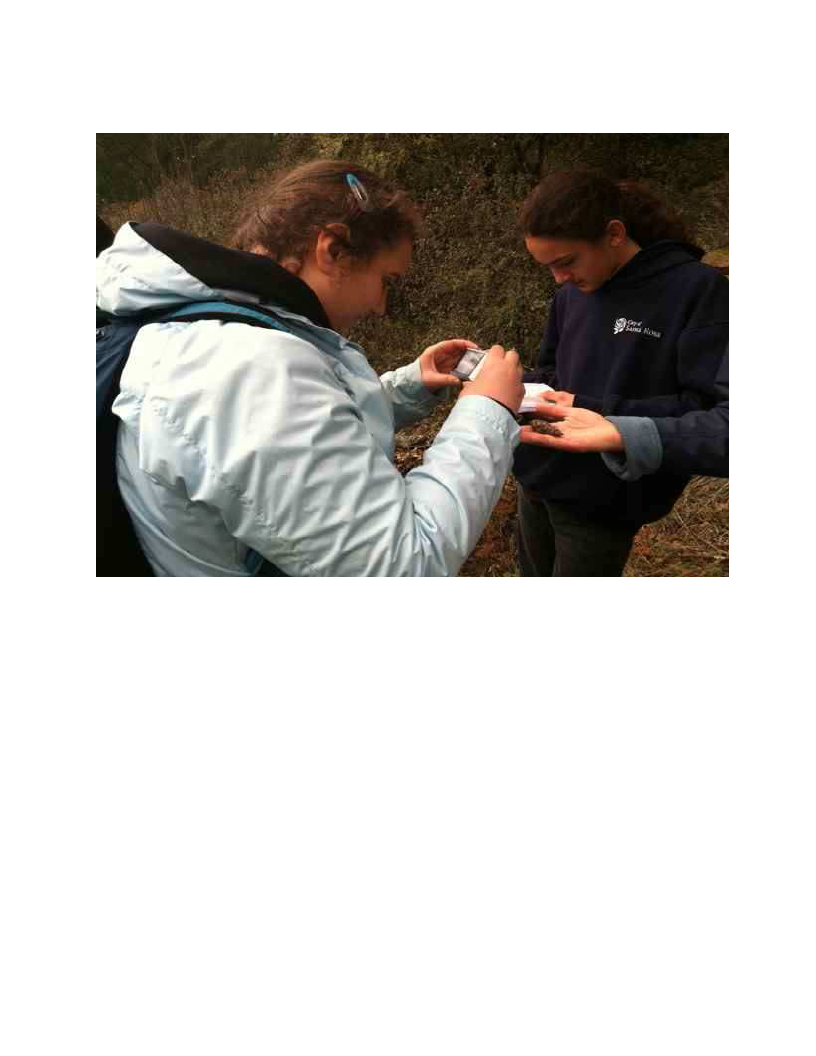
EDUCATING FOR BELONGING
57
include as many plants as possible.
Figure 1- Students participating in the field guide project at Pepperwood Preserve.
A student has found a seed pod of a plant and is photographing it. The other student is
consulting the field guide to attempt to identify the plant. Another student (not pictured) is
recording data about the picture to include in their field guide page for this plant. The
information includes physical observations (color, texture, location) and also any behavioral
adaptations the student can identify.
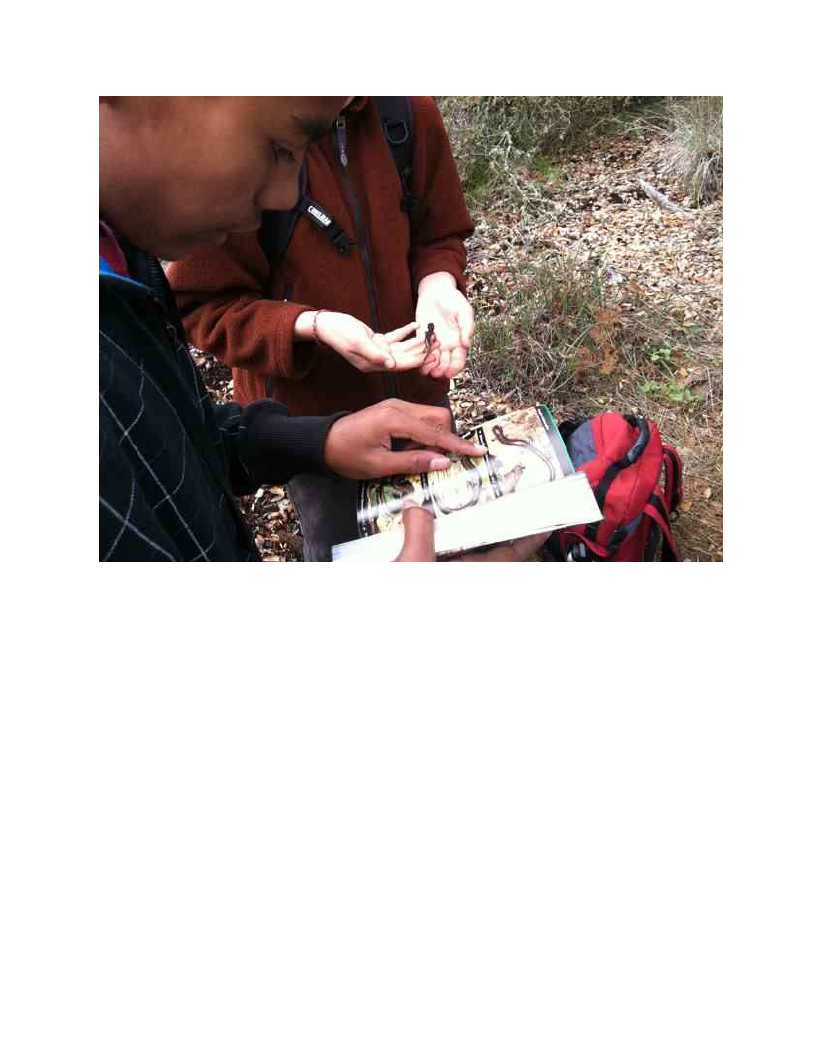
EDUCATING FOR BELONGING
58
Figure 2- In subsequent visits, some students became distracted and starting looking under logs
for salamanders and other creatures. When I came up upon their group they had only identified
three plants, and the interest of the group was waning around the plants. However, I allowed
them to use a reptile guide to identify the salamander, and they were deeply involved and
engaged in that task. They photographed it and planned to include it into the field guide.
This instance and others were recorded in my field notes and showed me that many students
were more engaged in the fauna of Pepperwood rather than just the flora.
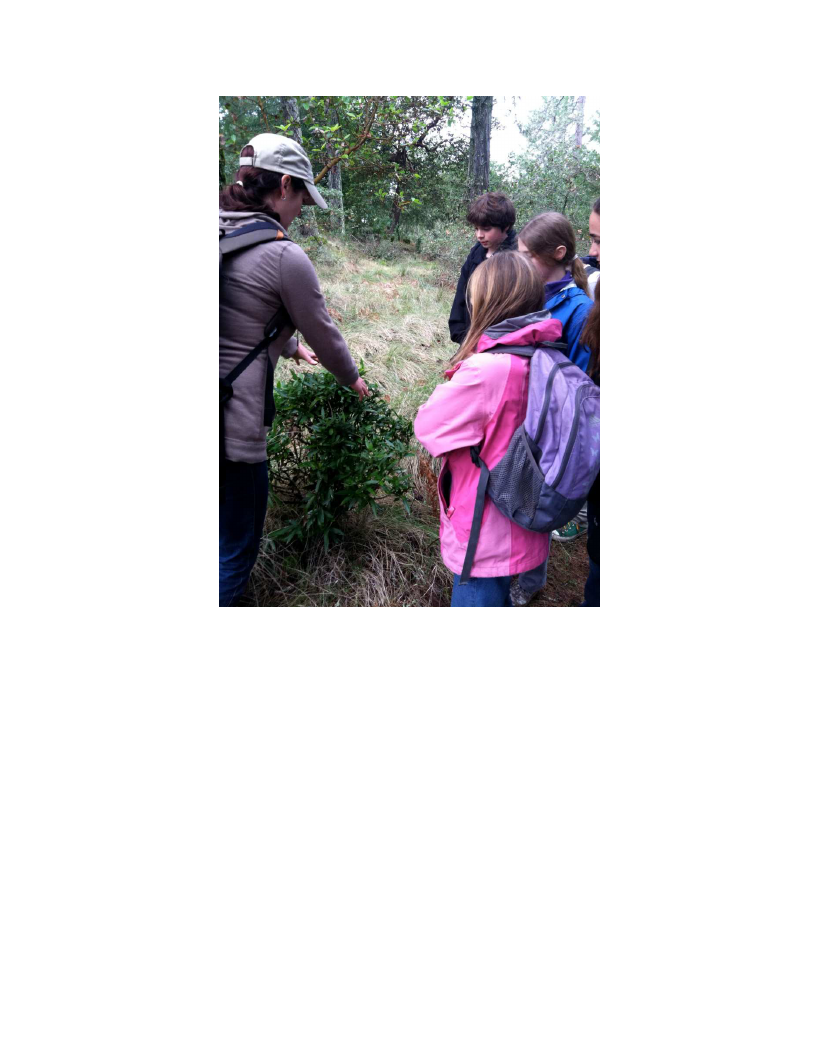
EDUCATING FOR BELONGING
59
Figure 3- This picture shows the staff scientist from Pepperwood Preserve pointing out a young
Pepperwood tree to a group of students engaged in the field guide project. There was a large
difference between the instances when the staff scientist worked with my students versus the
other excursions when my students worked only with field guides to identify plants.
Identification of plants was much more successful with the staff scientist there to help. Many
students were frustrated with the field guides we were working with, and they became a bit of a
hindrance for students in the later visits to Pepperwood Preserve.
.
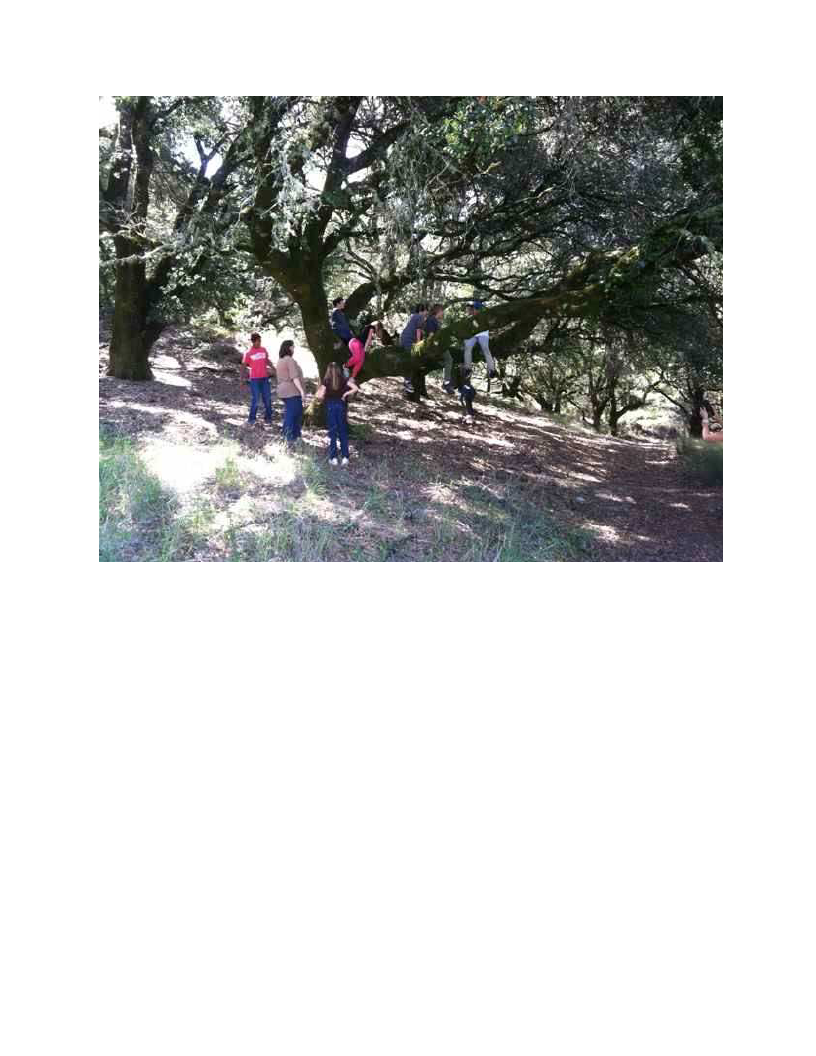
EDUCATING FOR BELONGING
60
Figure 4- The picture above illustrates a typical scene when the students were allowed free time
during a snack/water break or lunch. In multiple accounts in my field notes I recorded that the
most successful part of the project was the student interaction with the outdoor setting. Students
were very relaxed and had a positive attitude when we were at Pepperwood Preserve. Students
would find a spot and gather together just to enjoy the outdoor environment. I recorded that
during these sessions many of the classroom dynamics that I battle with were not present. An
example of this occurs in this picture, where many students who normally don’t spend time
together are peacefully sharing the outdoor space with one another. I recorded field notes that
supported positive interactions with their environment during many of the trips to Pepperwood
Preserve. One example:
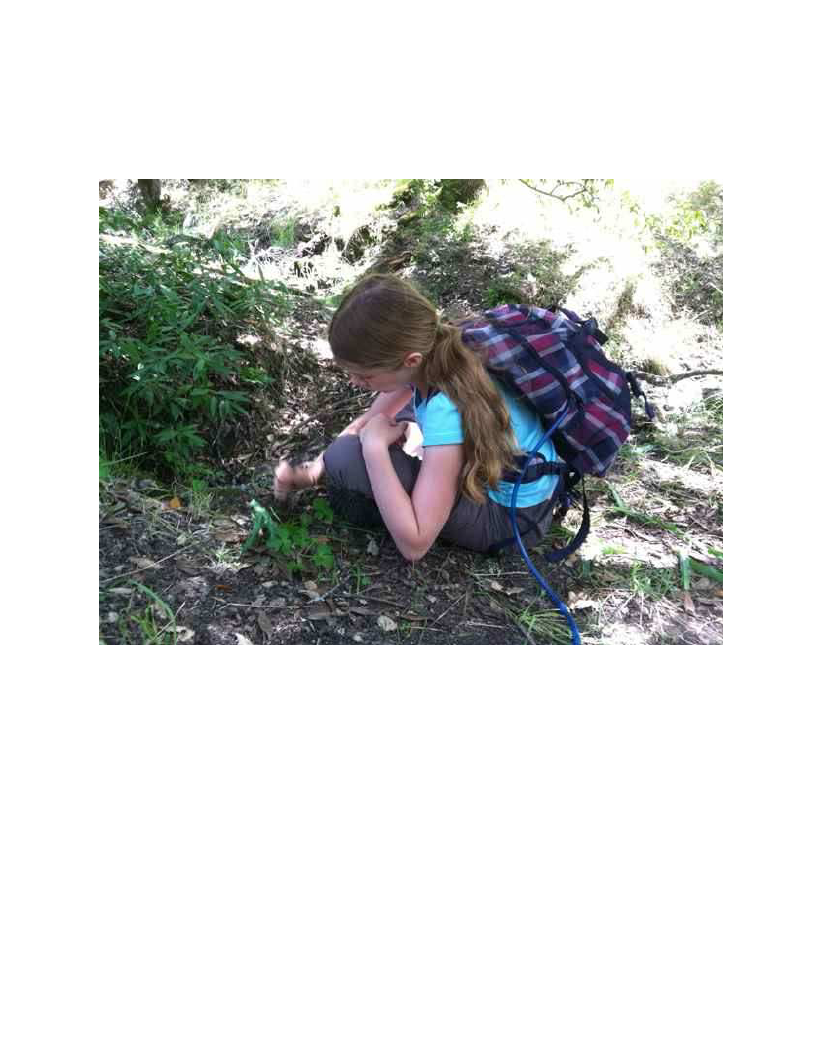
EDUCATING FOR BELONGING
61
When we got to the Bechtel house we stopped and had a snack. While we were eating, students
enjoyed the view and observed the clouds moving over the mountains and used binoculars to
spot cattle in the distance, as well as hawks and turkey vultures.
Figure 5- Here a student uses a makeshift native digging stick to dig up a specimen of wavy-leaf
soap root. After this student dug up the plant, she photographed it and closely examined the
parts. She brought it back to the classroom to test out making her own soap.
In the classroom.
After each field session students would return to the classroom for an hour-long block
focused on the field guide project. During these hour-long blocks, students were responsible for
uploading their photos on the class computers, identifying their plants, and researching
information for each plant for the field guide.

EDUCATING FOR BELONGING
62
I gathered many ethnobotanical resources for students to use once they had identified
their plants. Each student needed to identify the common name and then the scientific name of
each plant. Then, using the scientific name they searched through ethnobotany resources to find
how (or if) native peoples interacted with their specific plants.
This process was often challenging for students. I recorded many observations in which
students had difficulty understanding words used in the ethnobotany resources (such as inhalant,
vasodilator). Many students had to also look these words up, and some students became
frustrated quickly. Some students wanted to just look up the plant on Google and find
information about it. I made it mandatory to look up their plants in the books, and students
seemed to get frustrated and were more likely to get off-task.
Many of my notes from the classroom after hiking blocks include the words “off-task,”
“not engaged,” and “restless.” Upon reflection, I think the time of day and situation made these
classroom blocks more difficult than other normal blocks. Students were often exhausted after a
day of hiking and outdoor exploration. There were also instances where the physical condition
of the students seemed to affect their focus: They were extra hungry or thirsty later in the
afternoon. In addition, this project was labeled an extra credit project from the start so as not to
affect the results of my data. However, this status often led students to disregard the project in
these later afternoon blocks in favor of such things as talking to their neighbor.
In my notes I indicated the vast difference in engagement from the field to the classroom.
In the field at Pepperwood my notes included descriptors like: “high levels of curiosity, hands-on
engagement, sense of excitement.” In the classroom after these sessions I noted: “frustration
with resources, off-task behavior from students who have off-task tendencies, lots of off-topic
talking.” The two settings were stark in their level of engagement for students. It seemed as

EDUCATING FOR BELONGING
63
soon as they left the actual plants and Pepperwood Preserve they had a hard time staying focused
on the pictures they had taken.
Summary of observations and emerging themes.
As mentioned, there was a stark difference in student engagement in the two different
environments. Students were deeply engaged in their surroundings at Pepperwood Preserve.
When students returned to the classroom the level of engagement in the project dropped
significantly. However, each student completed a plant page for the field guide. I observed that
one of the driving forces for completion was because the field guide was to be donated to
Pepperwood Preserve for other students to use. This so-called higher purpose created a sense of
ownership for students. and many students seemed to finish their plant page so that they could be
a part of the project that was going to help other students.
I noted in my observations that my students who had specific learning struggles due to an
identified learning disability stayed focused in the project significantly more at Pepperwood than
in the classroom. At Pepperwood these students tended to take on the role of photographer or
sketcher so that they didn’t rely on their writing/reading ability. This seemed to make these
students feel included in a project that all their peers were engaged with on the same level. The
classroom work was challenging for these students because of the reading level of the
ethnobotany resources. This caused some of these students to disengage when I wasn’t directly
working with them.
I looked for signs of what I call “connection” and “belonging” to Pepperwood Preserve
among all the students and noticed that in subsequent visits students took pride in being able to
point out plants they could identify along the trail. Students also enjoyed being able to taste
plants like miner’s lettuce and young Douglas fir needles. I also observed that students appeared
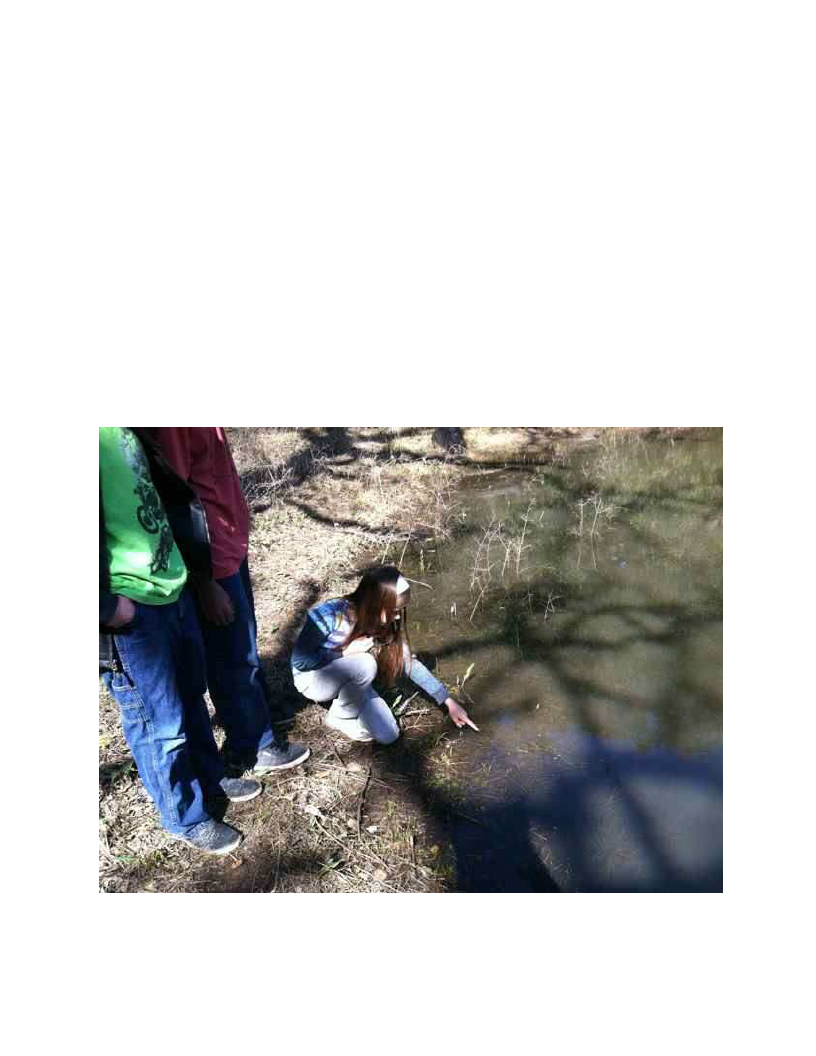
EDUCATING FOR BELONGING
64
extremely comfortable while outdoors on the trail. The students knew how to stay hydrated,
dress in layers, and eat appropriate snacks and lunches to stay energized. This level of comfort
appeared to create a sense of calmness while we were at Pepperwood. I would observe these
calm periods during free time when students would find a tree to climb and just “hang out,” as
they say. The overall attitude of the class was extremely positive during the outdoor
Pepperwood excursions. These experiences engaged the students in their surroundings and the
field guide project at the highest level. In the later visits to Pepperwood students seemed to take
more interest in learning about their surroundings instead of engaging in off-topic discussions
with their peers.

EDUCATING FOR BELONGING
65
Figure 6- In a subsequent visit to Pepperwood Preserve our group hiked out to a vernal pool,
and students had free time to explore the pool and its ecology. I was pleasantly surprised to see
that students did not congregate to talk about off-topic subjects. Instead, each student was
engaged with taking pictures of plants and creatures he or she found by the pond and calling me
over to point out the discoveries. Students were totally absorbed in Pepperwood’s environment
during our last visit.
In-class Interview
I chose to combine a conversational interview strategy with an interview guide. A
conversational interview is an informal, open-ended approach to interviewing (Patton, 2002).
This approach offers flexibility to determine questions as the conversation flows naturally and to
feed off the answers of participants. However, I also chose to guide the interview using
questions to keep the conversation focused and directed. Here are the questions and student
responses posed to students during the one-hour classroom interview.
1. Do you like learning outside or inside better? Why?
All students agreed that they liked to have the experience of learning outdoors. Many
students indicated that doing work outside helped them stay focused because of “fresh air,
variety of scenery and environments, more comfortable lighting and seating, calmer, quieter.” A
few students offered that they enjoyed learning outside for this project because “it was in
context” or “a real-life situation.” Some students offered that changing up the classroom
environment “is fun” and “keeps it interesting.” Another student said that outside “there is so
much square footage and space to think and write.” Two students said that the latter visits to
Pepperwood were difficult for them because of their allergies, and one student said she had a
hard time getting comfortable outside because she couldn’t find a place to sit. Overall, this

EDUCATING FOR BELONGING
66
question indicated to me that this specific class really enjoys being outside in the field. This
enjoyment of the environment helped the students to engage in the field guide project deeply
while we were at Pepperwood.
2. What does it mean to feel connected to a place? What places do you feel connected to? Why
do you think you feel that connection?
This question inspired many anecdotal stories from students about their own personal “place.”
A few students spoke of a local beach where they play in the water and climb on the dunes.
Other students mentioned the local watershed system of the Russian river. Most students
mentioned a place that was in relative proximity to their house and a place they frequently visit.
All students indicated that the place made them feel calm and happy. A few students indicated
that their “place” is a place where they reflect and where they can be alone. One student said:
There is a place behind my house that has trees and it feels very peaceful. I go to spend time
alone there and to think. When discussing the concept of connection to a place, all the students
suggested that the place needs to be visited frequently, over a long period of time and offer some
relaxing/peaceful space.
3. Did the project help you to feel a connection to Pepperwood Preserve? If so, what does the
connection feel like?
All the students except two indicated that they feel a connection to Pepperwood Preserve. The
students that have this connection remarked that it felt “positive” or “peaceful” to have this
connection. Some students indicated that feeling a connection to Pepperwood Preserve felt a
sense of excitement and an urge to further explore. One of the students who answered no said:
“I don’t necessarily feel a connection to Pepperwood itself, I just feel a connection to being
outside in general.”

EDUCATING FOR BELONGING
67
4. What do you want to learn more about after the Pepperwood project?
Many students said that they would like to learn more about ethnobotany and that learning the
edible and medicinal plants of Pepperwood incited an interest in this topic for them. Some
students said that they would like to learn more about the fauna of Pepperwood, specifically
“bugs.” Most students indicated they would like to learn more about plants they can eat and how
to prepare them.
5. During this year, did your connection to Pepperwood change?
Ten students indicated that yes, their connection to Pepperwood changed and that it felt
“deeper” or they felt “more connected.” One student offered:
“We’ve been going to Pepperwood at this school for a few years and after learning the plants
and some of their uses I feel more connected because I feel like I understand the things that live
there more.”
One of the students said the connection she felt to Pepperwood did not change over the course of
the year, but “there is a connection there.” Overall in the class it appears that the feeling of
connection to Pepperwood is a very individualized process, but that learning the names/uses of
plants did help students to become more familiar with the environment they encountered. This
familiarity seemed to invoke a small change in a perception of connection to Pepperwood.
6. What does it mean to feel like you belong to a place?
After discussing what students thought it meant to feel “connected” to a place, I wanted
to see what students thought feeling a sense of “belonging” felt like to a place. Almost all
students said that feeling “connected” and feeling a “sense of belonging” were similar but there
were a few differences. Most students said that when you “belong” to a place you “try to help it”
or “try to contribute.” Another student offered that when you feel like you belong to a place, you

EDUCATING FOR BELONGING
68
“feel appreciated, like your helping.” Another student said: “When you belong to a place you
feel like you’re needed and you feel like you’re at home.” One student used the term a”
symbiotic relationship.” Other responses included: “Feeling you need it” and “ you want to be
there” and “to be at home, comfortable.”
The discussion then turned to the question: Do humans belong in nature? I was surprised to
witness the class ask themselves this question and then discuss their ideas together. One student
offered: “We are nature! We are made up the same thing as trees, as atoms.” Then another
student offered, “If we’re all made up of atoms, then we belong on a molecular level!”
During this part of the interview, the excitement in the room rose and the students started talking
to each other at once. After the discussion of the molecular connection between themselves and
nature, the students were excited and seemed to have a feeling of accomplishment. I asked the
group if they enjoyed having these “cosmological conversations.” The class agreed and almost
all the students asked to have more time later to discuss their ideas. One student offered that he
likes thinking about “this stuff… but the conversation can feel awkward because I’ve never had
it.”
8. What was your favorite part of the project?
All the students agreed as a group that their favorite part of the project was “going there.”
Each student seemed to enjoy being at Pepperwood for different reasons, but they all agreed that
being outside for the project and hiking and exploring Pepperwood was their favorite part of the
project.
Summary and analysis of interview results.
The most significant parts of the interview for this case study came when students
discussed what it meant to them to feel like they belong to a place. On their own, the group

EDUCATING FOR BELONGING
69
decided that when someone belongs to a place there is a feeling of responsibility and a sense of
stewardship. The purpose of the Pepperwood field guide project was to donate the field guide so
that other students who visit the preserve can identify and learn about the flora. It is possible that
because of this higher purpose students actively engaged in learning about the flora and
ethnobotany of the place. Then, after the project was completed, many of the students remarked
that their feeling of connection to Pepperwood increased.
The interview indicated that a feeling of connection to a place is a very individuated
process unique to each student. However, all the students remarked that the places they felt
connected to made them feel peaceful and calm. All the students suggested that their place they
felt connected to they had visited frequently and knew intimately. This information has
important implications for this study. In order to educate these students to feel connected to their
place, this case study suggests allowing students to experience extended periods of time to come
to know the place intimately. Also, these students indicated the importance of facilitating a
peaceful and calming environment with students in a particular place to help foster a sense of
connection.
It appears from this case study population that a perception of connection precedes
belonging. Most of the students associated a perception of belonging to a place with
stewardship: “doing something to help it.” It is possible that in order for students to experience
this drive toward stewardship of a place that is the personification of a feeling of belonging, they
must first experience a connection to that place. Again, from this specific case it appears that
extended exposure to a place creates a feeling of connection which can then develop into a
feeling of belonging.

EDUCATING FOR BELONGING
70
Discussion and Conclusion
This case study sought to determine the effect of a place-based educational project on
students’ sense of connection and belonging to nature. I wanted to determine how students
experience feeling a connection to a place, and how a feeling of belonging to a place may arise n
my case population. The three questions I began my research with were:
1. How do these students define a sense of place and a sense of belonging?
2. Does understanding local flora affect students’ sense of belonging?
3. Can learning about place through experience in nature, research into ethno-
botanical usages of local plants, basic botany, service learning and photography
incite a sense of belonging in my students?
The survey data suggested that my student population felt connected to nature from the
beginning of the project. There was little difference in the post survey data after the project in
how students perceived their connection to nature. The pre and post survey determined that
students knew many more plants after the field guide project than before the project. One of the
most significant suggestions of the survey data is that students tended to feel more likely to
engage in a career in “saving the earth” after the project. This demonstrated interest in
stewardship as a theme that arose when students began to discuss in the interview how they came
to feel like they belong to a place.
The students in the case expressed that they felt a connection to a place (a local beach,
backyard nature) in their life, and that connection was characterized by a feeling of calmness and
an extended history visiting it. A sense of belonging to a place differed from a connection to a
place in the students’ perception. I discovered that a feeling of connection to a place preceded a

EDUCATING FOR BELONGING
71
sense of belonging to a place for these students. Stewardship arose as the key defining
characteristic of the experience of belonging to a place. The student definitions of belonging to
place indicate that doing something to “help it” is a strong characteristic of their perception of
belonging. There is a correlation between this theme that arose in the interview and the PBE
project’s service aspect: creating the field guide so other students can use it. Incorporating an
altruistic element to the project seemed to increase the student’s connection to Pepperwood.
This is also consistent with the survey results that showed an increase in the amount of students
who said in the future they would like to work in some sort of career to “save the earth.”
A surprising result of asking students about the concepts of place and belonging was the
organic uprising of the “cosmological questions.” When discussing with students about whether
or not humans belong in nature, they began to discuss how “we’re all made up of the same stuff,
we originated in stars.” This conversation appeared exciting and engaging for students and
added a dimension to the interview that I believe to be significant.
As a place-based educator, I am seeking to create more than just a sense of place but
rather what I refer to as a sense of belonging in students. It appears that these cosmological
questions appear to be part of the process for early adolescent students to come to feel as if they
belong to a place. I think this can be significant for place-based educators. The goal of many
PBE educators in creating a sense of place in students is to foster the trait of stewardship. In
order to fully realize this goal, it is possible that place-based educators need to involve students
in asking these “cosmological questions” about belonging to nature. The obvious engagement of
my students during this part of the interview showed the excitement and opportunity for
educators to address these questions when looking to educate for belonging. The work of

EDUCATING FOR BELONGING
72
Thomas Berry and Joseph Cornell demonstrate this by helping participants experience the
interconnectedness of the natural world.
A Framework for Educating for Belonging
Overall, the concept of educating for belonging crystallized during this case study.
Educating for belonging is more than helping students create a sense of place through PBE,
nature exploration and study. Stewardship of the land is a key defining characteristic of
educating for belonging. Educating for belonging utilizes the connection to a place that comes
with a strong sense of place and builds upon it utilizing stewardship. In order to focus on
educating for belonging, students must be inspired by their connection to a place to act with
altruistic motivation. Finally, I believe the incorporation of cosmology to be a missing piece
currently present with many PBE programs. Cosmology asks students to seek understanding of
the human role in nature and the universe and its interconnectedness to all things. This final
aspect fulfills the biophilic and eco-psychological urge that many believe underpins the human
experience. In many cultures, the cosmological journey begins in the early adolescent child. I
believe that in order to create a perception of belonging to a particular place the cosmological
aspect of interconnectedness to the universe needs to be addressed.

EDUCATING FOR BELONGING
73
place-based
education
Educating
for
Belonging
sense of
place
stewardship
cosmology
Figure 1- A basic framework for educating for belonging.
Based on the above framework, PBE educators can add elements to their programs to
enhance the experience of belonging for students. Place–based educators can incorporate
stewardship elements into their educational programs to build upon students’ sense of place. In
many schools and organizations this can take the form of service learning. Service learning
embeds the topic being studied in context by participating in community or environmental-based
service. PBE educators can enhance curriculum focused on deepening the students’ sense of
place by adding service learning aspects to projects. This active, experiential and relevant aspect
of curriculum is a key to educating students for belonging to their local place. Also, having a
higher purpose for projects/curriculum is an extremely effective motivator for this early
adolescent age group.
One surprising aspect of the results was the appearance that learning the names and
usages of the plants at Pepperwood Preserve had little to do with creating a sense of place for
these students. Perhaps it is because of their developmental stage, but most students indicated

EDUCATING FOR BELONGING
74
that they felt a sense of place at Pepperwood because of the amount of time they spent there, not
that they knew the names of the plants there. This has implications for the PBE educator. In
many PBE programs the focus is on learning names of plants through natural history studies
during weeklong visits to a natural space. My case study suggests that is not necessarily the
curriculum content that creates the sense of place for students, but the time and frequency spent
at the place itself. This is supportive of the constructivist view of learning for students: each
student generates his or her own sense of place through continued exposure to the natural area.
This could be observed as a constructivist view of a sense of place. However, I believe (as Sobel
noted in 2005) that only relying on this constructivist view can be dangerous for students who
are steeped in media culture. Most students need facilitation in outdoor natural spaces in order to
feel comfortable and thus develop a sense of place. However, this study suggests that there is
not a one-size-fits-all curriculum framework or content to facilitate the development of sense of
place in students. The students in this case study seemed to respond best when they could
choose how to express their learning of plants at Pepperwood Preserve. Perhaps, if this project
were repeated I would allow students to use interdisciplinary means to express the natural history
of Pepperwood, but I would not limit the field guide solely to the study of the plants. I would
include geology, fauna, human history, etc. Including other subjects in the field guide could
engage students who are not interested in plants or ethnobotany. Including other subjects also
allows for a more student-driven approach to the project, which has been shown to be successful
curriculum design technique for this age group.
PBE educators can look to Brian Swimme, Joseph Cornell, Charlene Spretnik as
contemporary authors to help guide cosmological facilitation for students in nature. Each
individual student will have his or her own unique journey toward experiencing the unfolding of

EDUCATING FOR BELONGING
75
the cosmological journey in nature. However, the PBE educator can become skilled in helping
facilitate the process for students. Local native tribes offer a great perspective on incorporating
cosmology into the study of nature and place. A few organizations provide students with deep
experiences with nature (www.trackersbay.com) and at the same time facilitate a rites of passage
experience for early adolescent students. This is a significant marriage of a sense of place and
cosmological deepening.
Challenges for the PBE educator.
First and foremost, many teachers who are looking to implement a PBE project that
educates for belonging are up against a public education system that relies on a lecture and test
format and holds students and teachers accountable by test scores. The challenges for teachers to
incorporate a project similar to this are many; however, many of these challenges are not
insurmountable. Careful curriculum planning is necessary in order to incorporate required state
standards into a project like the field guide. Probably even more challenging is access to nature
for students, mostly how to transport them to a local preserve in order to have that continued and
consistent visitation that precedes the development of a strong sense of place. Many schools
utilize what they call nearby nature, local parks and vacant school lots that can be transformed
into an outdoor learning laboratory. However, for this particular project it was necessary to
travel to a local preserve numerous times throughout the school year. Thus, I relied on parent
volunteer drivers, and it was a challenge to find parents willing and available for the task.
Busses for fieldtrips are often extremely expensive. However, this is a good fundraising
opportunity for a parent group and for solicitation of support from local businesses.
Another challenge of implementing a PBE project that looks to educate for belonging lies
in the actual compartmentalization of subjects within the school. Elementary classes are

EDUCATING FOR BELONGING
76
interdisciplinary with one teacher managing the curriculum, but middle and high school
classrooms are usually compartmentalized by subject. The classroom where this case study
occurred, an interdisciplinary middle school class with multiage students ranging from age
eleven to fourteen. A project of this type lends itself well to a classroom that is structured in this
way. However, with teacher collaboration and planning an interdisciplinary PBE project can be
well executed between groups of teachers at middle or high schools looking to educate for
belonging. In fact, it is possible that the addition of other teachers with varied talents can greatly
enrich the project and its outcomes.
A challenge most PBE educators face when looking to create or implement curriculum is
meeting state guidelines and standards. A project like the field guide takes much classroom time
and time spent in the field. The amount of time spent in the field at the preserve was a key factor
in the success of the project and the development of a sense of place in students. However, this
can be very challenging for teachers who have a long list of standards to cover throughout the
year. It is possible to incorporate many state standards into a project like this; it just takes some
planning and creativity. For example, a key standard in California for 7th graders is expository
writing. I met this goal using English standards and science standards through this project. I
also incorporated lessons about the citation of sources for students that met another state
language arts standard. This project focused on ethnobotany, so it covered geography standards
relating to the influence of geography on native peoples. I also included elements of arts
standards through the use of sketches and photography. Other ideas to meet state standards in
this age group are:
• Students write letters to the local preserve and the local paper discussing land use issues.

EDUCATING FOR BELONGING
77
• Students write a children’s book about the preserve for the naturalists to use with student
groups.
• Create an art show using student-generated watercolors or photographic images of the
preserve and donate the money to the education fund at the preserve.
• Visit a local government meeting and mathematically examine with students the budget
for local natural spaces.
• Have students prepare short speeches on the importance of funding for access to nature
programs and present them at a local monthly meeting of city board of supervisors.
The results of this case study suggest that the curriculum content of the PBE project is less
important, but the authentic, real-world and stewardship-based aspect of the curriculum is the
important factor to maintain. This study also suggests the extended visits and time period spent
in nature was of key importance to the development of a sense of place and a sense of belonging.
Meaningful relationships with local municipalities and land management organizations
are essential for creating a well-designed PBE project that incorporates the elements of educating
for belonging. This project was built upon a relationship that was cultivated between the school
and the staff at the preserve. Because of this relationship it was possible to incorporate an
authentic task of stewardship by creating the field guide for other students that visit the preserve
to use.
Further Research
Further research is needed to determine the most effective ways to educate students for a
sense of belonging to their place. Here are some suggestions based upon the results of this case
study:

EDUCATING FOR BELONGING
78
• An effective place to start would be to document a rites of passage, nature immersion
program to compare and evaluate the educating for belonging framework that arose
during this case study.
• This case study was limited to a single school year, so a study that follows students
participating in PBE over time would be significant to determine dominant trends.
• This case study focused on a small population of students, so I would like to examine
how the educating for belonging framework would apply to different settings and
demographics- from the inner city to the rural towns.
• Also significant would be to examine academic achievement utilizing the educating for
belonging framework.
Place-based education and the development of a sense of belonging in students is a subjective
and individuated process. Qualitative studies are best used to describe the experiences of
students participating in PBE programs. However, in order to encourage the continued
acceptance of PBE amongst administrators and politicians it is imperative that quantitative
studies of PBE continue to be undertaken.
Final thoughts on research questions
1. How do these students define a sense of place and a sense of belonging to nature?
Students in this case study reported that development of a sense of place spurred from
repeated visits to the nature preserve over long periods of time. These students indicated that a
sense of belonging occurs when they feel they are needed and doing something to help their local
natural places. The addition of cosmology discussions and stewardship experiences in the
context of PBE projects can support early adolescent students to experience a sense of belonging.
This case study created a framework for educating for belonging, which uses place-based

EDUCATING FOR BELONGING
79
education with stewardship elements to create a sense of place, and cosmology to orient students
to their place in the universe.
2. Does understanding local flora affect students’ sense of belonging?
The results from this case study indicate that it was not the curriculum content based on local
flora that contributed to students’ sense of belonging. The data suggest that it was the multiple
visits to the preserve over a long period of time that facilitated the development of a sense of
place for students. The incorporation of the stewardship aspect of the PBE project did more to
develop a sense of belonging in students than the actual curriculum content itself.
3. Can learning about place through experience in nature, research into ethno-botanical usages
of local plants, basic botany, service learning and photography incite a sense of belonging in my
students?
Again, the data from this case study suggest that this population of students experienced a
feeling of belonging most from the stewardship element of the PBE project. The experience and
time at the preserve was a defining factor in their development of a sense of place. The
stewardship aspect of the project moved students from beyond a sense of place toward a sense of
belonging by making students feel they were needed and doing something to help. This altruistic
element of the project seemed to deepen students’ sense of belonging to the preserve and
suggested that the curriculum content was of less importance than the altruistic experience.
Finally, further research is needed to determine how PBE educators can educate for belonging
across multiple ages and demographics.

EDUCATING FOR BELONGING
80
References
Applefield, J. M., Huber, R., & Moallem, M. (2001). Constructivism in Theory and
Practice: Toward a Better Understanding. High School Journal, 84(2). Retrieved from:
http://web.ebscohost.com.ezproxy.prescott.edu/ehost/detail?vid=6&hid=8&sid=a
7b522f62c364773b1f978a8fa792261%40sessionmgr10&bdata=JnNpdGU9ZWhv
c3QtbGl2ZQ%3d%3d#db=aph&AN=4113370.
Bakalar, N. (2009). TV watching in youth tied to depression later. New York Times. Retrieved
from: http://www.nytimes.com/2009/02/10/health/10iht-snvital.1.20077893.html.
Beane, J. A. (1997). Curriculum integration: Designing the core of democratic education.
New York, NY: Teachers College Press.
Bowers, C. A. (2005). The False promises of constructivist theories of learning. New York,
NY: Peter Lang.
Bravmann, L. (2000). Developing self and spirit. In W. Pinar (Series Ed.), Cultures of
curriculum (pp. 73-94). Mahwah, NJ: Lawrence Erlbaum.
Buzzell, L. & Chalquist, C. (2009). Ecotherapy: Healing with nature in mind. San
Francisco, CA: Sierra Club Books.
Chawla, L. (1998). Significant life experiences revisited: A review of research on sources of
environmental sensitivity. The Journal of Environmental Education, 29(3), 11- 21.
Chawla, L. (2006). Research Methods to Investigate Significant Life Experiences: Review and
Recommendations. Environmental Education Research, 12(3-4), 359-374.
Chawla, L. & Escalante, M. (2007). Student gains from place-based education. Fact Sheet #2.
Denver, CO: University of Colorado at Denver. Retrieved from:
http://www.promiseofplace.org/research_attachments/Chawla2007StudentGainsfromPBE

EDUCATING FOR BELONGING
81
.pdf
Cook, L. W. (2011). Developing a sense of place: Examining educator practice in place-based
education. (Master’s Thesis). Retrieved from Proquest.
Creswell, J. W. (2009). Research design: qualitative, quanitative and mixed methods
approaches. (3rd edition). Thousand Oaks, CA: Sage Publications.
Creswell, J. W. (2013). Qualitative inquiry and research design: Choosing among five
approaches. Thousand Oaks, CA: Sage Publications.
Dellinger, D. (1997). Universe/earth/human: Reflections on the New Cosmology. Prescott,
AZ: Prescott College.
Dewalt, K. M. & Dewalt, B. R. (2002). Participant observation: A guide for fieldworkers.
Walnut Creek, CA: Altamira Press.
Dewey, J. (1938). Experience and education. Indianapolis, IN: Kappa Delta Phi.
Evans, G. W., & McCoy, J. M. (1998). When buildings don't work: The role of architecture in
human health. Environmental Psychology 18, 85–94.
Gruenewald, D. A. & Smith, G. A. (2008). Place-based education in the global age: Local
diversity. New York City: Lawrence Erlbaum Associates.
Hagell, A. (2012). Changing adolescence: Social trends and mental health. Chicago, IL: The
Policy Press.
Hagerty, B. M., Williams, R. A., Coyne, J. C., & Early, M. R. (1996). Archives of
Psychiatric Nursing, 10(4). Retrieved from:
http://www.ncbi.nlm.nih.gov/pubmed/8799050.
Hagerty, B. M., & Williams, R. A. (1999). The effects of sense of belonging, social support,
conflict, and loneliness on depression. Nursing Research, 48(4), 215-219.

EDUCATING FOR BELONGING
82
Henderson, K. A., & Baileschki, M. D. (2002). Evaluating leisure services: Making
enlightened decisions. State College, PA: Venture.
Kellert, S. R. (1998). A National Study of Outdoor Wilderness Experience. New Haven, CT:
Yale University. Retrieved from:
http://www.nols.edu/resources/research/pdfs/kellert.complete.text.pdf
Kim, H. B. & Fisher, D. L. (1999). Assessment and Investigation of Constructivist
Science Learning Environments. Research in Science & Technological Education
17(2). P. 239. Retrieved from:
http://www.informaworld.com/smpp/content~db=all~content=a746602288.
Likert, R. (1932). A technique for the measurement of attitudes. Archives of Psychology 22,
140.
Louv, R. (2008). Children and the success of biophilic design. In S. R. Kellert, J. H.
Heerwagen & M. L. Mador (Eds.), Biophilic Design: The theory, science and practice
of bringing buildings to life (pp. 205-212). Hoboken, New Jersey: John Wiley & Sons.
Louv, R. (2008). Last child in the woods: Saving our children from nature deficit disorder.
Chapel Hill, NC: Algonquin Books.
Mack, N,, Woodsong, C., Macqueen, K. M., Guest, G., & Namey, E. (2005). Qualitative
Research Methods: A Data Collector’s Field Guide. North Carolina: Family Health
International.
Merriam, S. B. (1998). Qualitative research and case study applications in education. San
Francisco, CA: Jossey-Bass.

EDUCATING FOR BELONGING
83
National Dissemination Center for Children with Disabilities (NICHCY). (2010). Retrieved
from: http://www.nichcy.org/Laws/IDEA/Pages/module1.aspx
National Institute of Mental Health (NIMH). (2013). Depression in Children and Adolescents
(Fact Sheet). Retrieved from: http://www.nimh.nih.gov/health/publications/depression-
in-children-and-adolescents/index.shtml.
Pastor, P. N. & Reuben, C.A. (2008). A Potential Treatment for Attention-Deficit/Hyperactivity
Disorder: Evidence from a National Study. Vital Health Statistics, 10(237), 1-14.
Patterson, K. (2004, May 5). Green power: Studies find natural settings help both kids and
adults shrug off stress. The Dallas Morning News. Retrieved from:
http://www.signonsandiego.com/uniontrib/20040505/news_lz1c5green.html.
Patton, M. Q. (2002). Qualitative research and evaluation methods. (3rd ed.) Thousand Oaks,
CA: Sage Publications.
Planet Ark. (2011). Climbing trees: Getting Aussie kids back outdoors. Retrieved from:
http://treeday.planetark.org/about/health-benefits.cfm.
Powers, A. P. (2004). An Evaluation of Four Place-Based Education Programs. The Journal of
Environmental Education, (35)4. Retrieved from:
http://www.peecworks.org/PEEC/PEEC_Reports/002A7631-
007EA7AB.0/Powers%20JEE%20article.pdf
Pranis, E., & Duffin, M. (2009). Engaging young adults in a sustainable future: Strategies for
national parks and other special places. Woodstock, VT: National Park Service
Conservation Study Institute and Shelburne Farms. Retrieved from:
http://www.peecworks.org/.
Pretty, J. (2002). Agri-Culture: Reconnecting People, Land and Nature. London: Earthscan.

EDUCATING FOR BELONGING
84
Primack, B. A., Swanier, B., Georgiopoulos, A. M., Land, S. R., Fine, M. J. (2008).
Association Between Media Use in Adolescence and Depression in Young Adulthood: A
Longitudinal Study. Arch Gen Psychiatry, 66(2). Retrieved from:
http://archpsyc.jamanetwork.com/article.aspx?articleid=210196
Pyle, R. M. (2008). No child left inside: Nature study as a radical act. In D. Gruenewald & G.
Smith (Eds.), Place-based education in the global age: Local diversity (pp. 155-172).
New York City: Lawrence Erlbaum Associates.
Rideout, V. J., Foehr, U. G., & Roberts, D. F. (2010). Generation M2: Media in the lives of 8-
18- year olds. Kaiser Family Foundation. Retrieved from:
http://www.kff.org/entmedia/mh012010pkg.cfm.
Robinson, L. (2009). Psychotherapy as if the earth mattered. (L. Buzzell & C. Chalquist, Eds.)
In Ecotherapy: Healing with nature in mind (pp. 24- 30). San Francisco, CA: Sierra
Club Books.
Roszak, T. (1995). Ecopsychology: Restoring the earth, healing the mind. San Francisco, CA:
Sierra Club Books.
Rebhorn, T., & Küpper, L. (2007). Introduction to evaluation: Building the legacy: IDEA
2004 training curriculum. Washington, DC: National Dissemination Center for Children
with Disabilities. Retrieved from: www.nichcy.org.
Relph, E. (1976). Place and Placelessness. London: Pion.
Ryden, K. C. (1993). Mapping the invisible landscape: Folklore, writing and the sense of
place. Ames, IA: University of Iowa Press.
Schnuit, L. (2006). Using Curricular Cultures to Engage Middle School Thinkers. Middle
School Journal, 38(1). Retrieved from:

EDUCATING FOR BELONGING
85
http://www.nmsa.org/Publications/MiddleSchoolJournal/Articles/September2006/Article
1/tabid/1013/Default.asp.
Seidman, I. (1998). Interviewing as qualitative research: A guide for researchers in education
and the social sciences. (2nd ed). New York: Teachers College Press.
Smith, G.A. (2002). Place-based education: Learning to be where we are. Phi Delta Kappan,
83(8).
Sobel, D. (2004). Place-based education: connecting classrooms and communities. Great
Barrington, MA: Orion Society.
Sproull, N. D. (2004). Handbook of research methods: A guide for practitioners and students in
the social sciences. (3rd Ed.). New Jersey: The Scarecrow Press.
Steadman, R. C. (2003). Is it really just a social construction? The contribution of the physical
environment to sense of place. Society and Natural Resources, 16, 671-685.
Swimme, B. (1996). The Hidden Heart of the Cosmos: Humanity and the new story. New
York: Orbis Books.
Taylor, A. F. & Kuo, F. E. (2008). Children With Attention Deficits Concentrate Better After
Walk in the Park. Journal of Attention Disorders, 25. Retrieved from:
http://www.peecworks.org/.
Wells, N. M. & Lekies, K. S. (2006). Nature and the life course: Pathways from childhood
nature experiences to adult environmentalism. Children, Youth and Environments, 16(1).
Retrieved from: http://www.colorado.edu/journals/cyc.
Wiggins, G. P. & McTighe, J. (2005). Understanding by Design. Alexandria, VA:
Association for Supervision and Curriculum Development.

EDUCATING FOR BELONGING
86
Wilson, E. O. & Kellert, S. R. (1993). The biophilia hypothesis. Washington D. C.: Island
Press/Shearwater Books.
Wineburg, S. & Grossman, P. (2000). Interdisciplinary Curriculum: Challenges to
implementation. New York, NY: Teachers College Press.
Woodhouse, J., & Knapp, C. (2000). Place based curriculum and instruction. (ERIC Document
Reproduction Service No. EDO-RC-00-6).
Yin, R. K. (2009). Case study research: Design and method. (4th ed.). Thousand Oaks, CA:
Sage Publications.
Zelezny, L. (1999). Educational interventions that improve environmental behaviors: A meta-
analysis. Journal of Environmental Education, 31(1), 5-14.

EDUCATING FOR BELONGING
87
Appendix A
Survey- Pre and Post
Name _________________________________________________________________
1.Can you name any local plants growing naturally either near your home or around our
schoolyard? YES or NO (circle one)
If so, name as many as you can in the space below.
______________________________________________________________________________
______________________________________________________________________________
______________________________________________________________________________
______________________________________________________________________________
________________________________________________
2. Have you ever used any local plants for medicinal and or cooking purposes?
YES or NO (circle one) Which ones?
________________________________________________________________________
________________________________________________________________________
______________________________________________________________________________
__________________________________________________________________
3. Use this scale to answer the following questions:
1--------Strongly disagree
2--------Disagree
3--------Neither agree nor disagree
4--------Agree
5--------Strongly agree
a. I enjoy learning about local plants. ___________
b. I think preserving the earth involves understanding local plants. ___________
c. Local plants are the foundation to the local ecosystem. __________
d. I feel comfortable outside exploring nature. _________
e. Understanding the names and uses of plants is important to me. _________
f. Understanding the names of plants helps me feel connected to nature. ____________
g. I feel very connected to the natural world. _________
h. In the future, I would like to work in a profession that can help save the earth.
__________

EDUCATING FOR BELONGING
88
Appendix B
The Plants of Pepperwood Preserve:
Plants and People
Village Charter School 6th-8th grade class
Mrs. Nancy Carter
2012-2013

EDUCATING FOR BELONGING
89
Acknowledgements and notes from the authors
Dear reader,
This project was completed by the 6th-8th grade class at the Village Charter School in Santa Rosa,
CA. The purpose of this guide is to help identify plants while you visit Pepperwood. We
thought that identifying plants was not enough, we wanted to learn more about how people, both
past and present, interact with these plants. We learned a lot, and hope you do too.
Sincerely,
Mrs. Carter’s class
2011-2012

EDUCATING FOR BELONGING
90
Wavy Leaf Soap …………...….….…………………………………………….………....4
Serviceberry………………………….........…………………..…………..…….…..…….5
Pacific Sanicle, Snakeweed…………………………………………………………….....6
Wood Strawberry……………………………………………………………………….....7
Maidenhair fern ……………………………………………..…………..………………...8
California Polypody fern……..…………………………………………………..………..9
California bedstraw ………………………..………………………………………..…10
Sticky Monkey Bush ……………………………………………………………………11
Redwood Sorrel…………………………………………………………………………..12
California Hedgenettle…………………………………………………………………....13
Orange Larkspur………………………………………………………………………….14
Ladyfern…………………………………………………………………………………..15
Pathfinder plant…………………………………………………………………………...16
Douglas Iris……………………………………………………………………………….17
Bluedicks, Wild Hyacinth………………………………………………………………...18
Miner’s Lettuce ………….……………………………………………………………....19
Goldback Fern…………………………………………………………………………….20
Western Sweet Cicely ………………………………………………………………….....21
Madia, Woodland………………………………………………………………………....22
Checker-bloom; Wild Hollyhock……………………………………………………...….23
Mugwort…………………………………………………………………………………..24
Coast Live Oak……………………………………………………………………………25
Common Rush…………………………………………………………………………....26
Oak mistletoe……………………………………………………………………………..27
Poison Hemlock…………………………………………………………….................28-29
Scarlet Pimpernel………………………………………………………………………....30
Pacific Madrone ………………………………………………………………………….31
California Fescue ……………………………………………………………………..….32
Pepperwood, CA Bay Laurel ………………………………………………………….…33
References……………………………………………………………………..……….…34
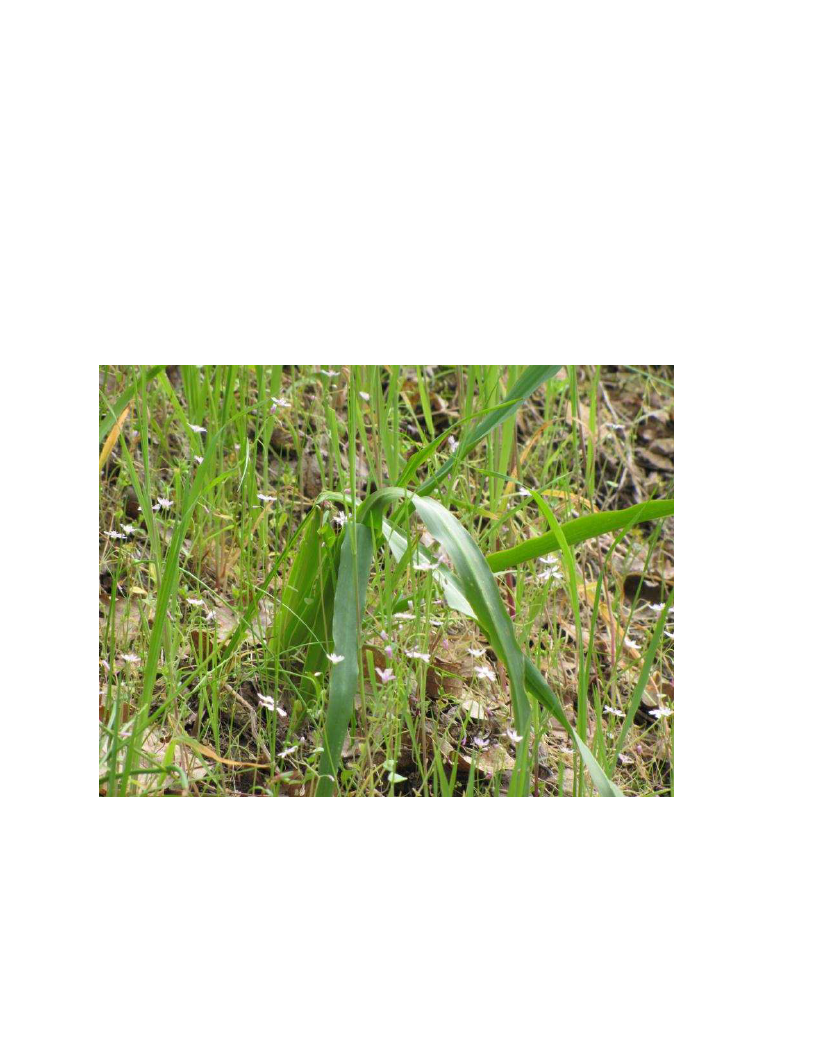
EDUCATING FOR BELONGING
91
Wavy-leaf Soap Plant
Chlorogalum pomeridianum
Found commonly in many parts of North America, this specimen was on a shady bank of small
creek in mixed conifer forest. This plant was highly used by the native tribes of Sonoma County.
This plant was used as a fish poison, a food source and as fiber to local Native peoples. The
juice of chlorogalum pomeridianum can be rubbed on skin to treat poison oak. The bulbs, when
roasted, were used as an antiseptic compress for sores. Fresh bulbs were rubbed on the body for
muscle cramps and rheumatism. The lather made from the bulb was also used as a wash to
prevent lice. Bulb tea was used as a diuretic and laxative and for gas pains. Stalks used as a
shampoo for dandruff. However, there is some caution in the use of the raw bulb, it may cause
dermatitis (Foster & Hobbs, 2002, p. 29).
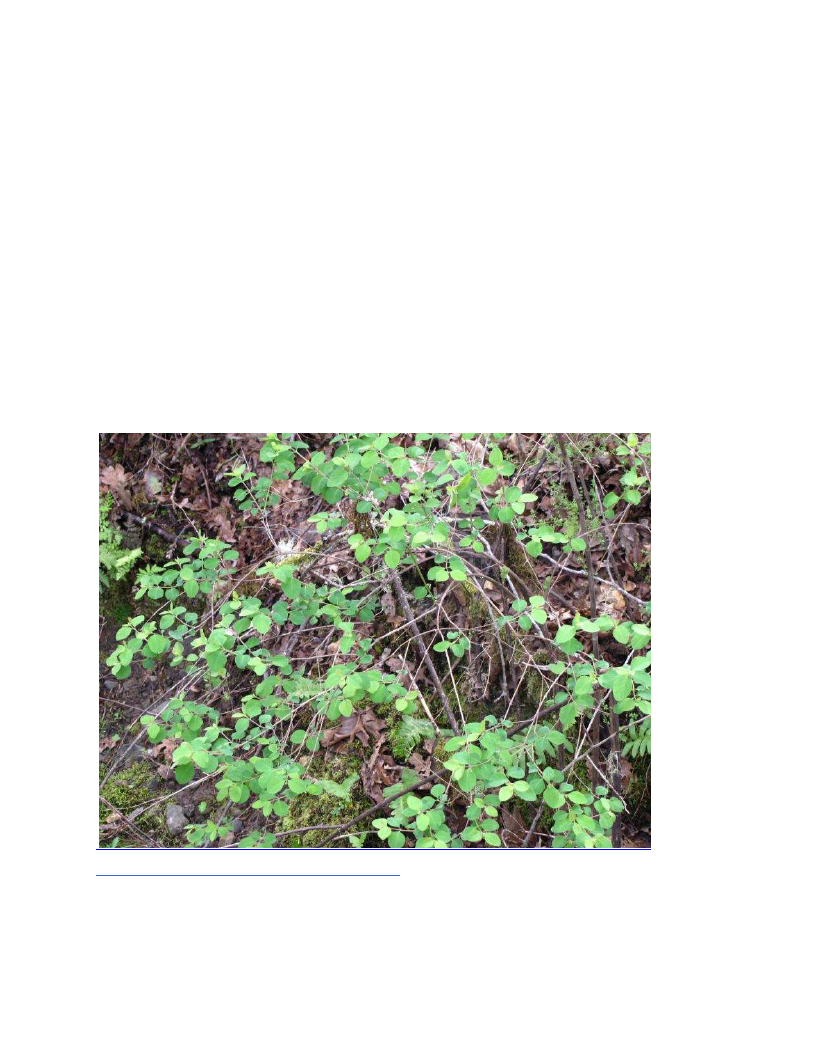
EDUCATING FOR BELONGING
92
Service Berry
Amelanchier pallida
Common in Riparian habitats and on moist, wooded hillsides up to alpine elevations. The ripe
berries are edible and are excellent made in jams. American Indians dried the berries for use or
long-term storage. Native Americans also used the berries in pemmican, which were dried cakes
made of fruits, nuts or meats and carried for travel nourishment. The green inner bark of this
plant was also used in eyewashes, eardrops, and to help stop excessive vaginal bleeding that can
occur after childbirth. The berries could also be used to treat constipation and various stomach
disorders. The berry juice also makes a purple dye. (Tilford, 1997, p. 134). It is a deciduous
shrub/tree, to 40 ft (12 m). They like well-drained moist soils. They are cold and drought
tolerant. Flowers small, white, fragrant appear in early to late May or early June, and the purple
fruit ripens in early to late July. Fruit is 1-1.5 cm, rounded, purple-black, edible, and sweet.
Apparently, the fruit tastes a bit like a blueberry. The berries have a pleasing and unique flavor,
and are also high in iron and copper. They are good eaten fresh or in desserts.
http://www.pickyourown.org/unusualfruits.htm
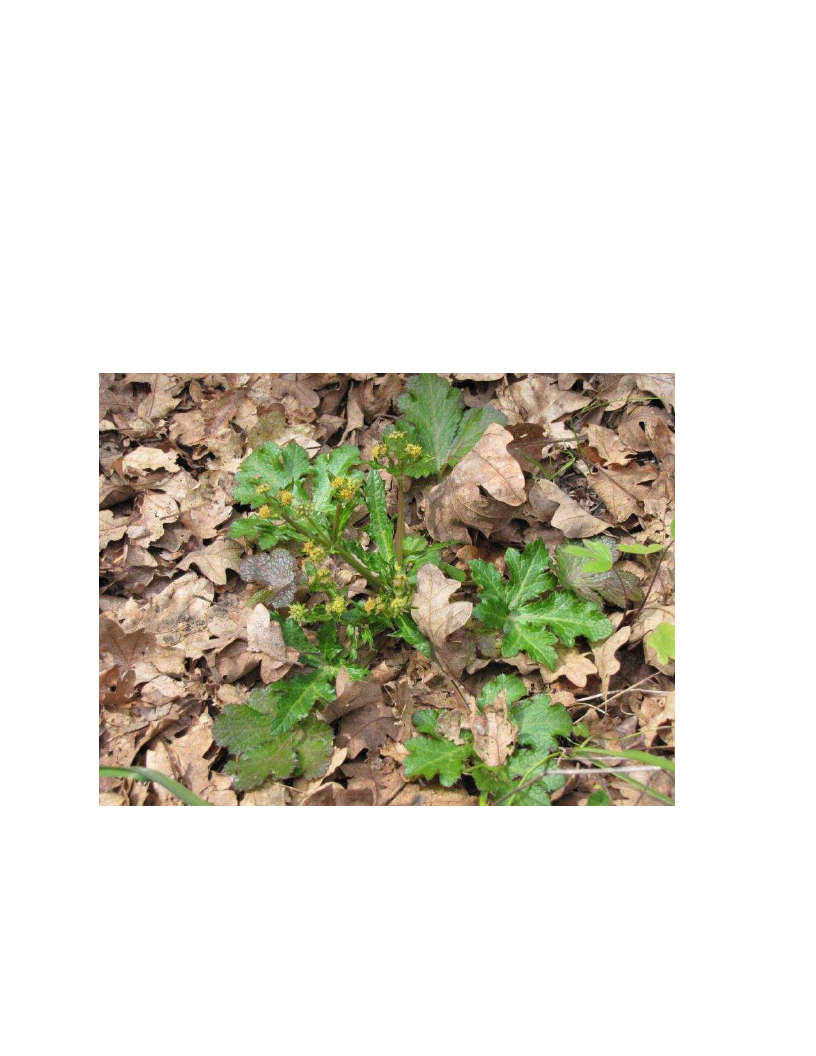
EDUCATING FOR BELONGING
93
Pacific Sanicle, Snakeweed
Family (Apiacae)
Sanicula crassicaulis Carrot
Perennial to 3 feet; taproot stout. Faintly celery-scented. Flowers Mar-May. Found in moist to
dry, open or shaded slopes, woodlands. Ranges from CA Coast Ranges to BC and in South
America. The roots were chewed and massaged into the skin to bring good fortune to gamblers;
the plant was never eaten because it was thought to be poisonous. It was used for snakebites and
as a poultice for wounds. (Foster & Hobbs, 2002, p. 126). Note: Hobbs and Foster included
Pacific Sanicle as in the Parsley Family; most other sources cite Sanicula Crassicaulis in the
Carrot Family.
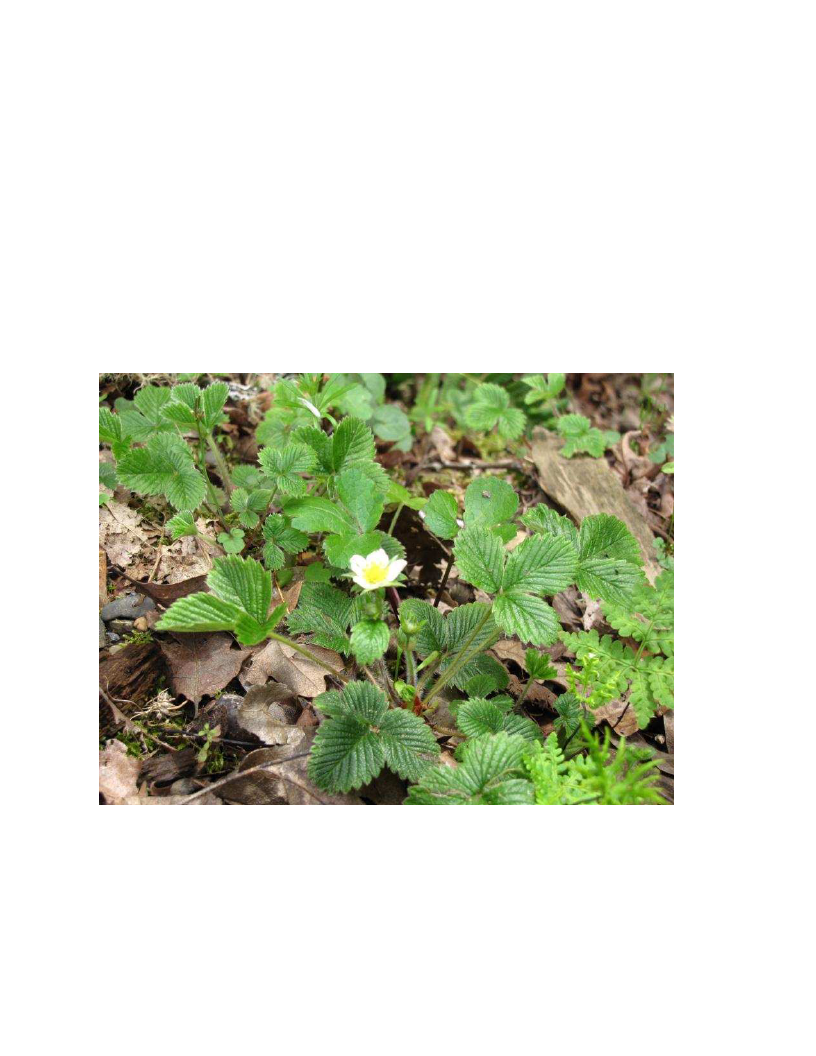
EDUCATING FOR BELONGING
94
Wood Strawberry
Rosacae Family
Fragaria species
Wild wood strawberry is easily identifiable to anyone who has strawberries growing in their
garden. This plant is almost identical, but smaller. Look for this plant in mixed forests—this
specimen was found in a mixed redwood/conifer forest. This plant blooms small, white five-
pedaled flowers in the spring (April-June) and produces tiny edible strawberries that are a joy to
find and eat… so long as every other creature in the forest hasn’t found and devoured them
already. I have rarely seen the fruit of the wild strawberry for this exact reason, yet it’s exciting
to see a plant that is so well cared for in my own garden growing locally in a natural state (Munz,
2004).
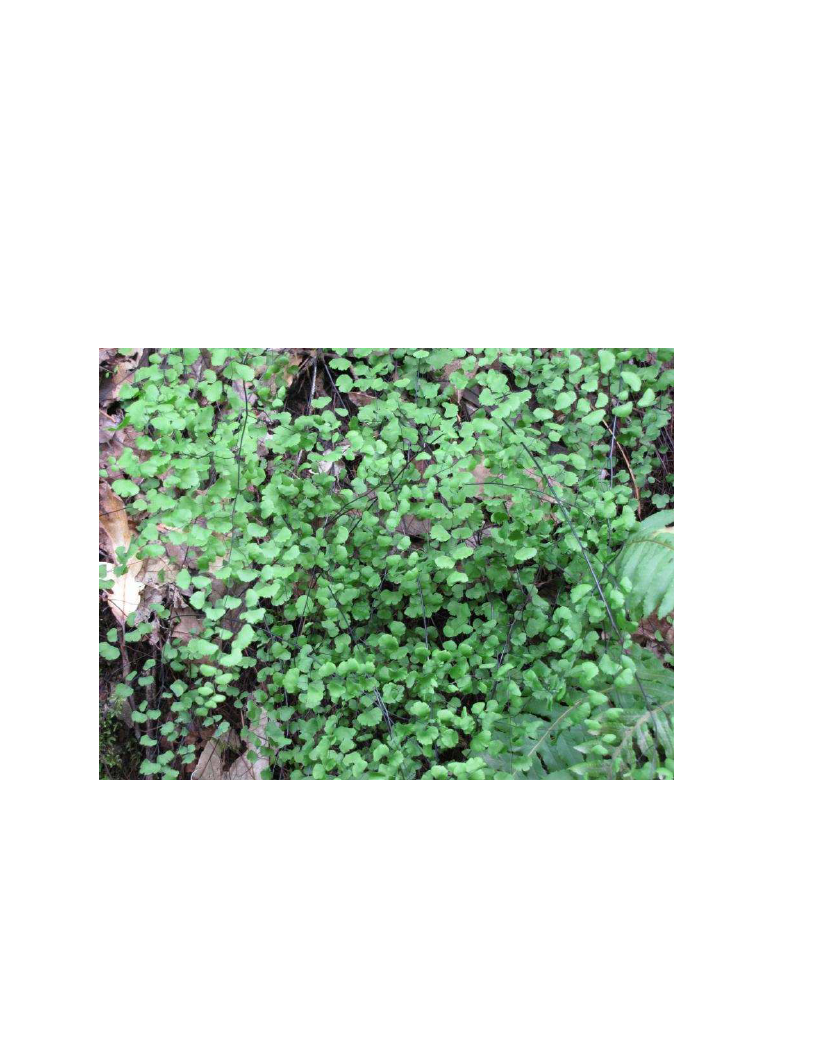
EDUCATING FOR BELONGING
95
Maidenhair fern
Adiantum jordanii
Pteridaceae Family
Dark brown shiny stipe (or stem) is the distinguishing characteristic of this fern. I find
this fern to appear rather delicate also, in testament to its name. The fronds are pinnately
compound and are lobed only on the bottom half. These ferns are found in moist, shady,
canyons. Native Americans sometimes chewed the leaves of this plant to stop internal
bleeding (Tilford, 1997, p. 94). Costanoans also used plant tea for pain, as a blood
purifier, for stomach ailments, and to expel afterbirth. Stems also used in basketry
(Merriman, 1966).
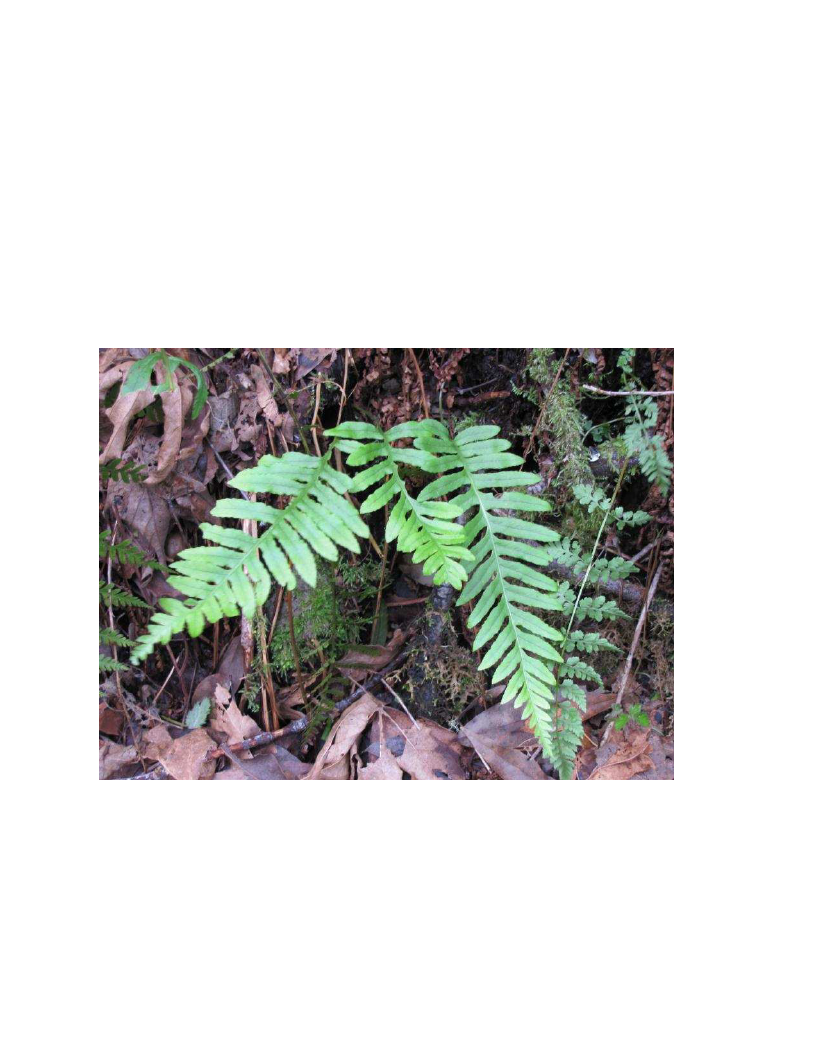
EDUCATING FOR BELONGING
96
California Polypody fern
Polypodium californicum
This fern can be distinguished from other ferns that are singularly pinnate in this area
because the rhizome does not taste sweet or like licorice. The fronds are considered
“once cut” which also distinguishes this fern from others in this area. Wailaki Indians
rubbed the root juice on areas affected by rheumatism applied it to skin sores and as an
eyewash. Root considered expectorant, used for sore throats, colds and stomach
problems. Used over a long period, it was once thought to be beneficial in the treatment
of venereal disease. (Foster & Hobbs, 2002, p. 374).
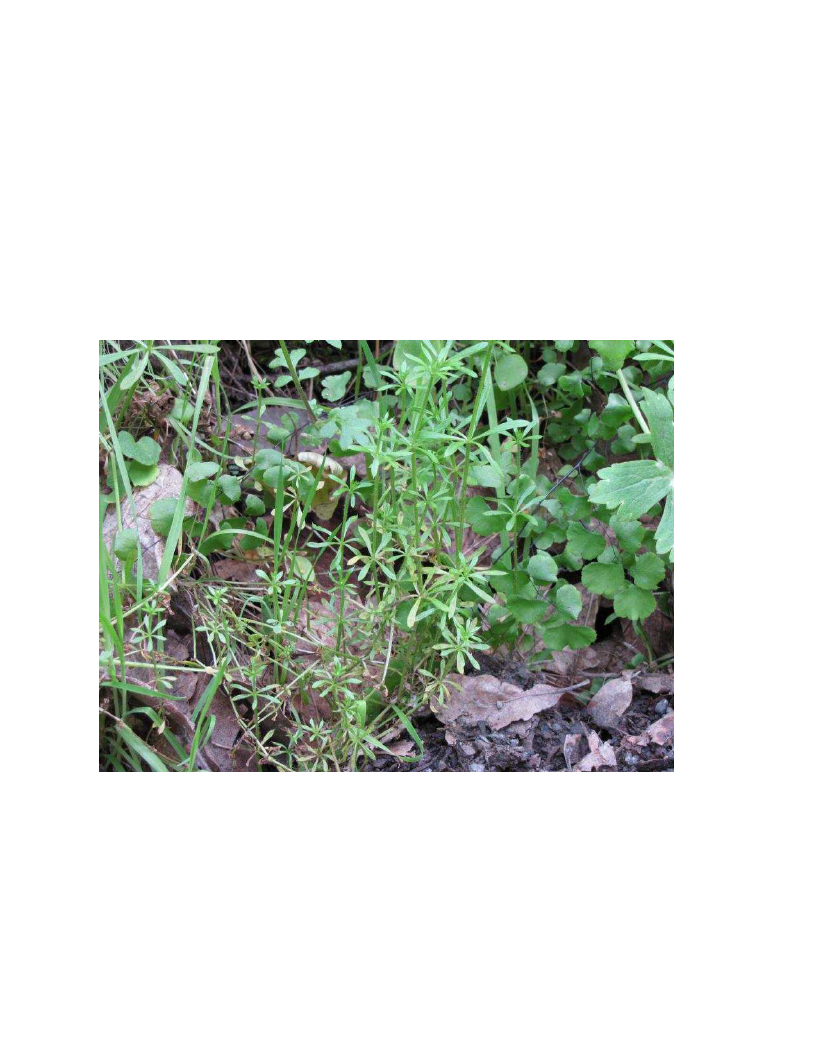
EDUCATING FOR BELONGING
97
California bedstraw
Galium aparine
Square stems, raspy, with hooked hairs prominent on the stalks. Leaves lance-shaped in
whorls of 6-8. Flowers small, on slender stalks from leaf axils. Found in moist, shady
areas throughout N. America. Non-native. (Alden, 1998). Used as a tea for lymphatic
swelling, kidney inflammations, bladder infections, cysts, and for blood purification.
Native Americans adopted the use of this plant from Europeans and used it also
externally for infections, rashes, and other skin problems, including poison ivy and oak.
Laboratory tests show that the compound found in this plant has laxative properties as
well as diuretic and anti-inflammatory properties. (Foster & Hobbs, 2002, p. 39).
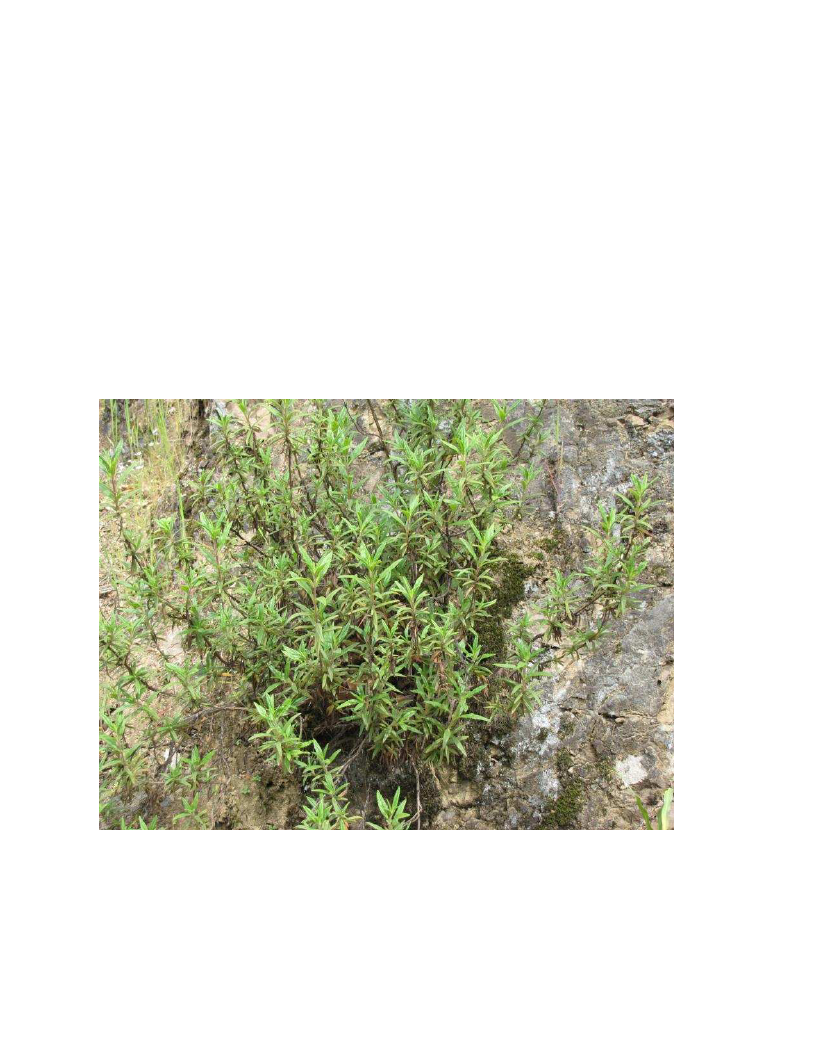
EDUCATING FOR BELONGING
98
Sticky Monkey Bush
Mimulus aurantiacus
Figwort Family
Characterized by sticky leaves that are covered in fine hairs. Leaves are narrow, lance-
shaped, dark green, sessile. Leaves are usually curled under slightly. Flower is tubular
“2 lipped with 5 notched lobes” color varies from yellow-orange to peach, white, red.
Blooms Mar-Aug. Found in lots of California ecotones including chaparral, forests, and
meadows. Plant is drought-deciduous. Costanoan Indians used plant tea to treat kidney
and bladder infections. Mahuna Native Americans used this plant to treat diarrhea.
Pomo Native Americans used this plant as topical eyewash. (Foster & Hobbs, 2002, p.
260). This specimen was found on a sun-exposed hill above a redwood grove- the flowers
are not in bloom.
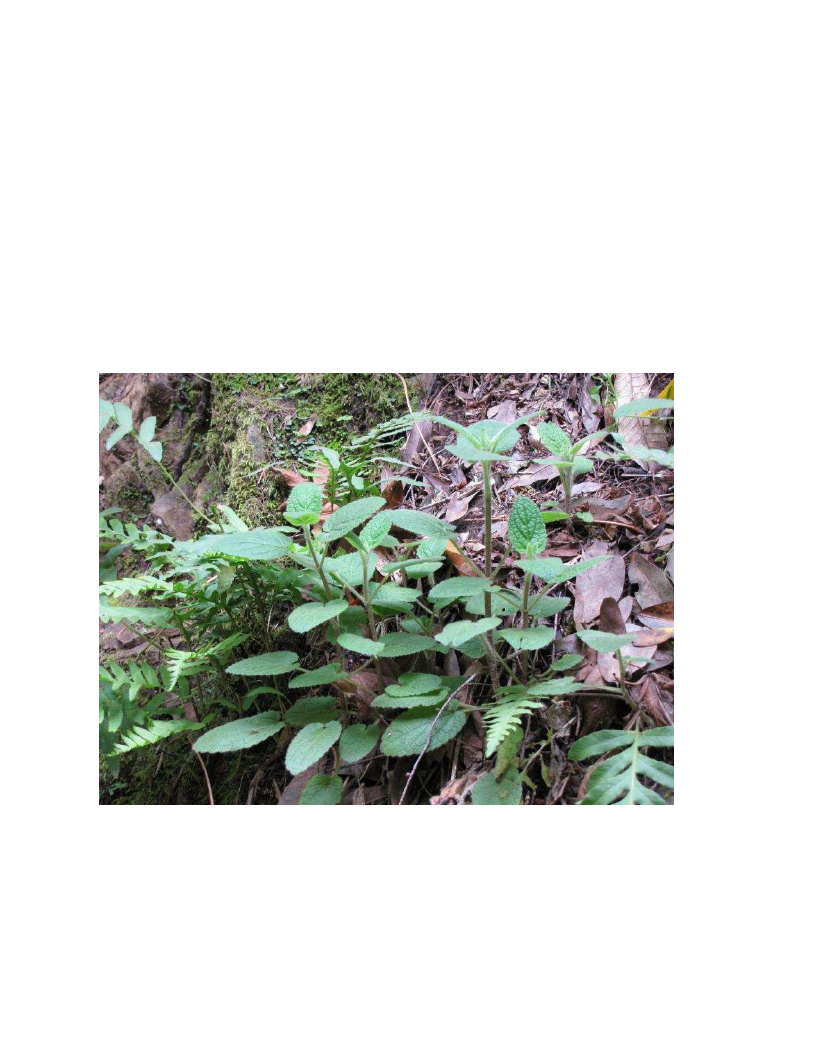
EDUCATING FOR BELONGING
99
Hedge Nettle
Stachys ajugoides
Mint Family
Coarse-haired, aromatic perennial. Very common at Pepperwood Preserve. Leaves are
opposite on square stems (a characteristic of the Mint Family). Flowers are pink and
bloom April-September. The flowers appear in whorls of 6 and are unspotted. Found on
coastal slopes and oak woodlands in the California Coastal ranges. This specimen was
found on a hillside that was studded with oak trees. According to Foster & Hobbs (2002)
this plant was used by California natives as a tea for skin infections, boils, swelling, joint
pain, sore throat, earache, headache, stomachache, colic, coughs and colds (p. 174). This
plant was also used as a poultice for boils, stomachaches, and earaches (Bocek, 1984).
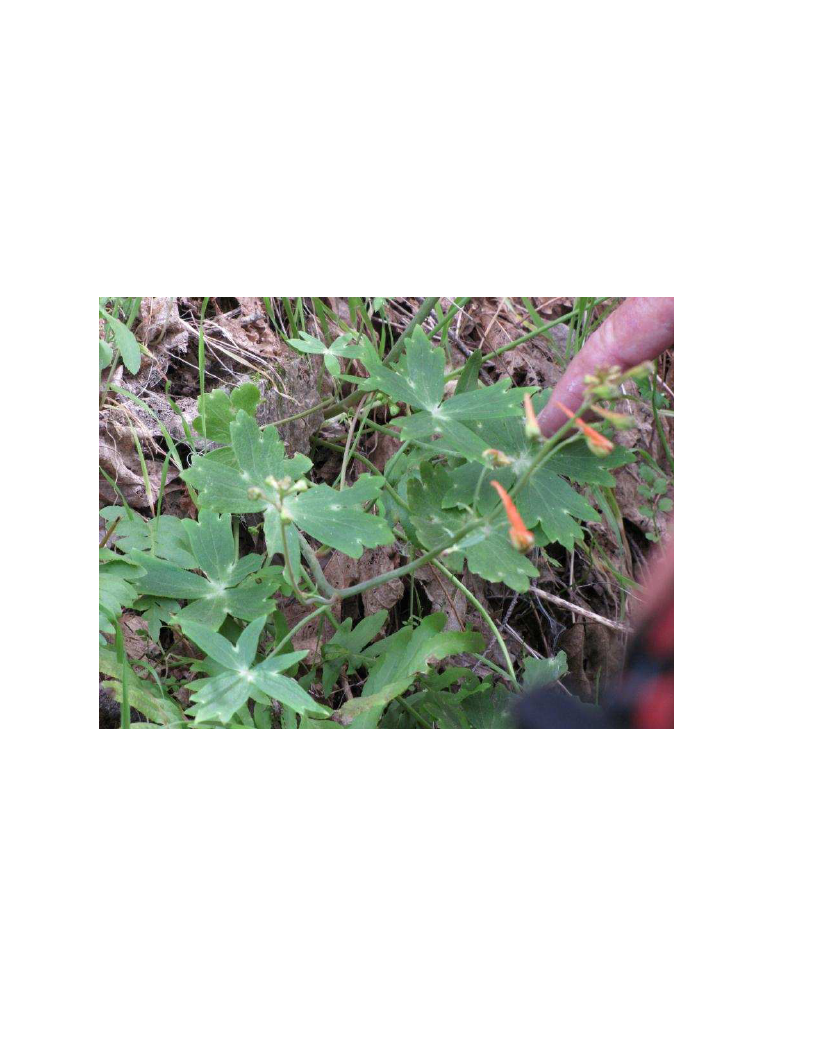
EDUCATING FOR BELONGING
100
Orange Larkspur
Ranunculaceae family
Delphinium nudicaule
Most larkspurs are associated with the color blue, but there are a few red, scarlet and one
orange larkspur in California. This is the rare orange larkspur that grows in moist forests
on wooded, rocky slopes up to 8,500 feet (Munz, 2004). The only data about edible or
medicinal uses comes from Chestnut (1902) indicating that the Native Americans in
Mendocino used this plant for narcotic purposes.
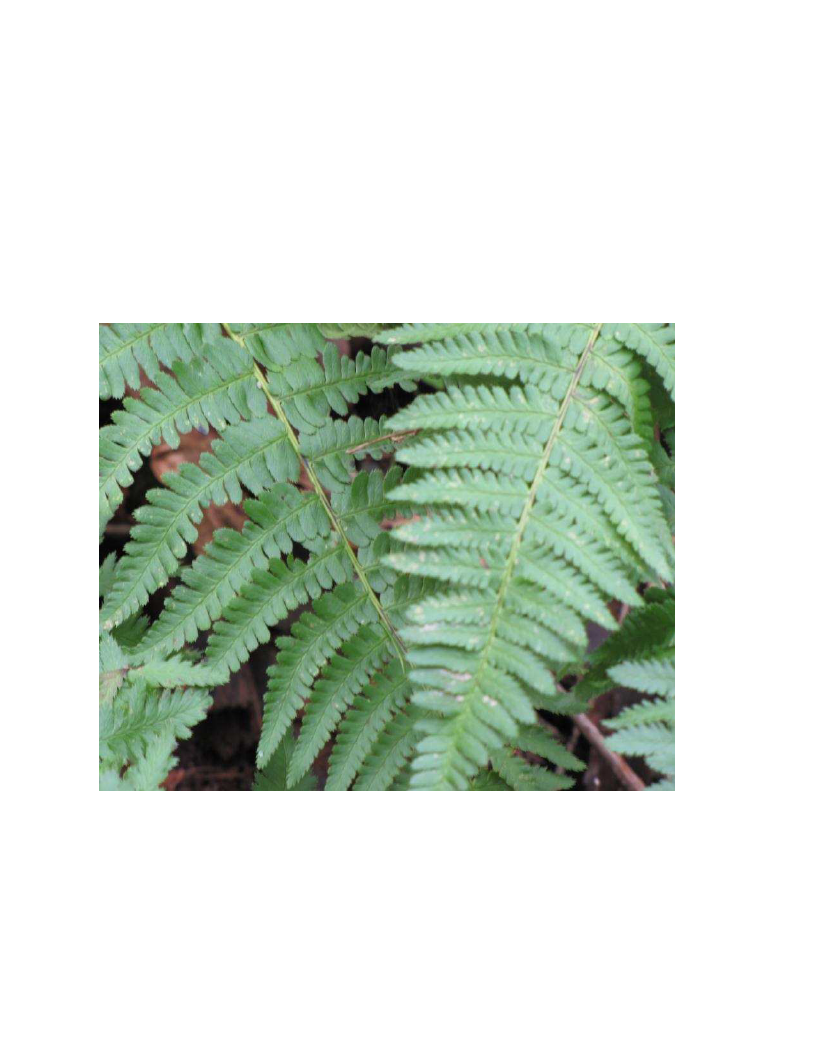
EDUCATING FOR BELONGING
101
Ladyfern
Dryopteridaceae family
Athyrium filix-femina
Found in Yellow pine forests, red fir forests, Lodge pole forests, redwood forests. It is
equally likely to occur in wetlands or non-wetlands. Native to California but found all
over North America. Notice the details in the picture below. It is bi-pinnately compound
and the leaves are slightly toothed. The fronds alternate from the stem. According to
Baker (1981, p. 20) the leaves of this fern were used to clean eel’s blood from butchered
eel in Northern Coastal native tribes.
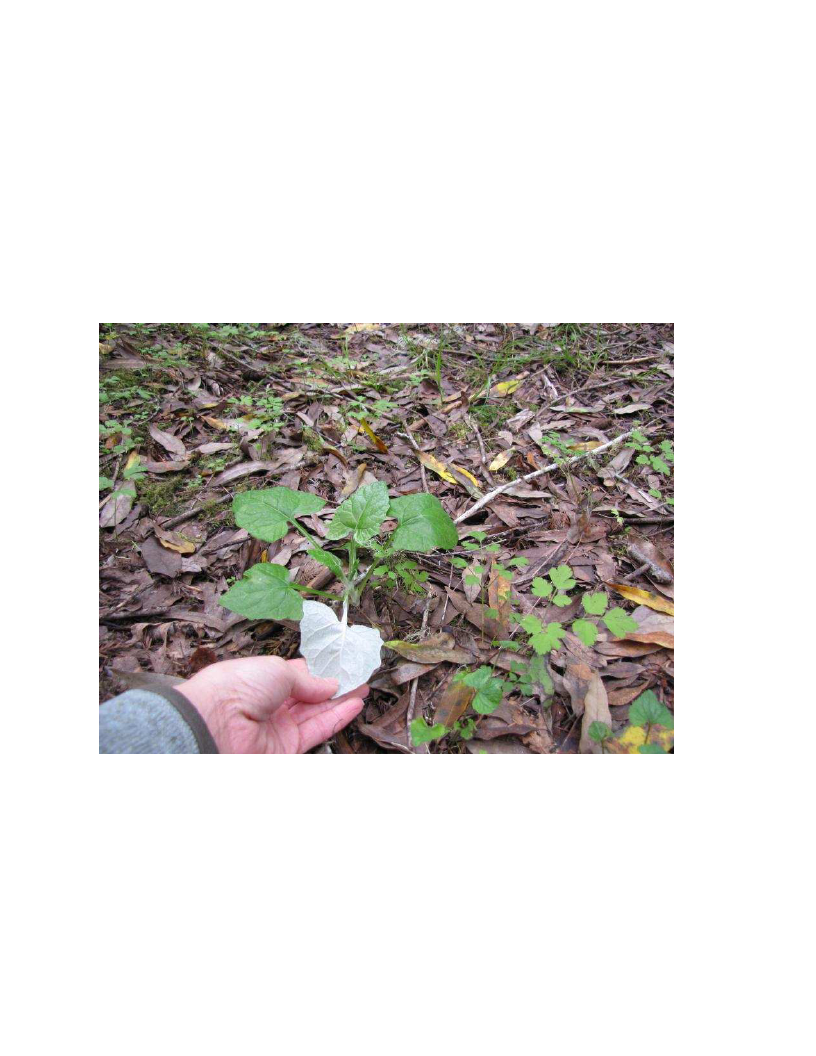
EDUCATING FOR BELONGING
102
Pathfinder plant
Asteraceae family
Adenocaulon bicolor
This plant is often found growing along trails in moist, shady forests. I believe this is how this
plant got its common name, because it likes to grow along trails and is easily distinguishable
because of its white underside of its leaves. A naturalist told me that Native Americans would
flip the leaves over with a stick to mark particular spots along a trail. Gunther (1973) indicates
that Native Americans in what is now Washington State used this plant as a poultice for boils,
sores and other dermatological needs.
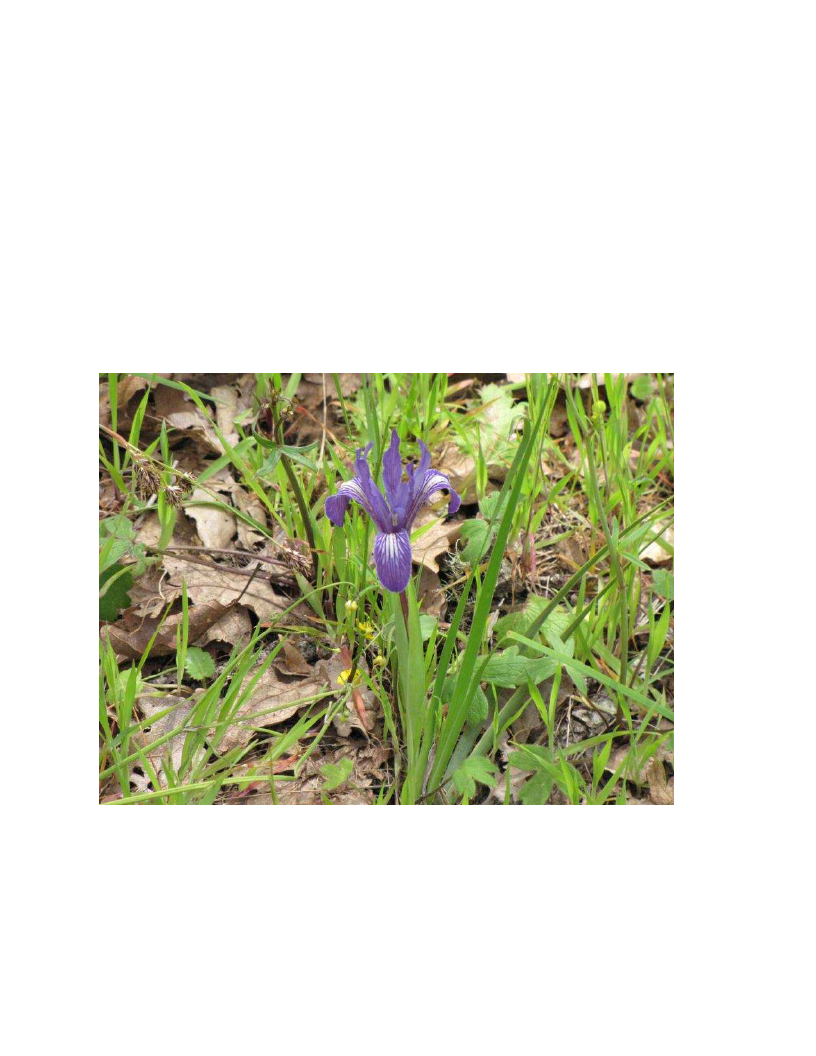
EDUCATING FOR BELONGING
103
Douglas Iris
Iridaceae family
Iris douglasiana
The leaves of this plant are rough, fibrous and have pinkish/reddish bases. The flowers are
similar to the garden variety of iris and can vary from deep purple to lavender and are usually
one to two feet tall. It is found from Santa Barbara County to Oregon. (Munz, 2004, p. 164) In
the photo below, you can see the reddish stem base. The iris leaves are the blade-type flat fronds
that extend from the base of the flower. According to Chestnut (1902) leaves were used to wrap
babies during berry gathering trips to retard perspiration and prevent thirst. The leaf edges were
also made into nets and ropes to catch deer. Goodrich & Lawson (1980) indicate that the Pomo
Indians used the flowers in dance wreaths at a Strawberry festival.
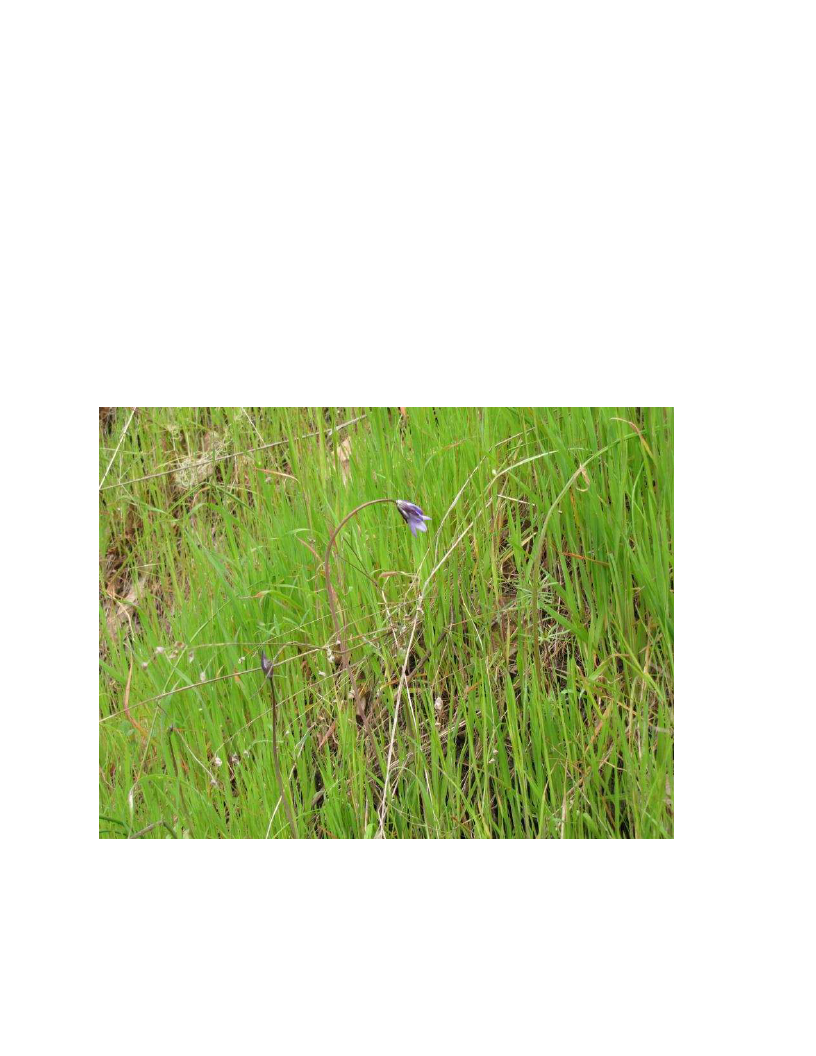
EDUCATING FOR BELONGING
104
Bluedicks, Wild Hyacinth
Liliaceae Family
Dichelostemma capitatum
Blue dicks are a perennial with major identifying features including a dense cluster of purple, blue or
white flowers and a smooth, leaf free stem. The plant has two basal leaves and black seeds. Bluedicks
may reach up to two feet in height and thrive in open, disrobed environments like trails. This plant has
been noted by the USDA to be a common post-fire succession species in chaparral environments (USDA,
http://plants.usda.gov/plantguide/pdf/cs_dica14.pdf) I’ve always been taught that the corms (or seed
roots) were food for wildlife such as javelina, black bears, mule deer, and gophers. What I discovered is
that the corms of the seeds often germinate easier after they have been thinned or dislodged by an animal
eating multiple corms in one stand. This is an interesting symbiotic exchange. According to the USDA,
“Large quantities of corms were gathered with digging sticks in over half of California, parts of the Great
Basin and Southwest. These corms formed an important starch source in the diet of native people.
California Indians dug and continue to dig the corms before flowering, during flowering, or after seeding
depending upon the tribe and individual family. Traditional gathering sites were visited annually, over
long periods of time and there are references to gathering tracts of different kinds of corms and bulbs
specifically owned and maintained by particular families. Today different kinds of brodias have gained
popularity as cut-flower crops.” (http://plants.usda.gov/plantguide/pdf/cs_dica14.pdf, Baker, 1981)
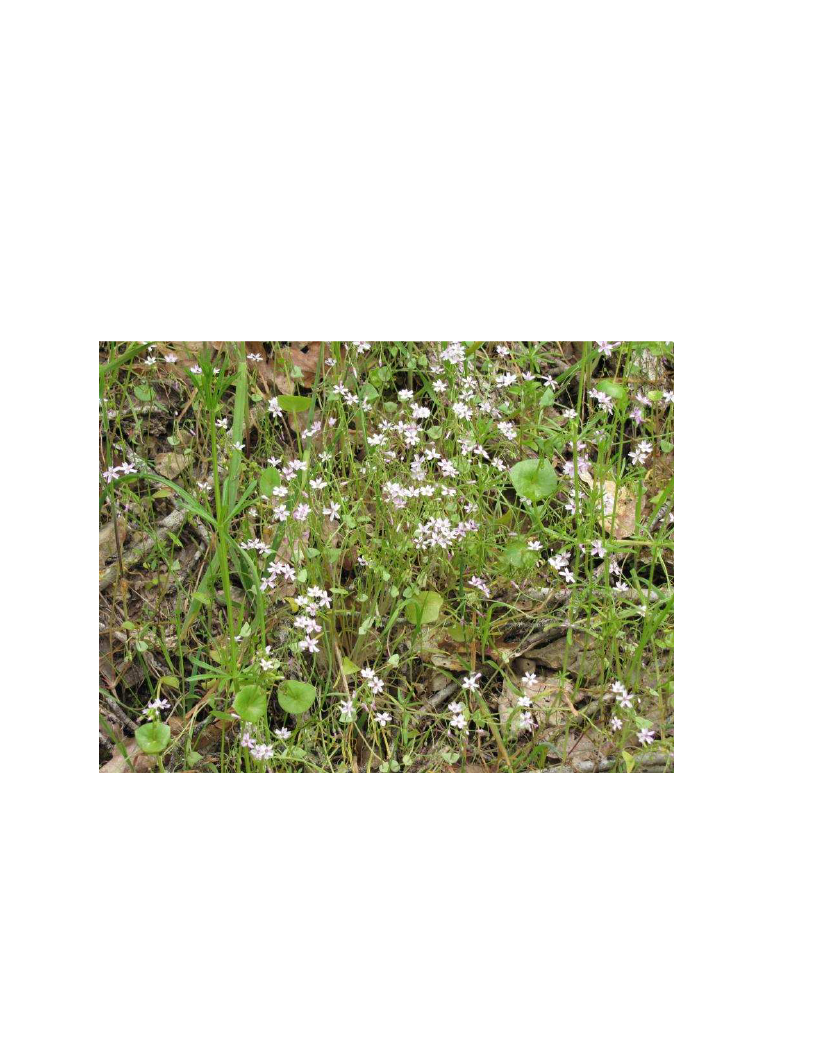
EDUCATING FOR BELONGING
105
Miner’s Lettuce
Portulacaceae family
Claytonia sibirica
The Claytonia genus of plants includes 26 different species. Claytonia
perfoliata is the most recognized and most common of this genus,
recognized through the common name of Miner’s Lettuce, named for
miners adding the green to salads. I couldn’t find definitive citations to
note that claytonia sibirica is edible too, but Baker (1981, pg. 25) cites
Claytonia sibirica as a food for the Yurok Indians; they ate the shoot
tops raw.
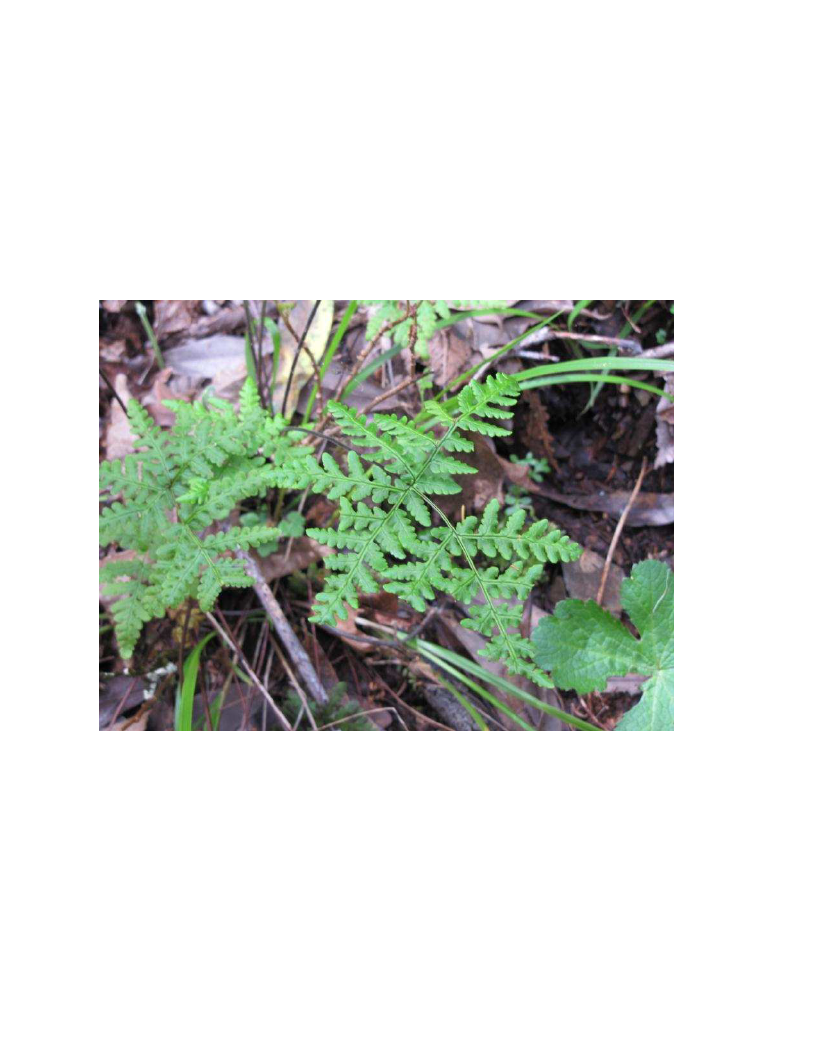
EDUCATING FOR BELONGING
106
Goldback Fern
Pteridaceae family
Pentagramma triangularis
Goldback fern is a fern that is native to California and is also found outside of California,
but is confined to western North America. Fronds have a softer edge and alternate from
the stem. Besides its bi-pinnate structure, the Goldback fern has an obvious defining
characteristic: a dramatically gold back. Barrett & Gifford (1933) note that pentagramma
triangularis was used by Miwok Indians as a toothache remedy by chewing it.
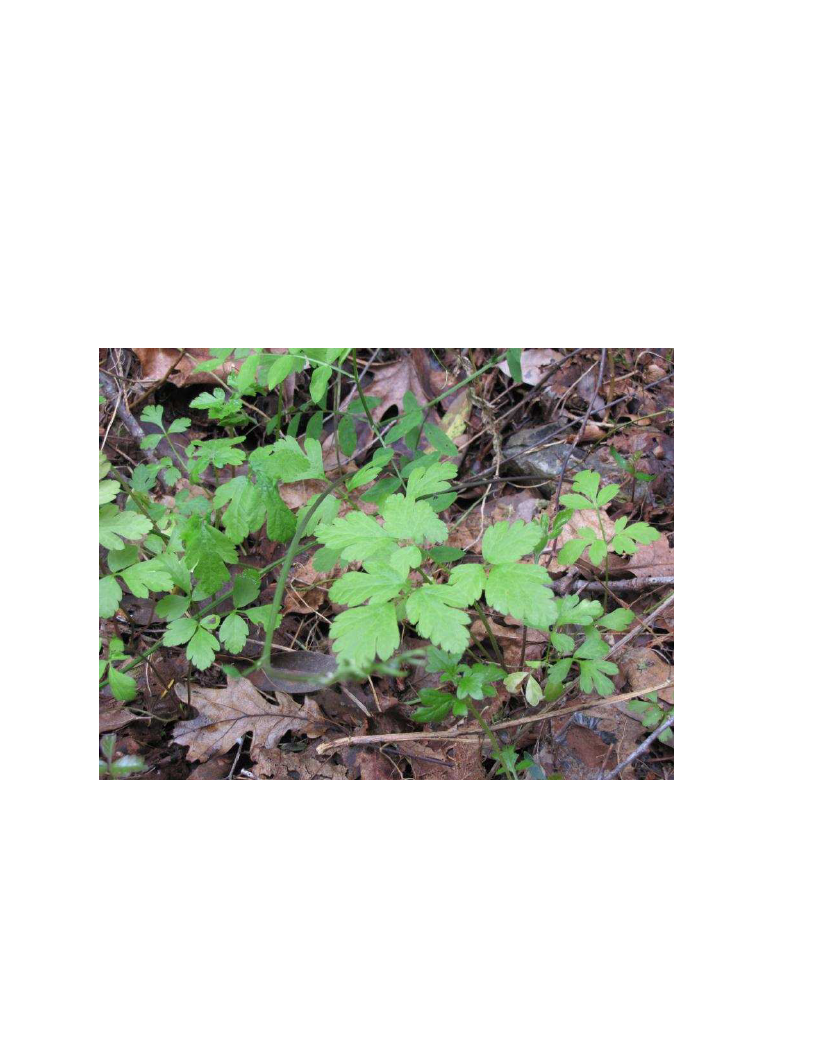
EDUCATING FOR BELONGING
107
Western Sweet Cicely
Parsley Family
Osmorhiza chilensis
Western Sweet Cicely is a perennial herb that is native to California and is also found elsewhere
in North America and beyond. Also known as Osmorhiza Berteroi, Osmorhiza chilensis prefers
shady woods and well-drained soil. The roots and fruits are licorice scented. When in bloom,
this plant displays stalks of very small white flowers shaped like umbrellas. According to Foster
& Hobbs (2002) this plant was used by Native Americans to treat sore throat, coughs, colds,
headache, sores, skin ulcers and eye problems (pg. 69). This plant is visually very similar to
Poison Hemlock, which is deadly poisonous.
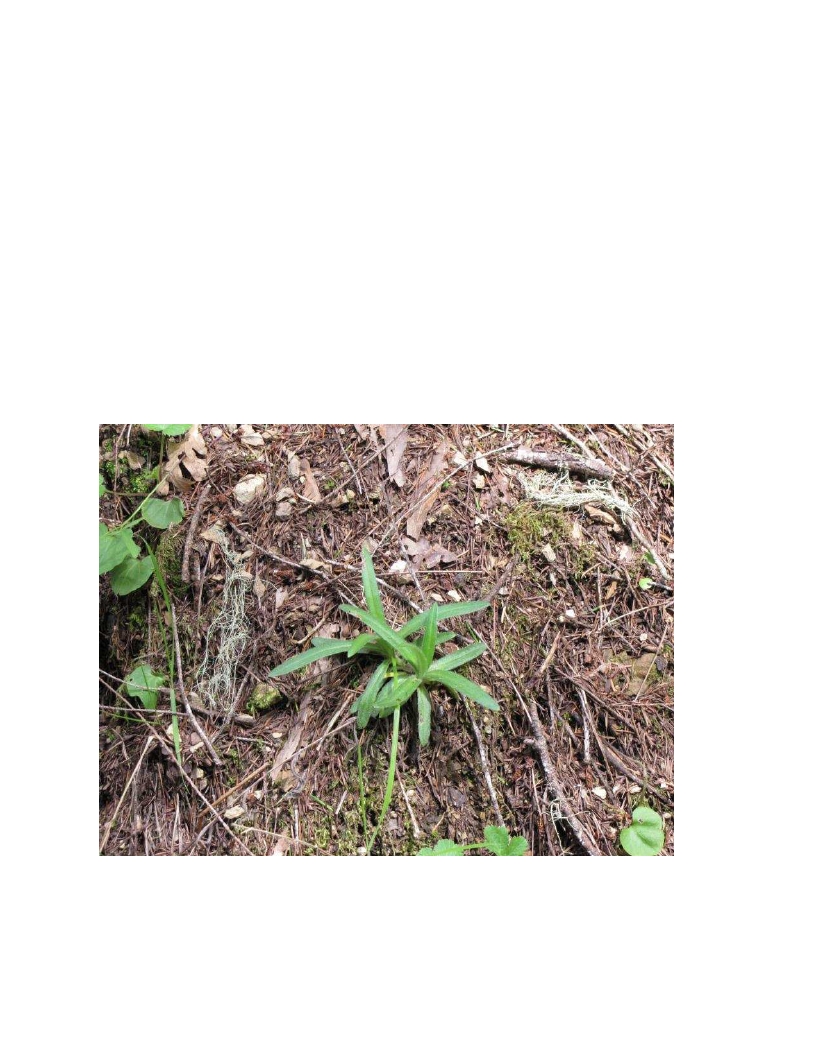
EDUCATING FOR BELONGING
108
Madia, Woodland
Madia madioides
Asterace Family
Because it is a part of the sunflower family (or asterace) when this plant is in bloom, the flowers
appear daisy-like. The flowers are often bright yellow with numerous thin ray flowers and
several central disk flowers. The strongly scented flower head grows at the end of a slender
green stem. An interesting adaptation of this plant is when the flowers curl up during the daytime
and open in the late afternoon and staying open all night until mid morning. It’s possible that the
plant is closing to avoid the harshest rays of the sun that occur during mid-day. The foliage
exudes a fragrant oil, hence the common name or tarweed
(http://en.wikipedia.org/wiki/Madia_elegans). This plant was considered a staple among the
Pomo and Miwok tribes (Barrett & Gifford, 1933). Both tribes used it in the same way: roasting
the seeds, or grinding the seeds to make flour.
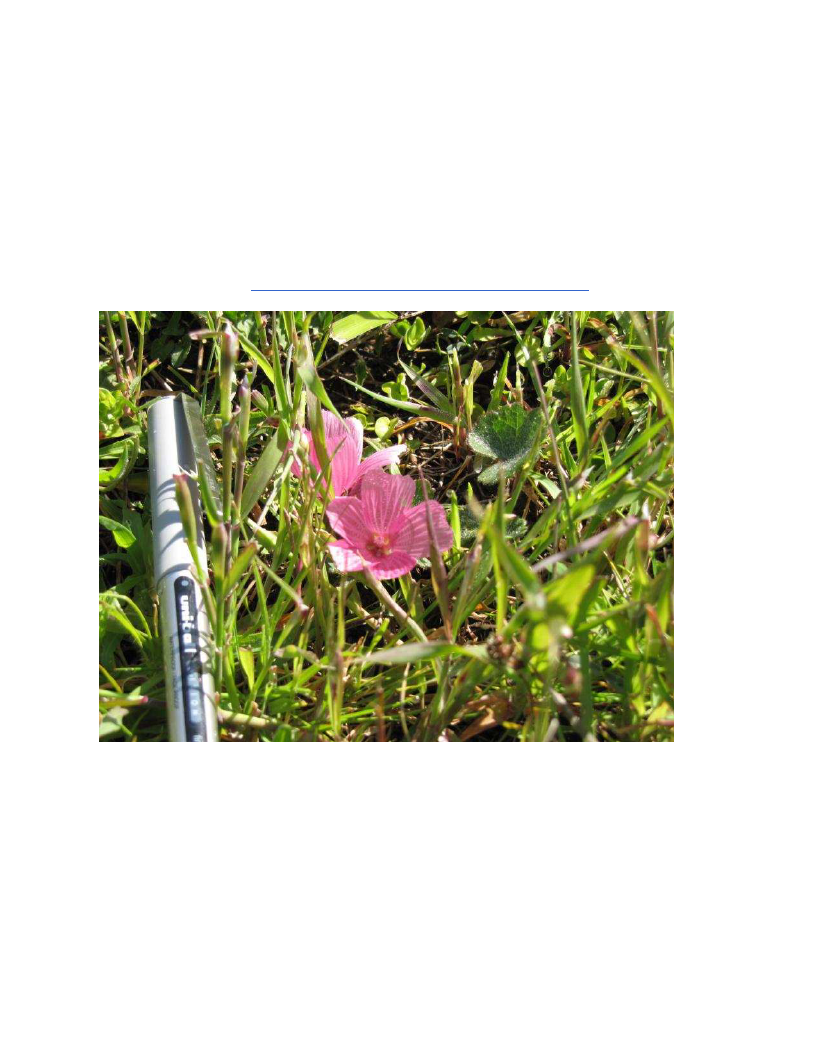
EDUCATING FOR BELONGING
109
Checker-bloom; Wild Hollyhock
Malvacae Family
Sidalcea malvaeflora
Native to California and widespread among grasslands, checker-bloom is a beautiful reminder of
color and spring in Sonoma County. Blooming between March-May, the five-pedaled flowers
are delicate but “showy”. The calyx and stamen inside the flower make a spiral pattern when
examined closely. I couldn’t find any information about this plant as a medicinal or edible in
this region—but I did find a researcher who claims that Southern California tribes used the
leaves as edible greens (http://www.sacred-texts.com/nam/ca/coli/coli26.htm)
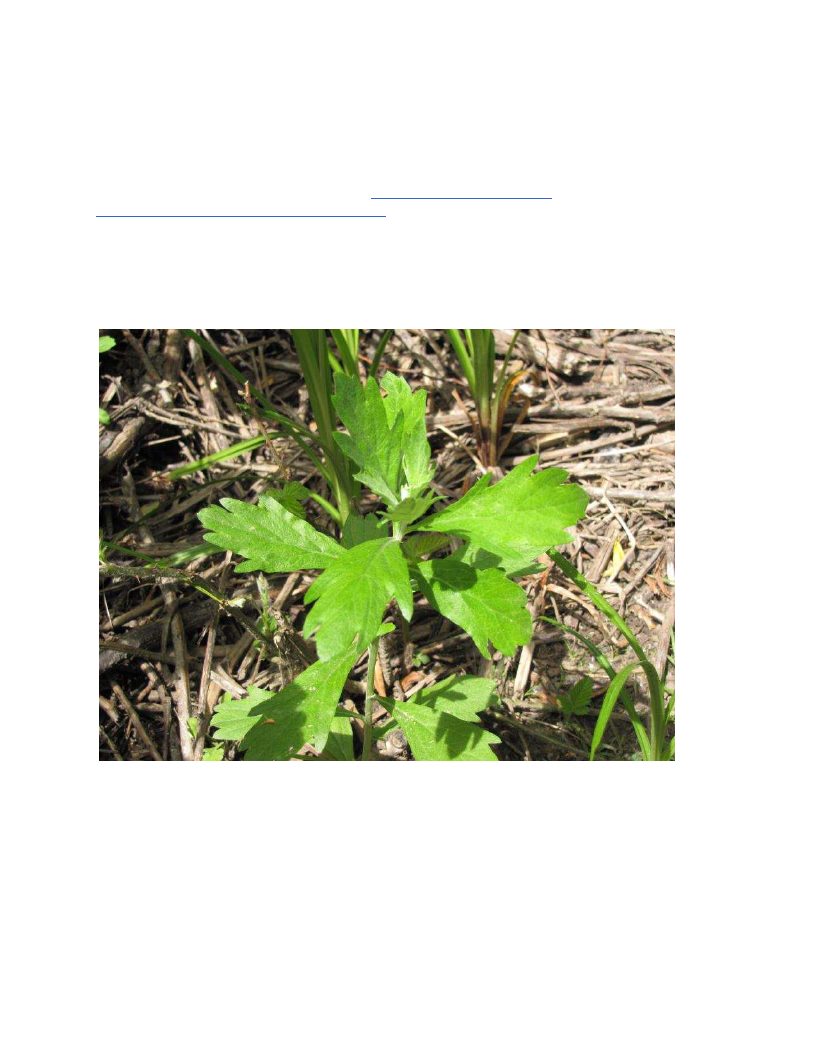
EDUCATING FOR BELONGING
110
Mugwort
Artemisia douglasiana
Mugwort is a perennial herb that is native to California and is also found outside of California,
but is confined to western North America (http://www.calflora.org/cgi-
bin/species_query.cgi?where-calrecnum=708). I was excited to find specific information about
how the Pomo people used this plant. It was used in numerous ways: decoction or infusion of
leaves taken for stomachache and cramps associated with diarrhea, poultice of warmed leaves
used on baby's severed umbilical cord, infusion of leaves used for washing itching sores and for
stomachache and cramps associated with diarrhea. As with other tribes it was used as a
menstrual aid, as an infusion of leaves taken to stop excessive menstruation or to ease cramps
(Goodrich & Lawson, 1980, pg. 119).
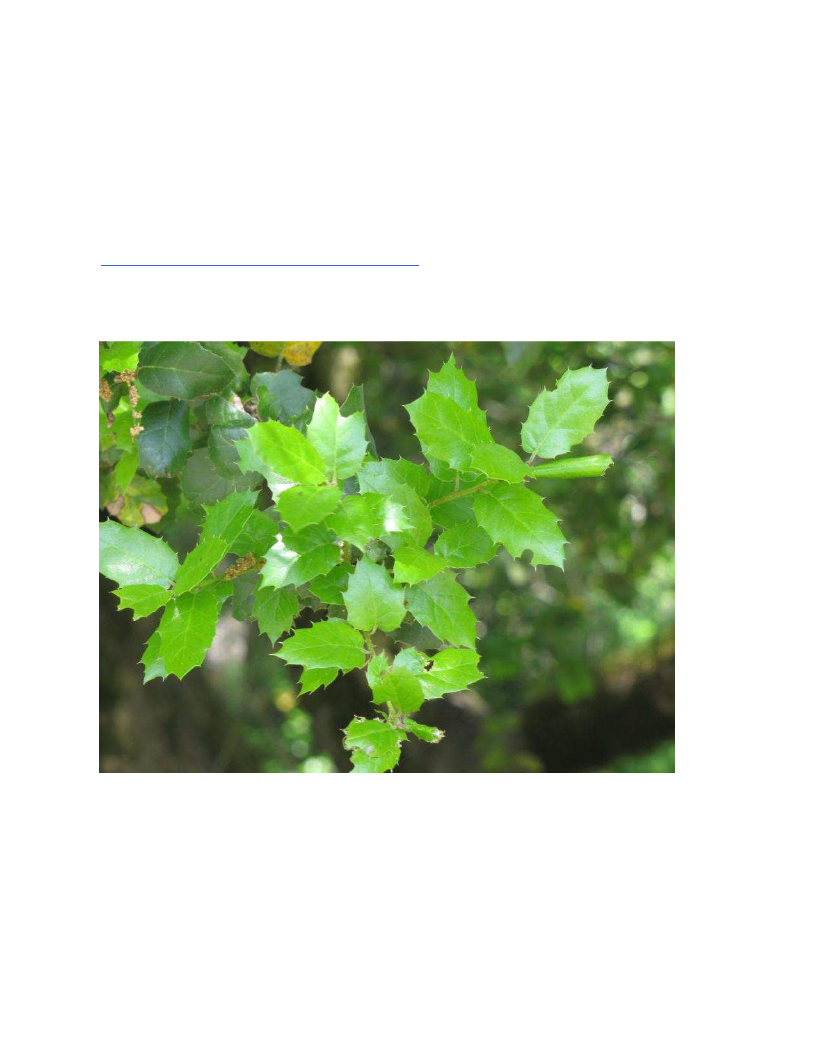
EDUCATING FOR BELONGING
111
Coast Live Oak
Quercus agrifolia
Coast Live Oaks are an easily recognizable species of oak that characterize the Oak Woodland
areas of Western Sonoma County. These trees create stable soil on hillsides because of their vast
root systems that help curb erosion. These trees have been an important staple for wildlife and
native peoples, mostly the nutrient rich acorns that the trees produce in fall. Pomo and Coast
Miwok native peoples used the acorns to make meal and bread, along with many other uses
including fiber and charcoal
(http://plants.usda.gov/plantguide/pdf/cs_quag.pdf; Goodrich & Lawson, 1980). These trees are
the defining characteristic of much of coastal California, and thus create a common bond among
the wildlife, native peoples and modern residents.
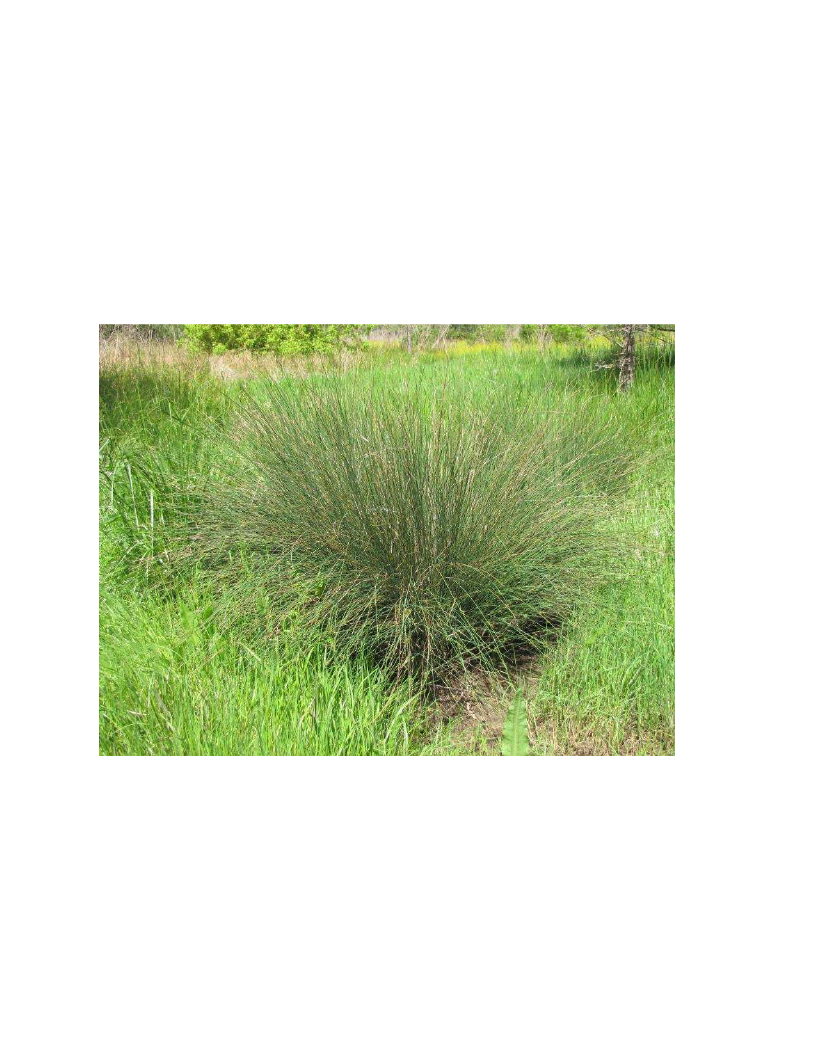
EDUCATING FOR BELONGING
112
Common Rush
Juncus effuses var. pacificus
Common Rush grows in large clumps about 1.5 meters (5 feet) tall at the water’s edge along
streams and ditches, but can be invasive anywhere with moist soil. It is commonly found
growing in humus-rich areas like marshes, ditches, fens, and beaver dams. Local Pomo people
used the blades to string clamshell beads to hold them together when being smoothed (Gifford,
1967). It was also noted that the blades used by children to make play baskets (Goodrich &
Lawson, 1980).
When I see Common Rush, I think water. Often I’ll be hiking through an otherwise dry area and
I know that if I spot Common Rush it is a signal that there is water nearby or underground.
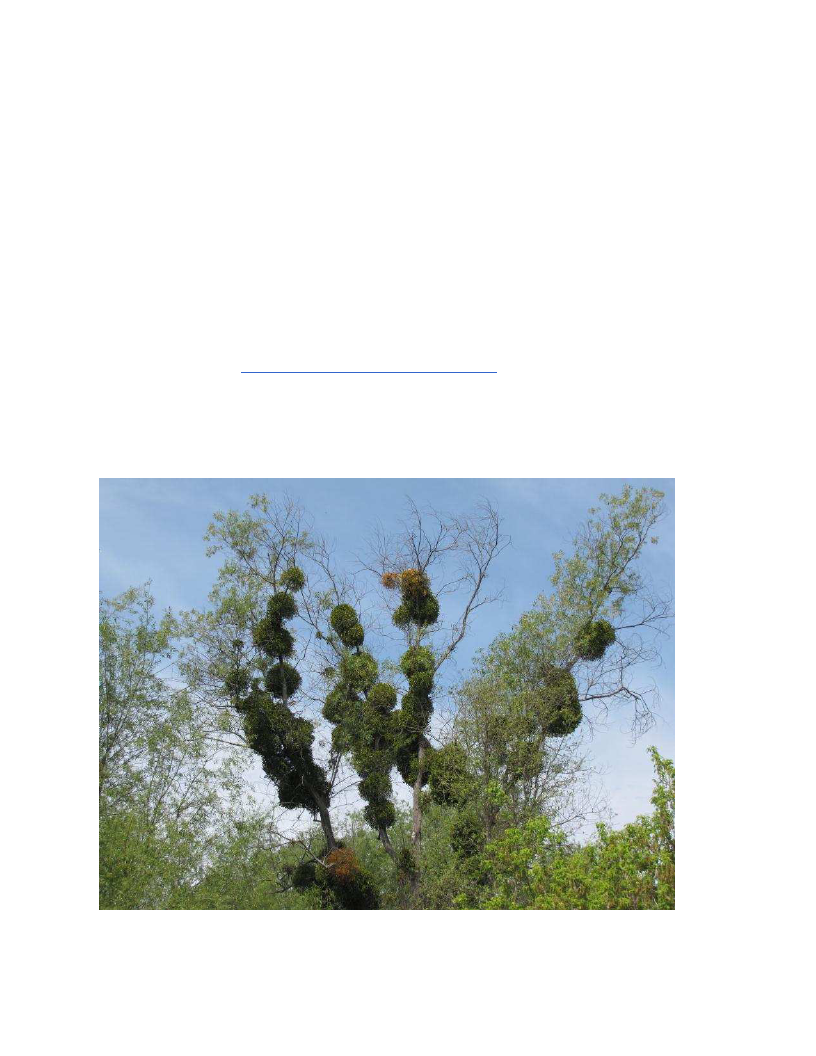
EDUCATING FOR BELONGING
113
Oak mistletoe
Phoradendron villosum villosum
Oak mistletoe is an interesting plant in this ecotone because it is parasitic. It requires a living host that it
pulls water and mineral elements from. Mistletoe “infections” are spread mainly by birds (robins,
bluebirds, thrushes) that feed on the berries. The berries are round, white to pink in color, occur in spikes
and are about one-quarter inch in diameter. The white fruits are a favorite of winter resident birds, who
pass them mostly undigested. The sticky fruits adhere to branches where they germinate and grow,
obtaining all of their water and mineral nutrients from the host tree. The seeds are also commonly found
excreted by birds on gates and fence posts where they adhere, but fail to germinate. The shrubs are green
and photosynthetic producing at least some of their own carbon compounds. Also occasionally found on
bay trees (Nevers, 2006, pg.72).
A berry usually holds a single seed surrounded by a sticky pulp. Birds digest the pulp of the berry and
excrete the living seed. By this means seeds are often deposited on susceptible trees. Young or small trees
are seldom infected by mistletoe. In nearly all cases, initial infection occurs on larger or older trees
because birds prefer to perch in the tops of taller trees. Severe buildup of mistletoe often occurs within an
infected tree because birds are attracted to and may spend prolonged periods feeding on the mistletoe
berries. (Adapted from: http://www.fs.fed.us/r6/nr/fid/fidls/147.htm.)
Pomo peoples used this flowering plant as a concoction for delayed menstruation (Goodrich &
Lawson, 1980). Other accounts stated that an infusion of this plant was used as a wash on limbs affected
by rheumatism, and also as an agent in the first two months of pregnancy to bring on an abortion
(Zigmond, 1981),

EDUCATING FOR BELONGING
114
Poison Hemlock
Conium maculatum
Parsley Family
A guidebook describes Poison Hemlock as:
“2-6 ft tall. Musty, ill-smelling when crushed. Stems are hollow and purple streaked. Leaves
alternate, pinnately dissected into fernlike segments; small flowers in umbrella shapes.
Widespread throughout North America. Non-native, of Euro descent. Found near wet,
distributed areas. Uses: Native Americans ate the root or took it in strong drink to commit
suicide. All parts of the plant are considered poisonous. This plant is DEADLY TOXIC. All
parts of the plant, but especially the ripe fruits and mature root, contain the toxic alkaloid
coniine. The ancient Greek philosopher Socrates drank the fresh juice of poison hemlock as a
punishment for inciting political unrest. In a famous account, he described going slowly numb
from his feet up until the paralysis stopped his breathing, and he died.” (Foster & Hobbs, 2002,
pg. 60-61).
In the picture below notice the purple areas on the stalk near the center of the plant. This
plant is a great example of adaptation in the plant kingdom, and also a great example of how
important it is to know your plants well before ingesting them. This plant is considered deadly
toxic at the rate of 1% of body weight. This plant also causes deadly toxicity to animals:
recently a local Santa Rosa woman had 7 of her 12 horses die and she believes it was due to
people on the local trail behind her property feeding the plant to the horses without knowing
(http://www.pressdemocrat.com/article/20080714/NEWS/807140342?p=3&tc=pg)
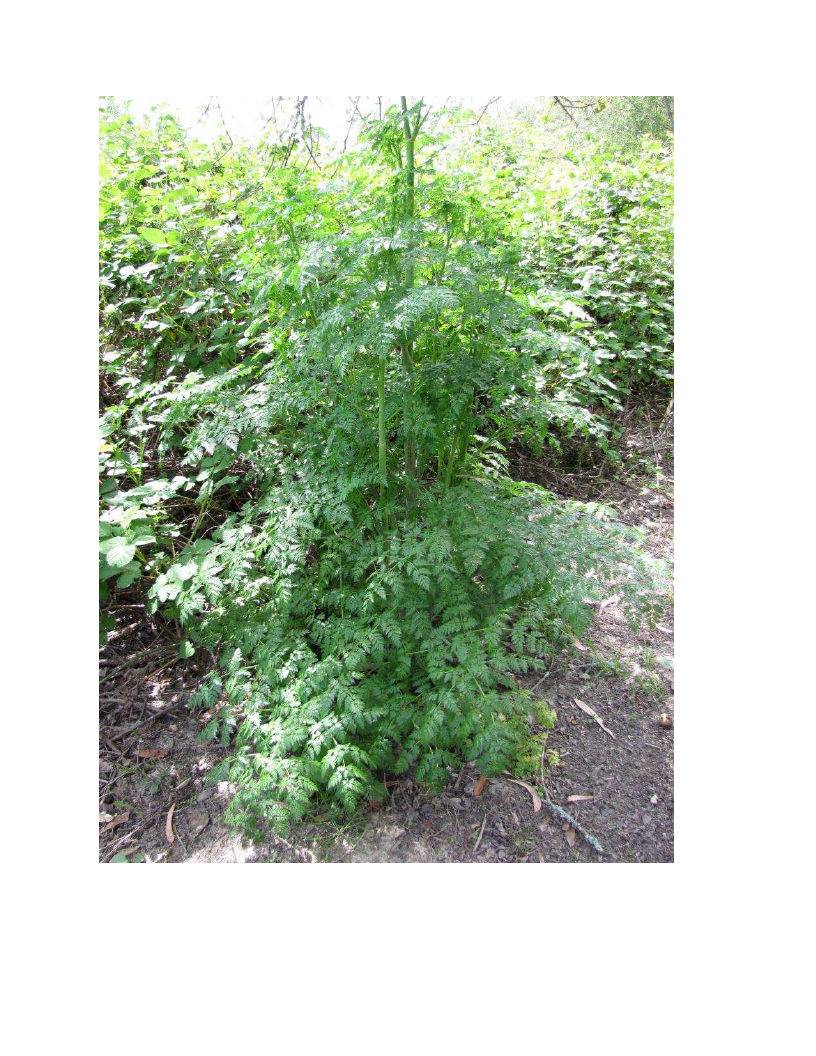
EDUCATING FOR BELONGING
115
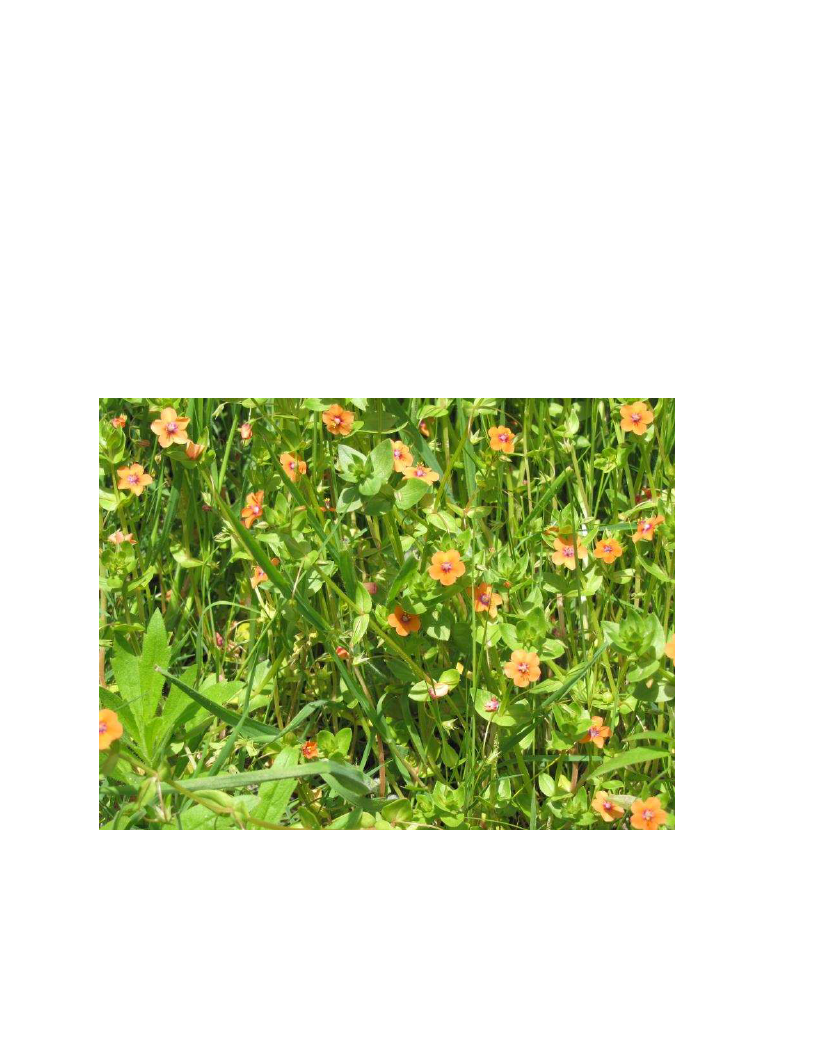
EDUCATING FOR BELONGING
116
Scarlet Pimpernel
Primrose Family
Anagallis arvensis
A guidebook explained its physical characteristics as: Low spreading annual to 1 ft. Leaves
opposite, ovate to oval, sessile. Flowers small, flat, salmon, scarlet or sometimes blue; solitary
on slender stalks from leaf axils (Foster & Hobbs, 2002, pg. 150). Non-native. Uses: Plant was
used historically for rheumatism, externally for skin ulcers. In Europe, where the plant is
originally from, it was used as a treatment for edema, epilepsy, and constipation. In India, the
plant is used as an expectorant, diaphoretic and to treat wounds. It is valued for easing mania
and other psychological conditions. Saponin glycosides from the plant inhibit herpes and the
replication of poliovirus replication and can kill intestinal worms. However this plant is TOXIC
in anything other than small doses. Poisonous to horses and dogs. (Foster & Hobbs, 2002, pg.
150). The petals fold up when skies darken before storms or at twilight, not opening again until
morning light triggers their rebloom -- hence its other common name, poor-man's weather glass.
(http://home.howstuffworks.com/scarlet-pimpernel-poor-mans-weather-glass.htm)
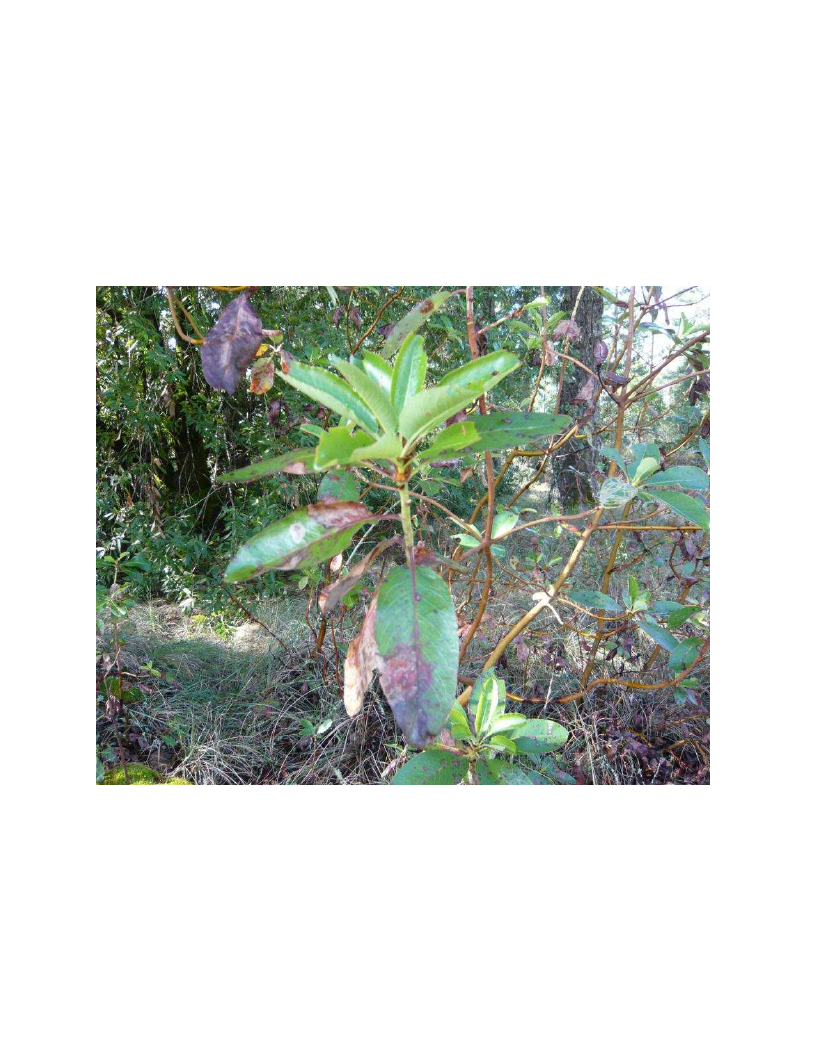
EDUCATING FOR BELONGING
117
Pacific Madrone
arbufus menziesil
The leaves of this tree are dark green, leathery, and thick. The reddish, smooth bark is thin and
peels off easily. This tree is easily identified by its red bark. Pomo used the leaves as cold
medicine using a cider they made from a mixture stirred with a hawk feather. The Miwok did
something similar and sucked the feather to create appetitie and to cure stomach trouble
(Moreman, 1998). Pomo women used flowers of the tree for love charm poisoning. Bark was
also used for strep throat. Fruit and berries were eaten fresh or roasted. Berries were dried and
stored for the winter. This tree was also an important source of firewood (Moreman, 1998, pg.
84).
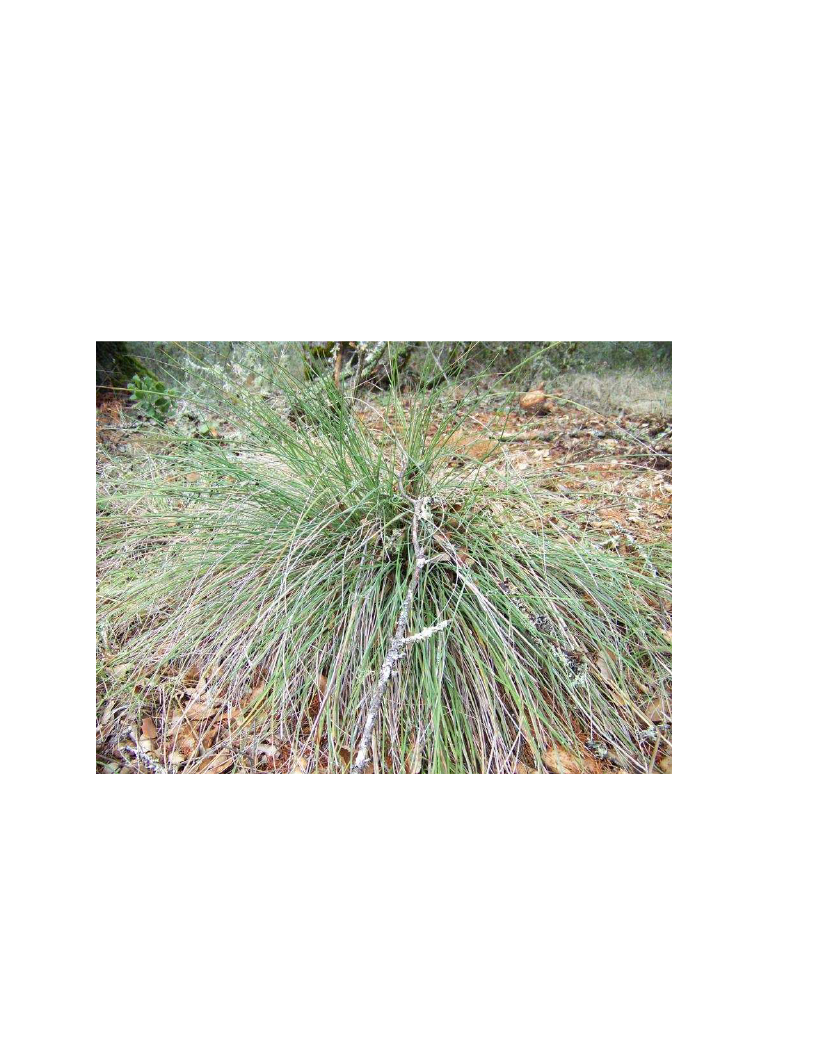
EDUCATING FOR BELONGING
118
California Fesuce
Festuca californica
This plant is a common, native, perennial grass of oak woodland ecosystems. California Fescue
is the biggest, bluest, most wonderful native grass of the area. It is common underneath
deciduous trees in un-grazed areas, but declines with grazing (Nevers, 2006).
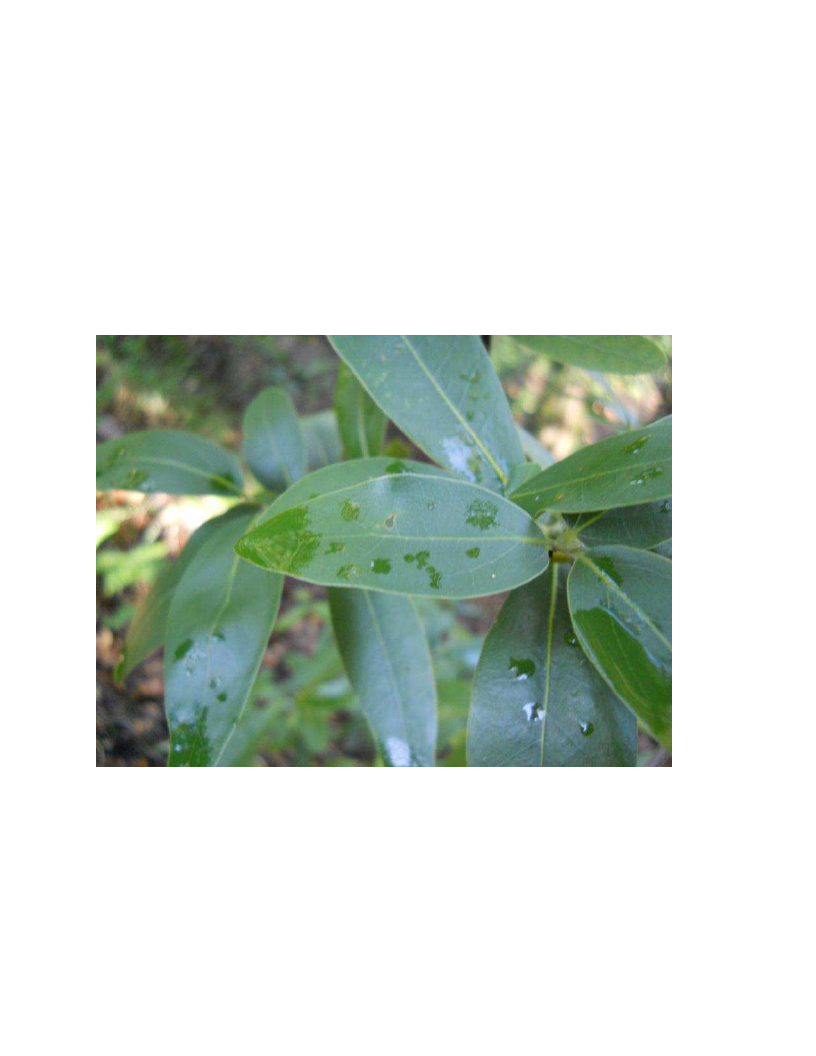
EDUCATING FOR BELONGING
119
Pepperwood, Bay Laurel
umbellularia
Pepperwood grows mainly in Coast Ranges and mountain areas in California. Its thick, leathery
leaves are shiny on top and gray-green below, and they smell when they are crushed. The
Miwoks used Pepperwood branches to build arbors and shades. The Pomo people roasted
Pepperwood nuts in ashes and ate them with fresh clover (Moerman, 1998).
References

EDUCATING FOR BELONGING
120
Alden, P., Heath, F. (1998). National Audubon Society Field Guide to California. New
York: Alfred A. Knopf, Inc.
Baker, M. A. (1981). The Ethnobotany of the Yurok, Tolowa and Karok Indians of
Northwest California. (Master’s thesis). Retrieved from:
http://herb.umd.umich.edu.
Barrett, S. A. & Gifford E. W. (1933). Miwok Material Culture. Bulletin of the Public
Museum of the City of Milwaukee 2(4),11. Retrieved from: http://herb.umd.umich.edu/.
Bocek, B. R. (1984). Ethnobotany of Costanoan Indians, California, Based on Collections by
John P. Harrington. Economic Botany 38(2), 240-255. Retrieved from:
http://herb.umd.umich.edu.
Chestnut, V. K. (1902). Plants Used by the Indians of Mendocino County, California.
Contributions from the U.S. National Herbarium 7, 295-408. Retrieved from:
http://herb.umd.umich.edu/.
Cow parsnip. (n.d.). © Encyclopedia Britannica, Inc.. Retrieved May 02, 2010, from
Dictionary.com website: http://dictionary.reference.com/browse/cow parsnip
Foster, S. & Hobbs, C. (2002). Western Medicinal Plants and Herbs. New York, NY:
Houghton Mifflin Company: New York.
Gifford, E. W. (1967). Ethnographic Notes on the Southwestern Pomo. Anthropological
Records 25, 10-15. Retrieved from: http://herb.umd.umich.edu.
Goodrich, J. & Lawson, C. (1980). Kashaya Pomo Plants. Los Angeles, CA:
American Indian Studies Center, University of California. Retrieved from:
http://herb.umd.umich.edu/herb/search.pl
Gunther, E. (1973). Ethnobotany of Western Washington. Seattle, WA: University of
Washington Press.
Johnston, V. R. (1994). California Forests and Woodlands: A natural history. Berkeley, CA:
University of California Press.
Merriam, C. H. (1966). Ethnographic Notes on California Indian Tribes. Berkeley, CA:
University of California Archaeological Research Facility. Retrieved from:
http://herb.umd.umich.edu/herb/search.pl
Morerman, D. E. (1998). Native American Ethnobotany. Portland, OR: Timber Press Inc.
Munz, P. A. (2004). Introduction to California spring wildflowers of the foothills, valleys and
coast. Berkeley, CA: University of California Press.

EDUCATING FOR BELONGING
121
Nevers, G. D. (2006). Pepperwood Flora. Santa Rosa, CA: Pepperwood Foundation.
Tilford, G. L. (1997). Edible and Medicinal Plants of the West. Missoula, MT: Mountain
Press Publishing.
Zigmond, M. L. (1981). Kawaiisu Ethnobotany. Salt Lake City, UT: University of Utah Press.
